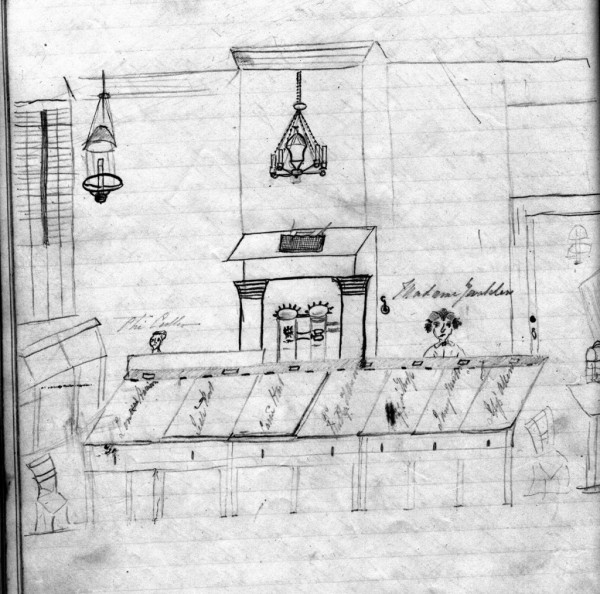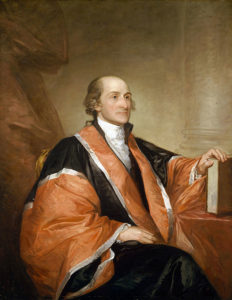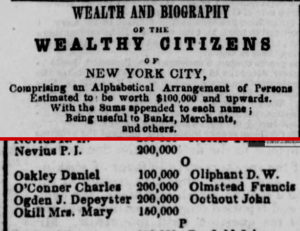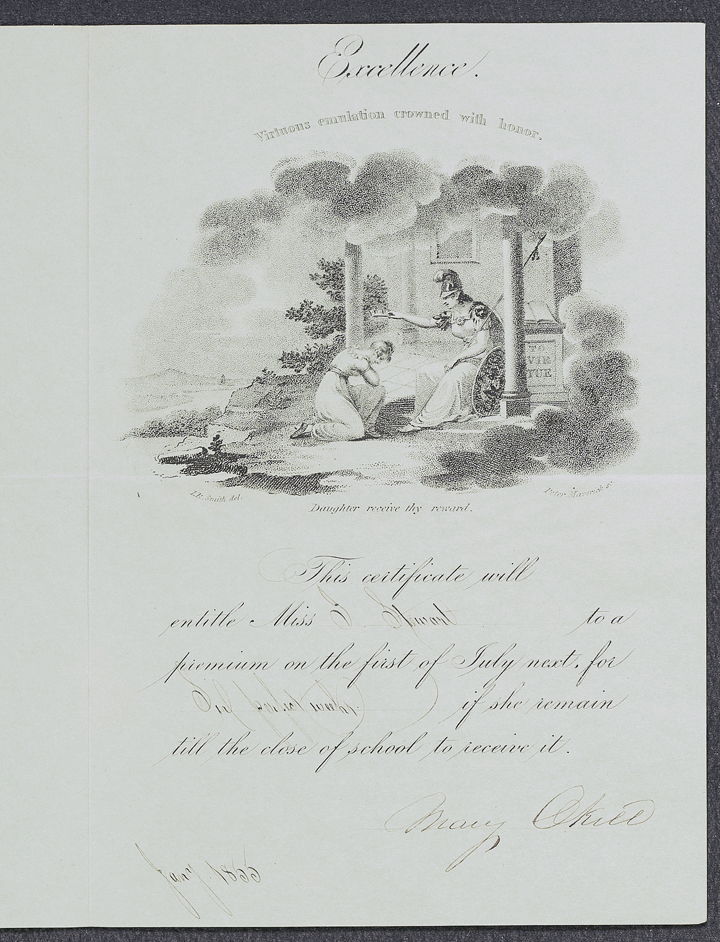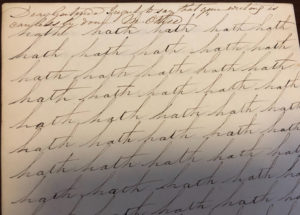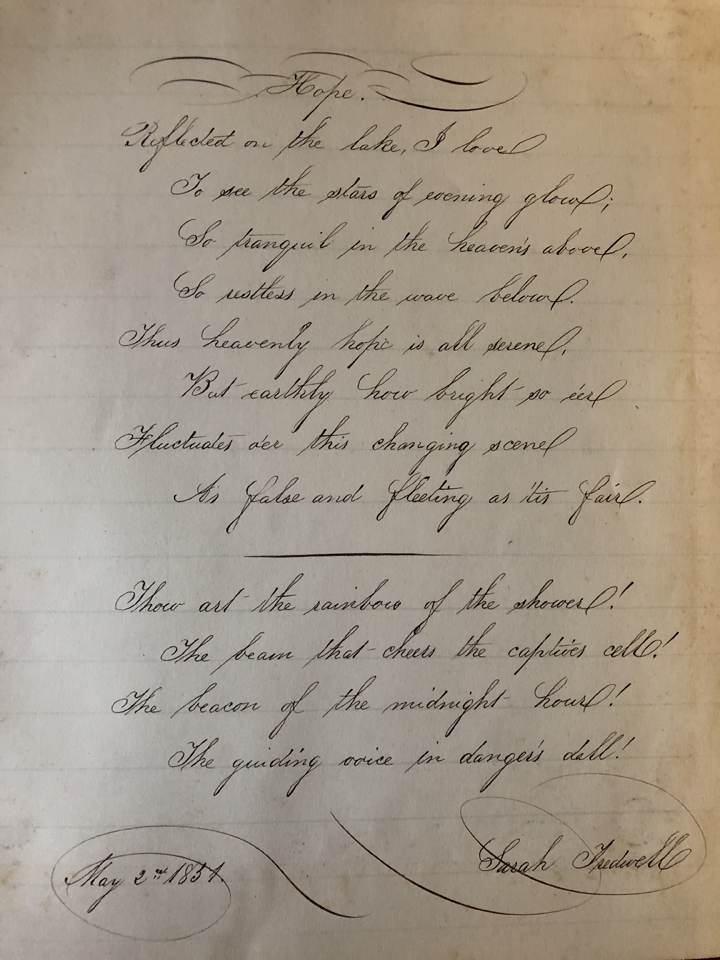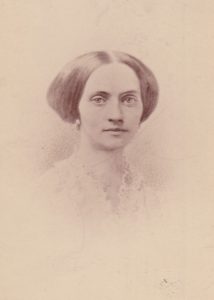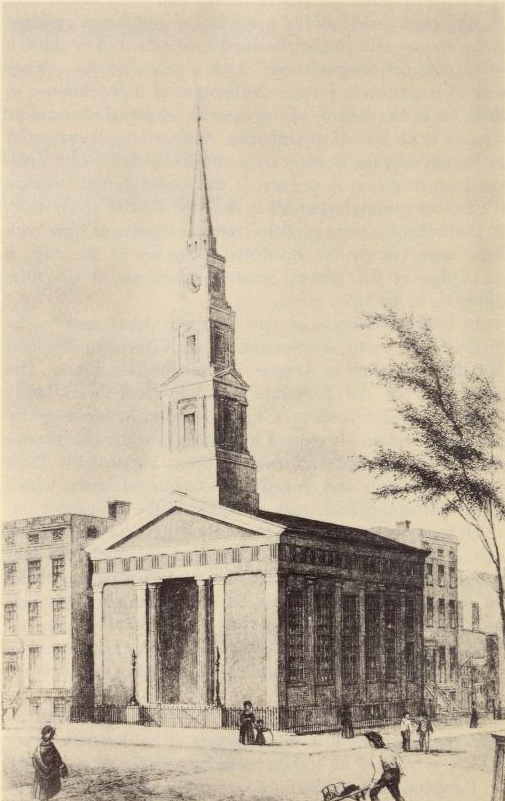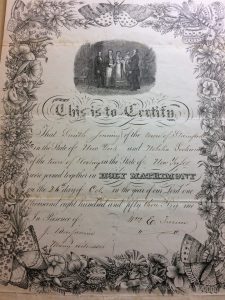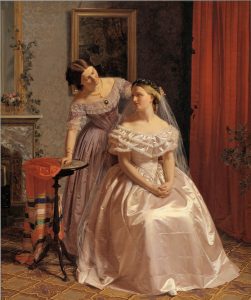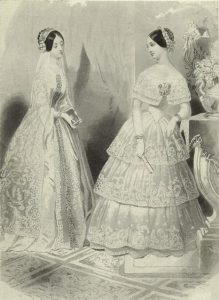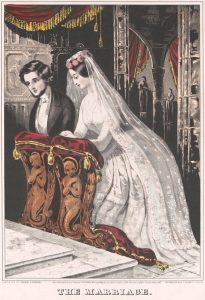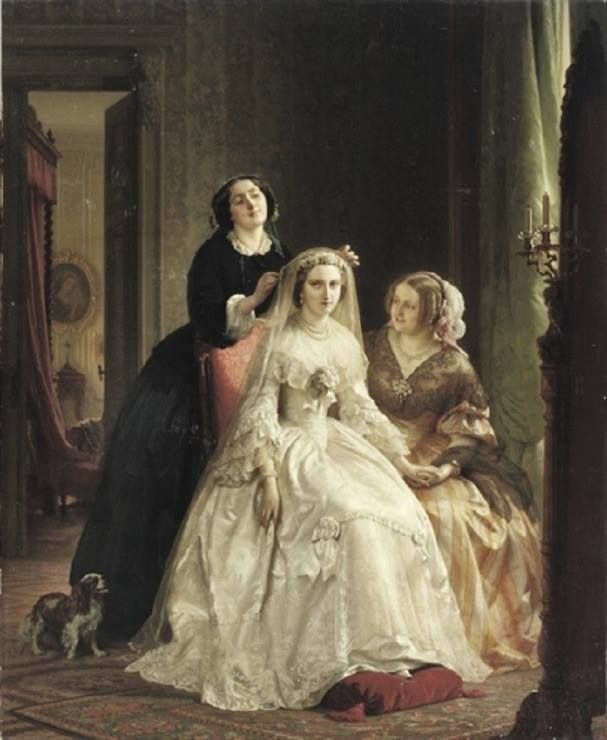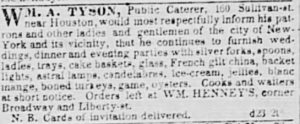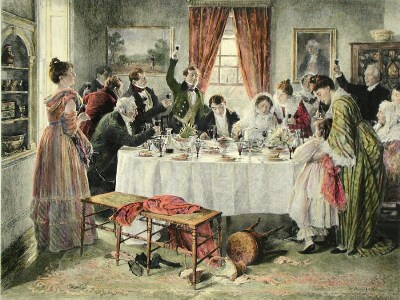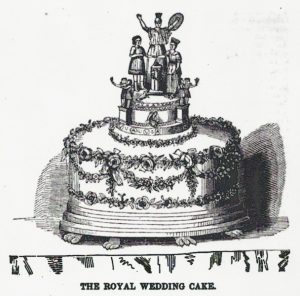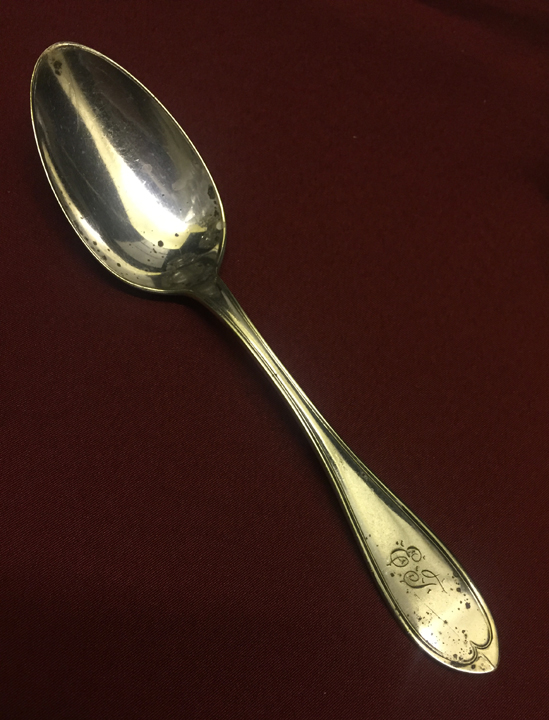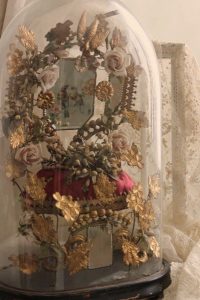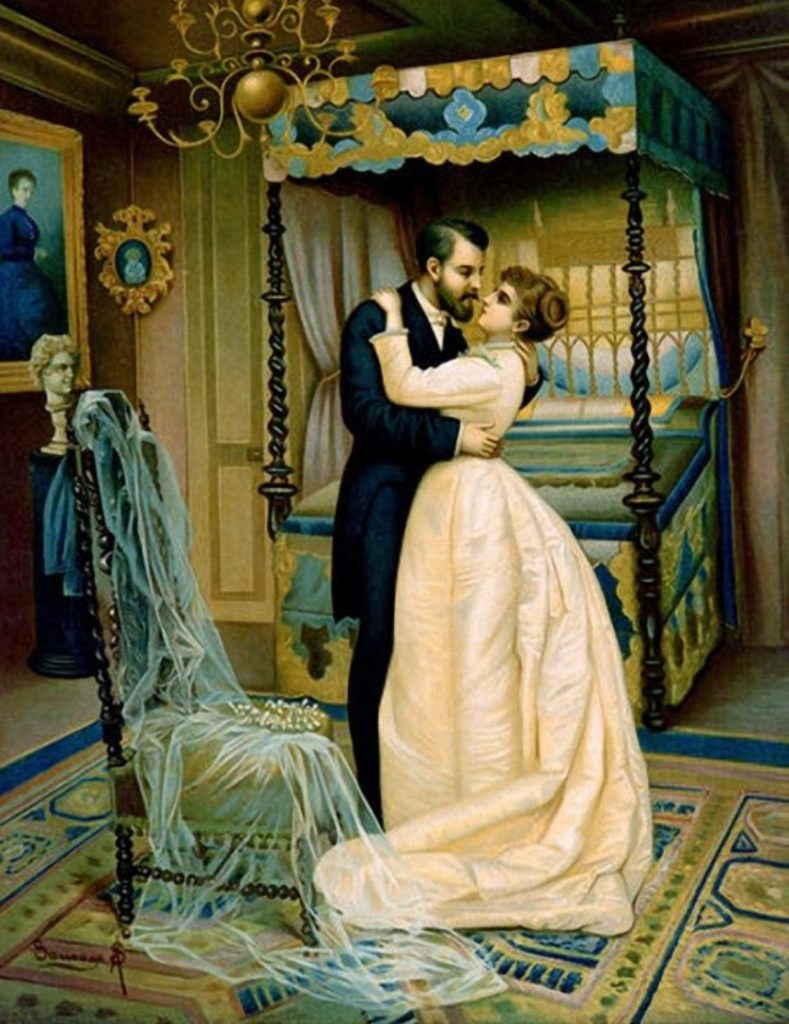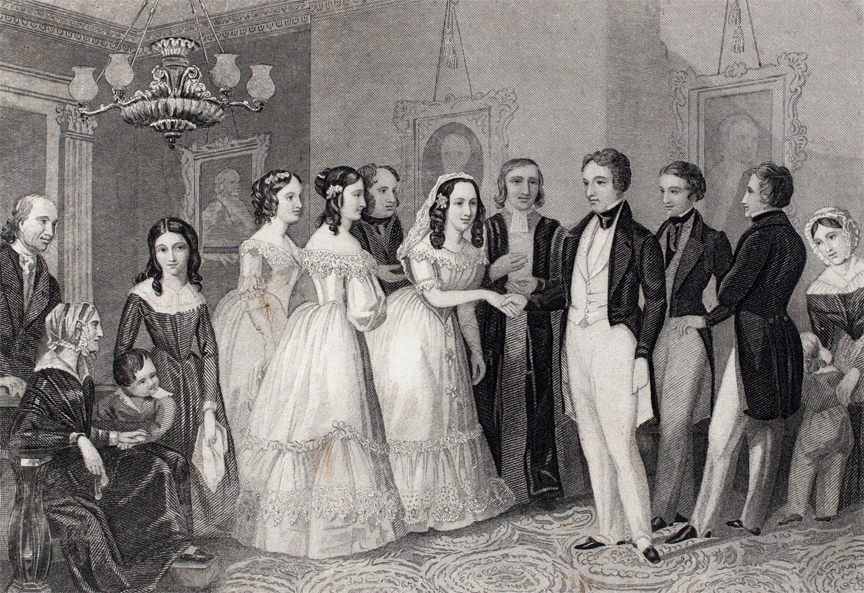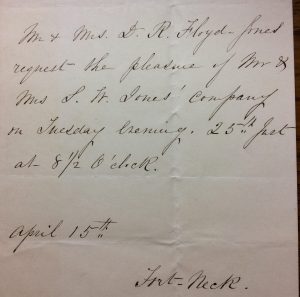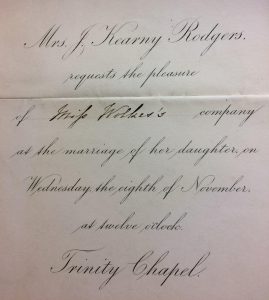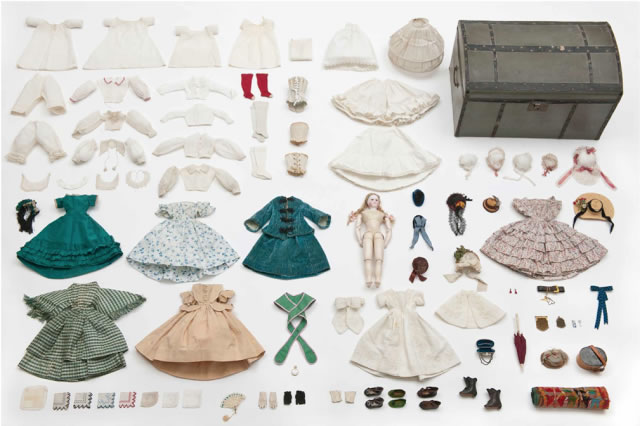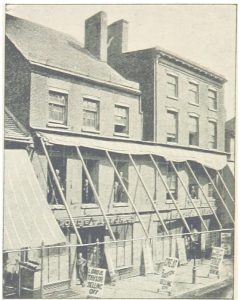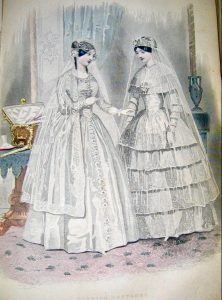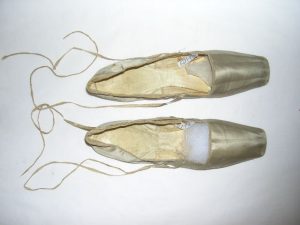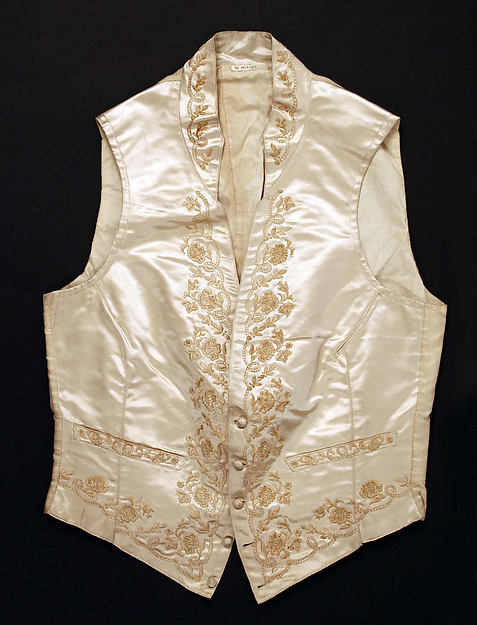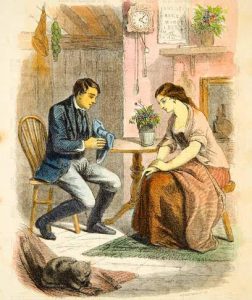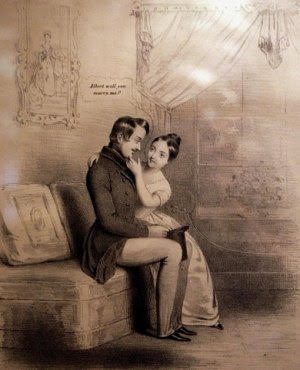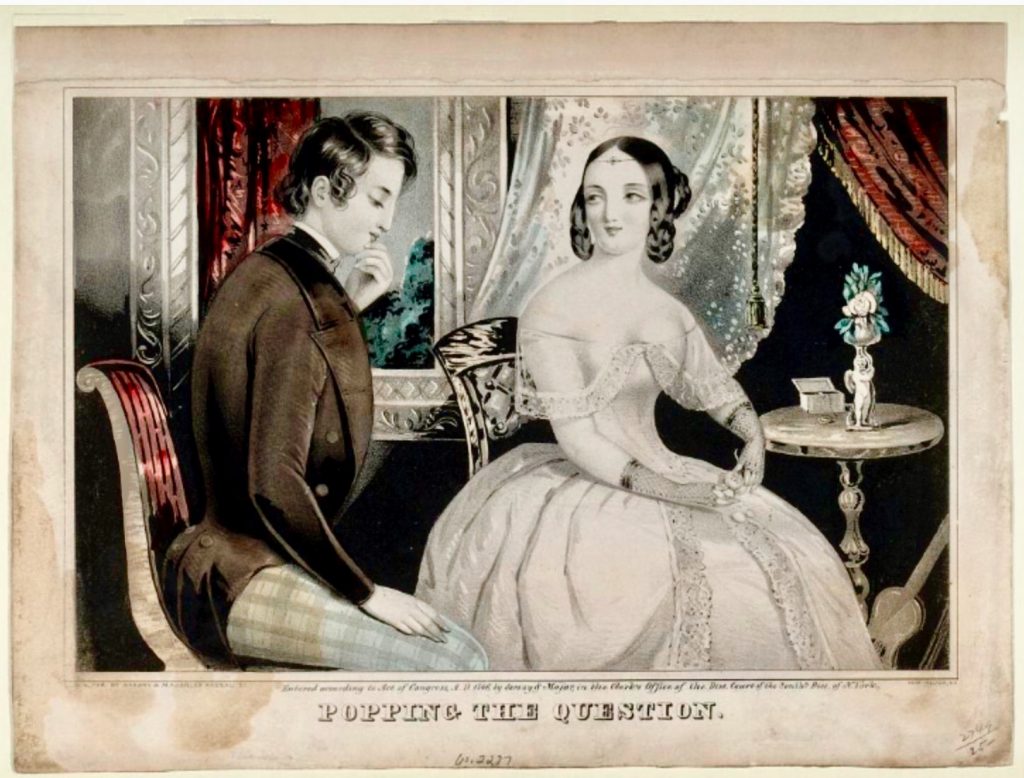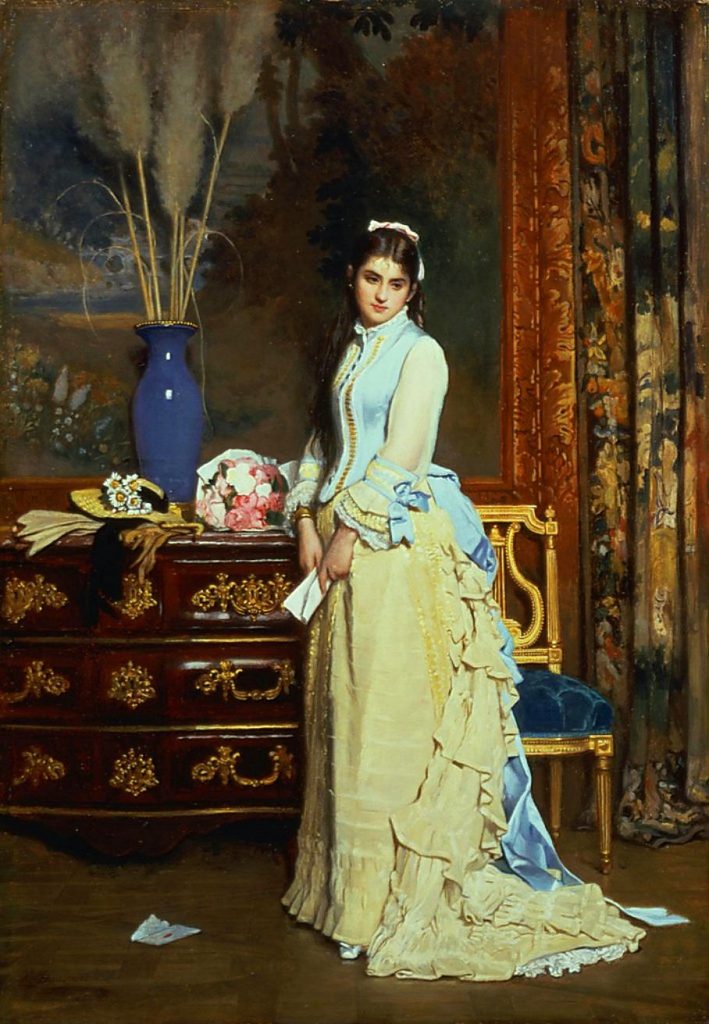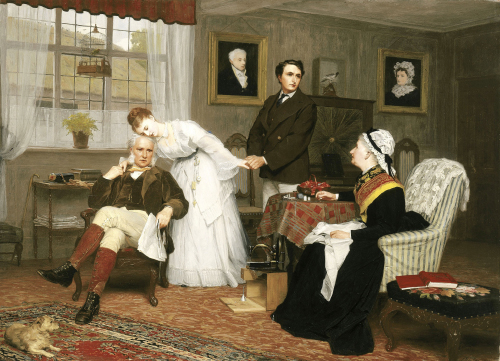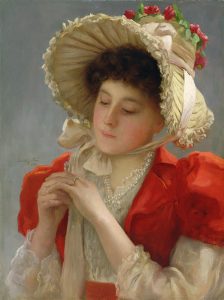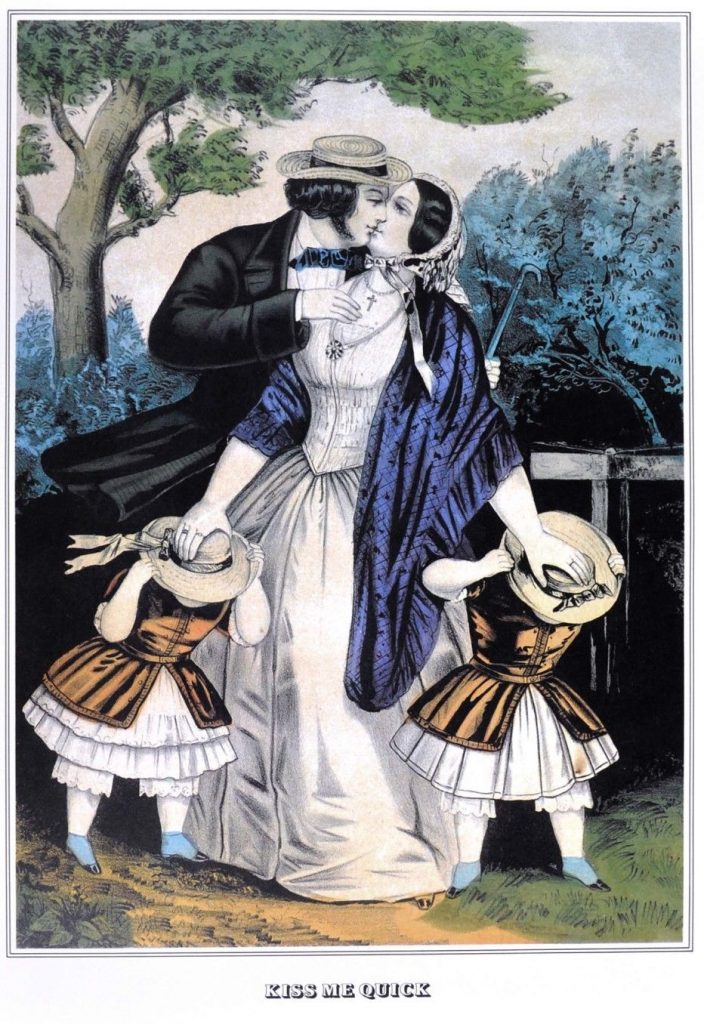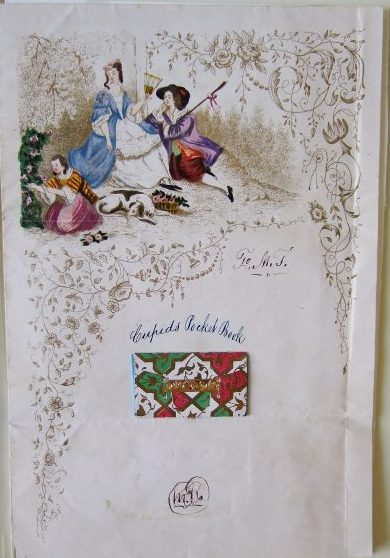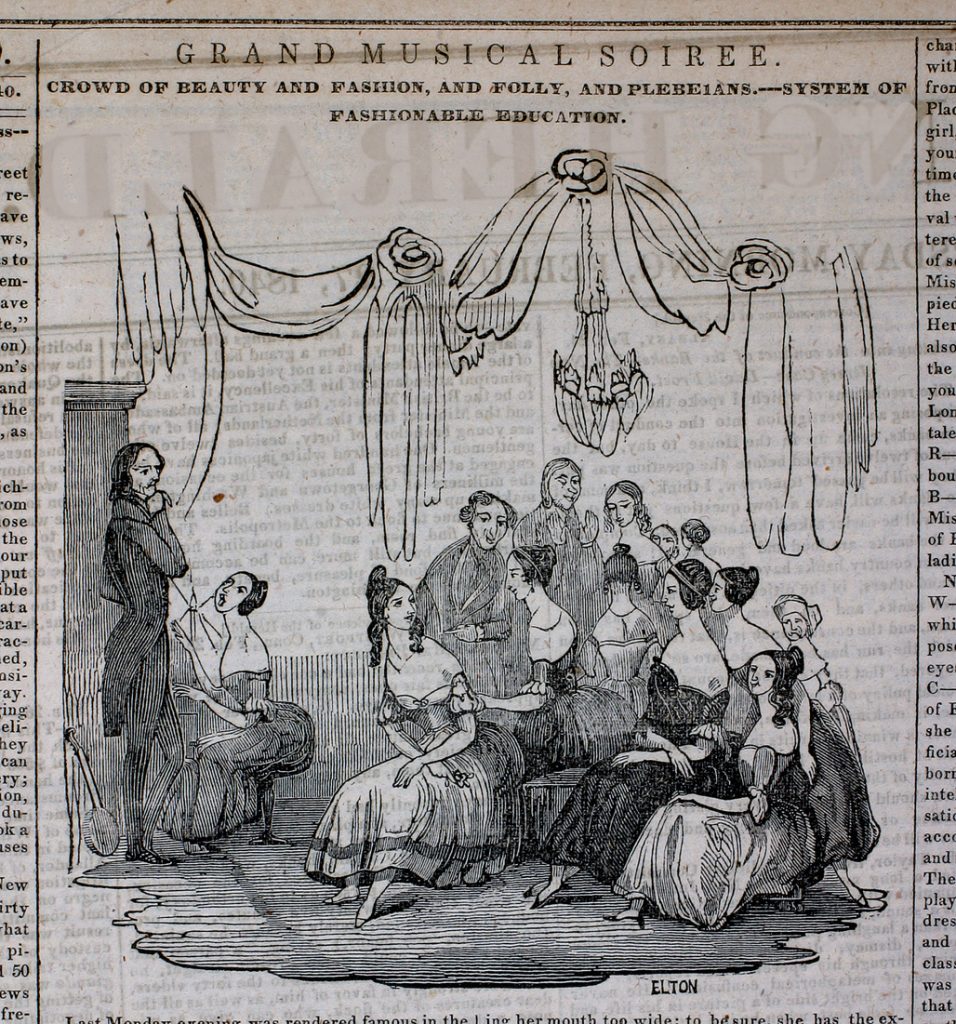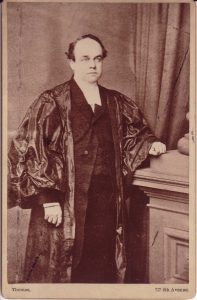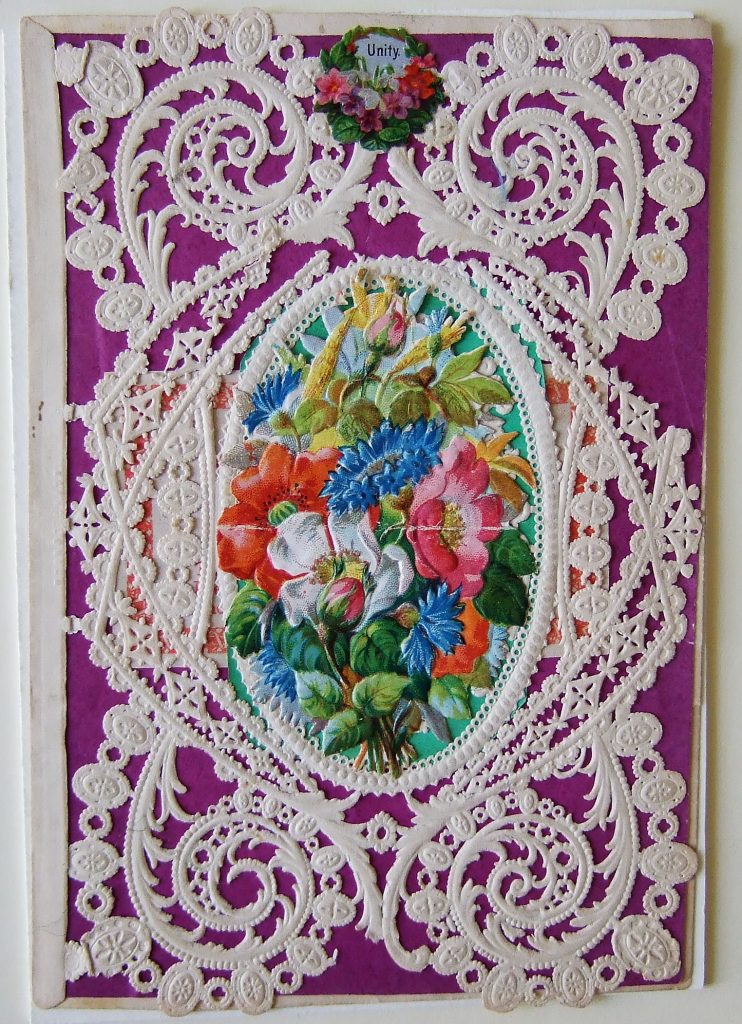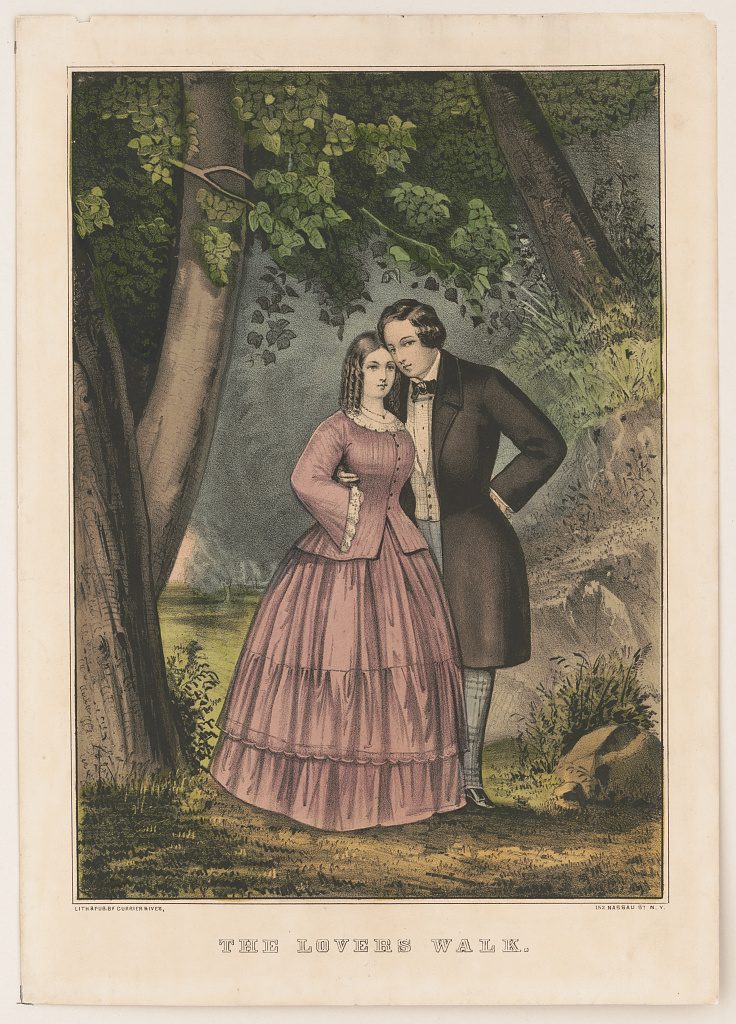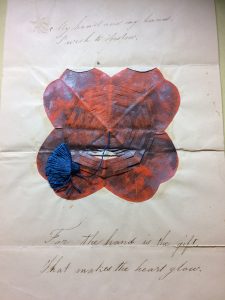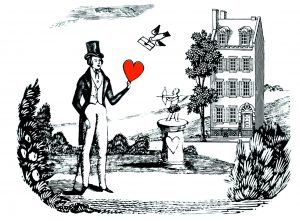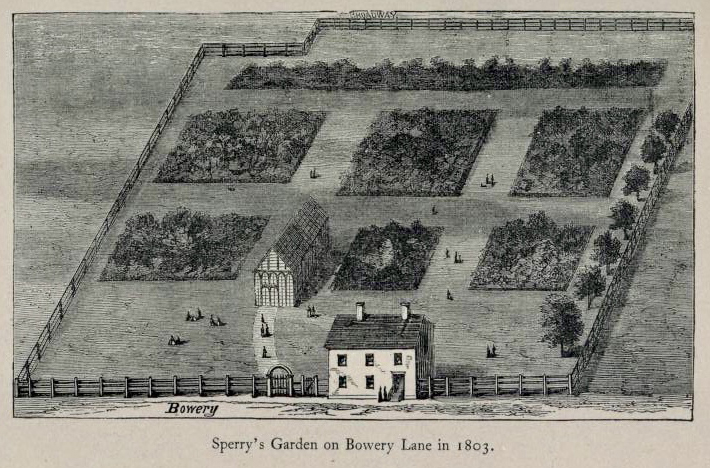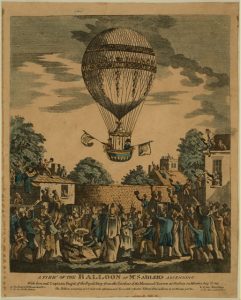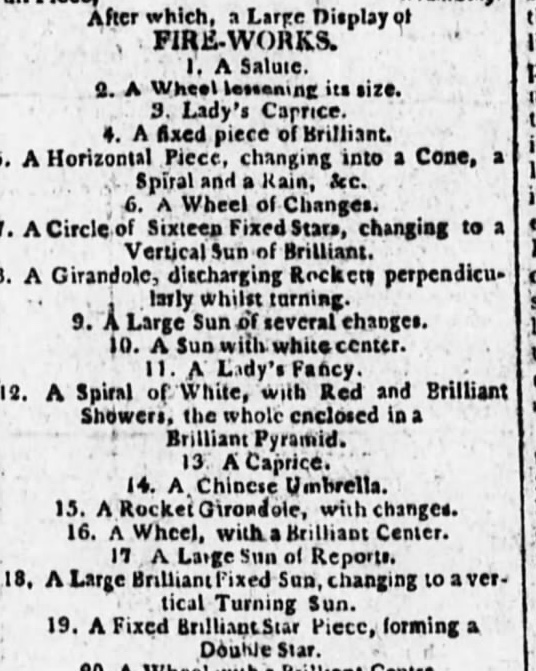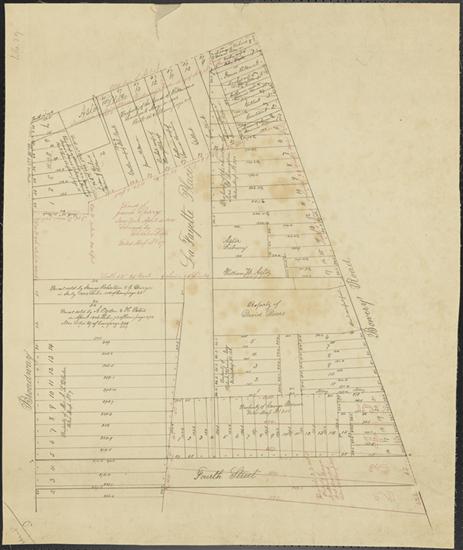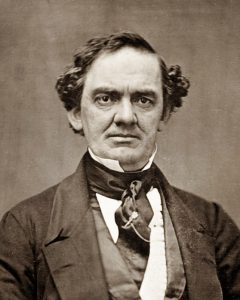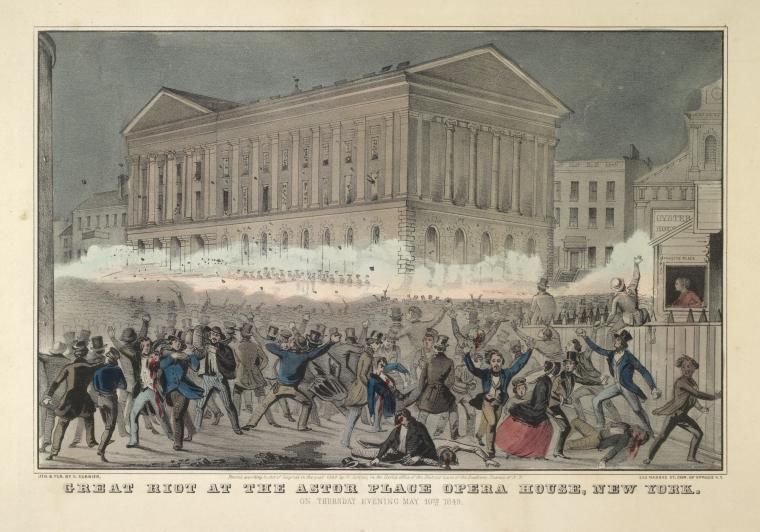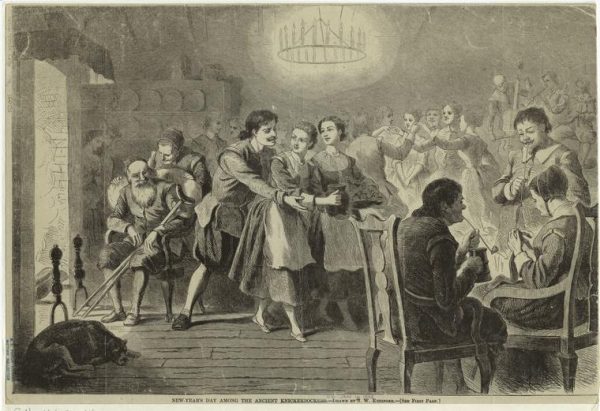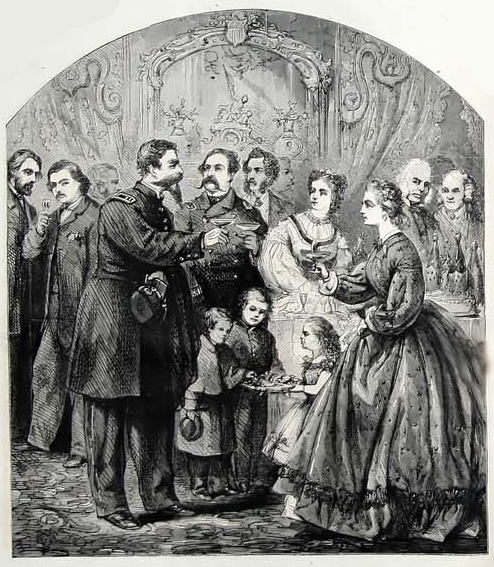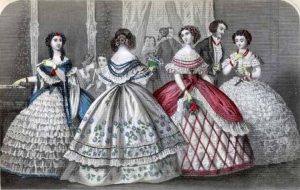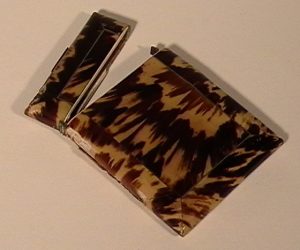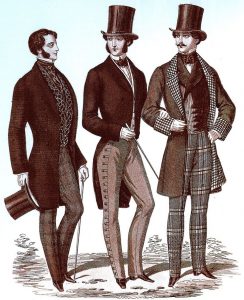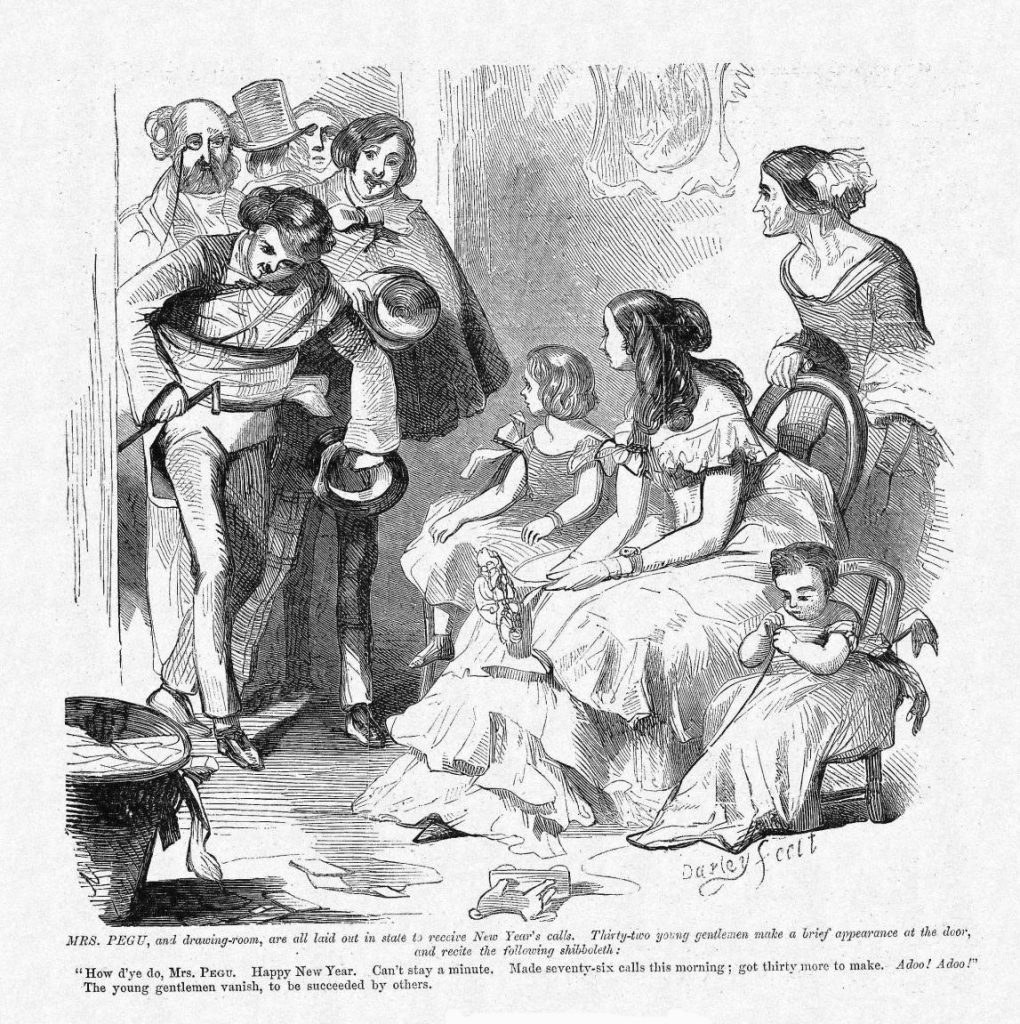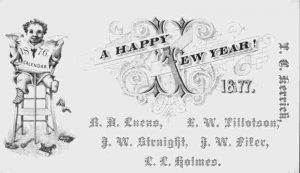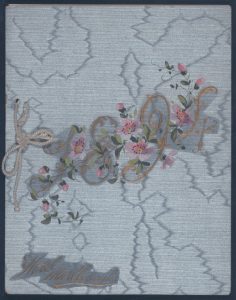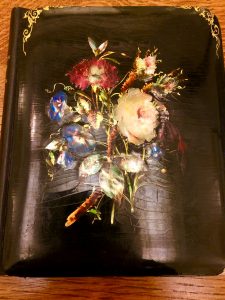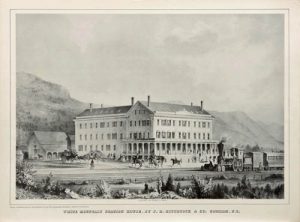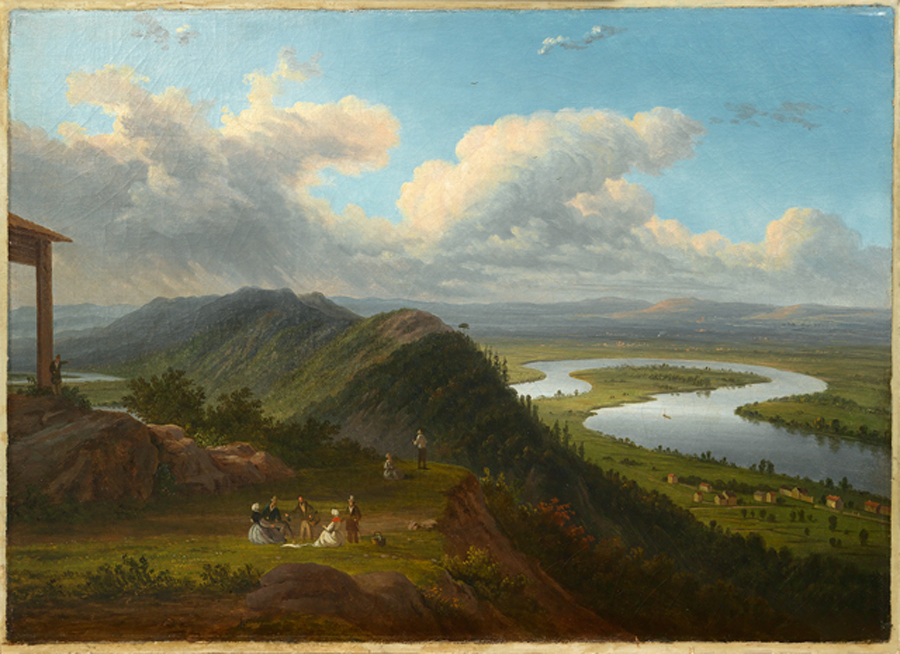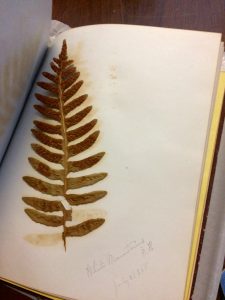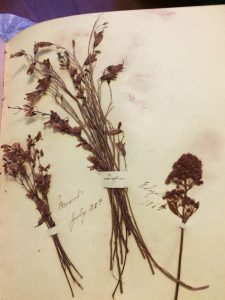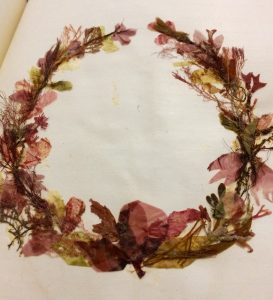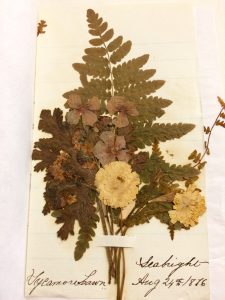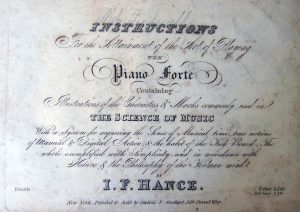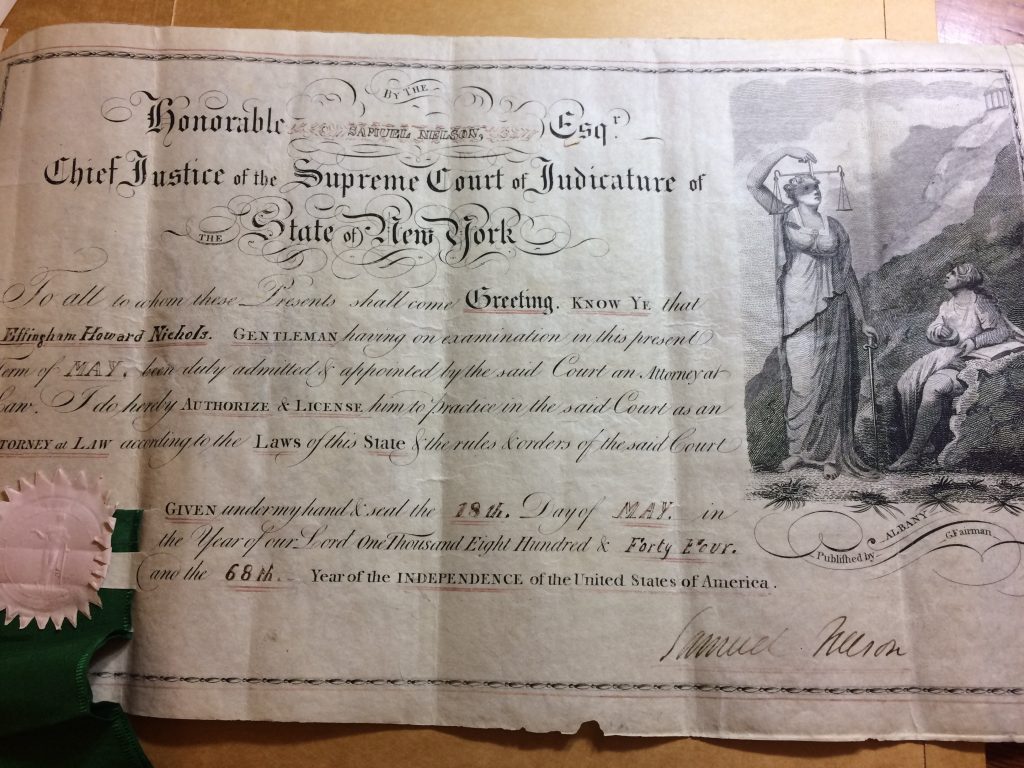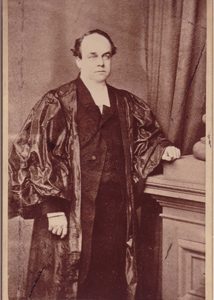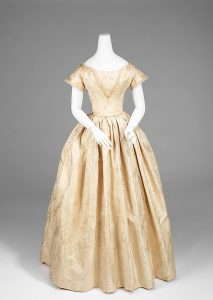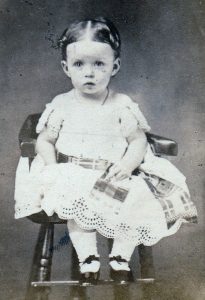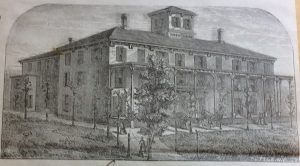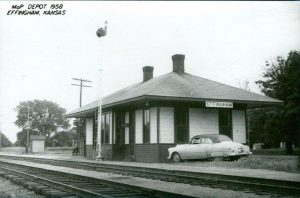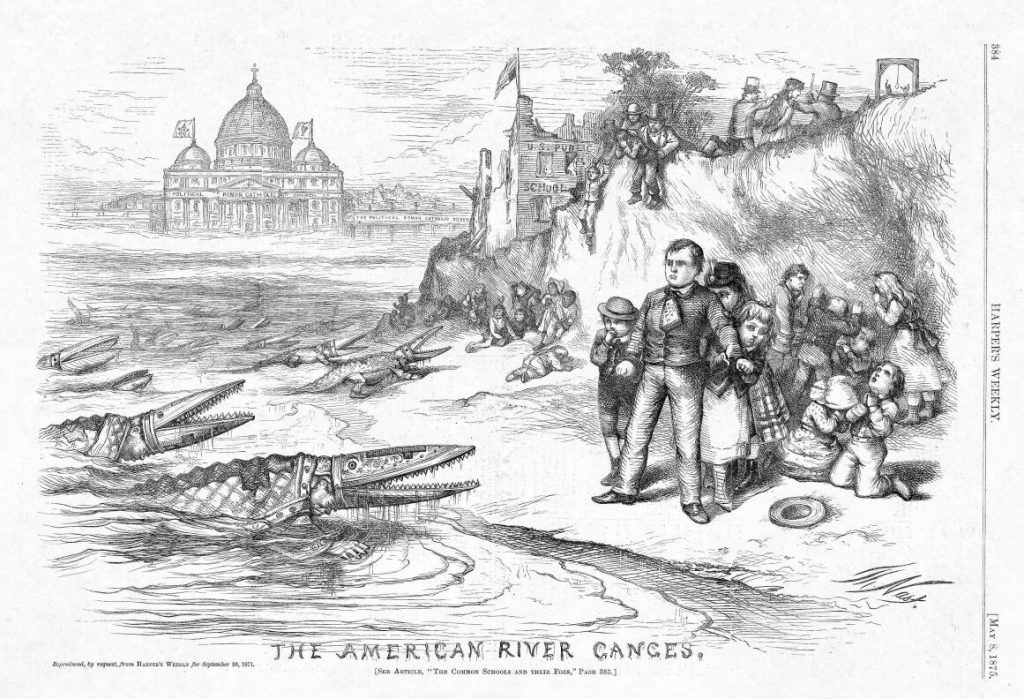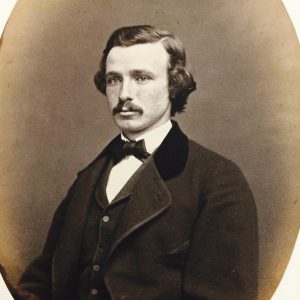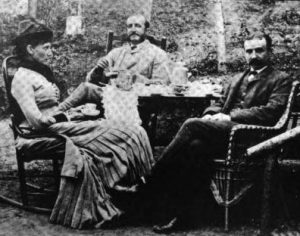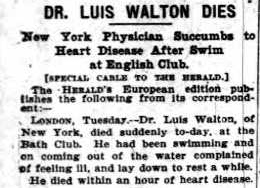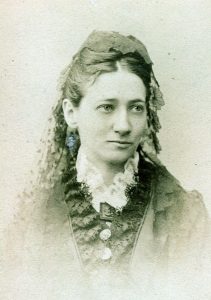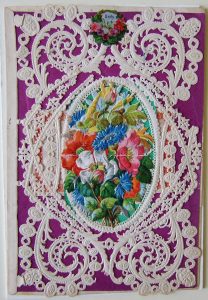Ladies of Refinement: The Women Who Educated the Tredwell Daughters
by Ann Haddad
Six Tredwell Daughters to Educate!
As the daughters of a prosperous merchant, the six Tredwell girls were granted all the privileges of the elite class in which they were raised, including a private school education. From among the many girl’s schools in New York City, Seabury and Eliza chose two of the best for their daughters – Mrs. Okill’s and Mrs. Gibson’s. [For a discussion of private school education for boys, click here to read “Samuel Tredwell’s School Days,” September, 2017.]
It would not be an exaggeration to say that Mary Jay Okill owed a debt of gratitude to the Tredwell family. Mrs. Okill (1785-1859), was the headmistress of one of the most highly regarded female academies in New York City in the Antebellum era. Seabury and Eliza Tredwell, by entrusting her with the education of all six of their daughters over a period of at least 20 years, demonstrated support for Mrs. Okill’s system of education, at a time when the wealthy and elite families of the City could choose from among many similar private institutions. The decision by the Tredwells to send their daughters to Mrs. Okill’s likely influenced other wealthy families in their circle.
The Finishing Touch Plus Morality
In the first half of the 19th century, the aim of elite female education was to provide young ladies with the social graces and manners befitting their place in society, and to instill a basic knowledge of literature, classics, arithmetic, and geography. Several schools also included instruction in the religious and moral principles that would lead to the development of virtuous, charitable, and benevolent character. This approach, which Mary Okill outlined in detail in her first advertisement for her new academy in the Christian Journal, and Literary Register (1823), certainly appealed to parents such as Seabury and Eliza Tredwell, for it would essentially “finish” their daughters by preparing them for the most important roles within their sphere: those of wife and mother. As the advertisement states:
“… while every attention will be paid to the ordinary and ornamental branches of a finished female education, the department of religious instruction will receive particular care. Mrs. Okill … will devote her time to the superintendence of her school, and to the religious principles, morals, and manners of those young ladies who may be confided to her care.”
So Many Choices!
The single-gender “academy,” copied in style and substance from the British finishing school, was extremely popular among the wealthy of New York City in the early-mid 19th century. Such schools, which occupied rented houses run by a head teacher, typically offered opportunities for both day and boarding school students; the staff, who lived at the establishment, included other teachers, cooks, and domestic servants. Teacher training and curriculum was not standardized. With time and the increasingly progressive nature of female education, the homelike atmosphere gradually transitioned to larger, more structured female academies (also called seminaries), with formally trained teachers and rigorous curriculums. [For a detailed description of what the Tredwell girls would have experienced while students at Mrs. Okill’s, see Mary Knapp’s An Old Merchant’s House: Life at Home in New York City, 1835-65 (2012)].
Mrs. Okill’s Tops the List
Competition for students must have been fierce among the women who ran the schools. Every year, beginning in late August and continuing through mid-September, advertisements for the schools, complete with names of notable individuals who were willing to provide endorsements, appeared in the daily newspapers. In New York As It Is (1833-1837), Mrs. Okill’s name is at the top of a list of 20 “Principal Female Seminaries” spread throughout the city. Ten years later, that number had grown significantly. In addition to Mrs. Okill’s, some of the other renowned female schools during this period, as mentioned by Catherine Elizabeth Havens (1839-1939), in her Diary of a Little Girl in Old New York (1919), were:
“Madame Chegaray’s, Madame Canda on Lafayette Place [both french schools], Mrs. Gibson on the east side of Union Square [more about her later], Miss Green’s on Fifth Avenue, just above Washington Square, and Spingler Institute on the west side of Union Square, just below Fifteenth Street.”
Influential Connections
When one considers that Mrs. Okill included the name of Reverend Benjamin Tredwell Onderdonk (1791-1861) as a reference in her advertisements, it is understandable that Seabury Tredwell supported the school. Onderdonk was a relative of Seabury’s, and, as Bishop of the Episcopal Diocese of New York, a highly respected clergyman (until he wasn’t: stay tuned for a future post that will discuss his 1845 downfall). Other renowned citizens of New York, including Bishop Hobart, James Bleecker, and Peter A. Jay, also endorsed her school, which served to guarantee her cachet among the upper class.
Mrs. Okill Illegitimate … and a Divorcee?
Several circumstances of Mrs. Okill’s life, however, turn her pedigree on its head, notably her illegitimate birth and her divorce.
Mary Jay Okill was the daughter of Sir James Jay (1732-1815), oldest brother of John Jay, the first Chief Justice of the Supreme Court. Sir James, known primarily as the inventor of an invisible ink used by George Washington and his spies during the American Revolution, was also a physician and member of the New York State Senate; he was knighted by King George III for his fundraising efforts on behalf of Kings’ College.
According to an article in the Newsletter of the Bergen County Historical Society (2015-16), Sir James Jay never married Mary Jay’s mother, Anne Erwin (1750-1840), although they lived together in Springfield, New Jersey. A staunch advocate of a woman’s right to education, Miss Erwin refused to “honor and obey” Sir James, and therefore no marriage took place.
Mary Jay married John Okill, a merchant, on August 13, 1807, at Saint John’s Church on Varick Street. City Directories indicate that from 1807 through 1814, the couple lived with her father at various addresses on Greenwich Street and White Street. After Sir James’ death in 1815, neither Mary nor John Okill appear in the directories until 1819, when John Okill is listed as a broker on Wall Street. This entry remains unchanged until 1823, when he disappears entirely from the directories. The date and place of his death could not be determined.
In his will, probated in 1815, Sir James Jay stipulated that his daughter Mary’s inheritance, which included nearly 1,000 acres of land in what is now Closter, New Jersey, be put in trust “free of any control of her present husband, John O’Kill [sic].” According to the aforementioned article, Mary Okill divorced her husband in order to claim her inheritance. To earn a living, and perhaps influenced by her mother’s feminist beliefs, she opened a school for young ladies. Mary Okill is first listed in the 1823-4 City Directory as the proprietor of a “boarding school,” located at 43 Barclay Street. She remained at this location until 1838, when she moved to 8-10 Clinton Place (now 8th Street). She maintained her school until her death in 1859. Her establishment was always known as Mrs. Okill’s Academy.
What a Woman!
It is remarkable that, despite the social stigma associated with illegitimacy and divorce during the 19th century, Mary Okill was able to achieve such renown, especially among the privileged class, who valued family pedigree above all else. One wonders what shielded her from disgrace? Did her wealthy patrons know of her past, and decide to simply look the other way, due to the reputation of her uncle, John Jay? Or did she somehow manage to keep her background and divorce hidden from public scrutiny? In whatever manner she managed to maintain her reputation, her school was continuously celebrated as being run by “a lady of distinction,” and was undoubtedly a huge financial success. In an article in the New York Daily Herald (January 11, 1845), Mrs. Mary Okill is one of only a handful of women included in a list of the “wealthiest citizens” of New York City, with a net worth of $150,000. She joined such wealthy men as Adam Tredwell, Seabury’s brother, whose net worth was listed at $200,000.
The Tredwell family had an indirect connection to John Jay, which may have been a factor in their loyalty to Mary Okill. Reverend Samuel Nichols, Elizabeth Tredwell’s father-in-law, who married Elizabeth and Effingham in 1845, pronounced the eulogy at the Chief Justice’s funeral in 1829. Additionally, one of Effingham’s brothers, John Jay Nichols, was his namesake.
Co-Ed for the Children
Although it was known primarily as a female school, Mrs. Okill’s Academy also welcomed very young boys as students. Julia Lawrence Hasbrouck (1809-1873), who lived on Greenwich Street, enrolled her six-year-old son Louis and her five-year-old daughter Julia in Mrs. Okill’s Academy in 1843. She wrote her positive impressions of the school in her diary on November 30, 1843:
“The room was neat, comfortable, and well arranged. The little boys all looking happy, and merry. We went from there, to the little girls room, where I was equally pleased. The little creatures are not pinned down to their seats like prisoners, pale, and wearied; but were skipping around, combining study and amusement, the only safe method of instructing children.”
Although young Julia Hasbrouck attended Mrs. Okill’s at least through 1850, her brother Louis eventually joined another brother at an all-boys school. It is possible, then, that the Tredwell girls (and perhaps boys) attended Mrs. Okill’s from a much earlier age than was previously assumed.
Notable Students
In addition to the Tredwells, Mrs. Okill’s school attracted other families that made up the glitterati of New York society.
One of Mrs. Okill’s students was Eliza Hamilton Schuyler (1811-1863), the granddaughter of Alexander Hamilton. In 1825, when she was a 14-year-old student, Eliza was given a “prize book” from Mrs. Okill. In the Hamilton-Schuyler Family Papers at the University of Michigan, there are references to “Miss Okill’s ‘Testimonials’ for Eliza on that dainty embossed note paper …” and “While Eliza Hamilton was at Mrs. Okill’s School winning her encomiums …”
Another was Isabella Stewart (1840-1924), the daughter of a wealthy merchant, who would later marry John Lowell Gardner and become a famous art collector and philanthropist. From ages 5 to 15, while living with her family at 10 University Place, Isabella attended Mrs. Okill’s Academy. In 1855 she was awarded a Certificate of Excellence by Mrs. Okill, in return for a commitment to “remain till the close of school to receive it.” One year later, Isabella embarked on the Grand Tour of Europe with her parents and was enrolled in a French school to finish her education.
After Mary Okill’s death in 1859, the school closed, but her widowed daughter, Jane Swift, who had been a teacher at the school, continued to reside there. By May 1860, when the family moved to West Point, New York, the “very valuable property” on Clinton Place was up for sale. Like Mrs. Okill herself, the buildings were considered to be “of a superior character.”
Gertrude Tredwell, the Transfer Student
Among the copybooks belonging to the Tredwell girls in the Merchant’s House Museum archives, several belonged to Gertrude Tredwell. One, dated from December 16,1853, through February 13, 1854, (when Gertrude was 13 years old), indicates that Gertrude attended Mrs. Okill’s School, for at the end of a composition, a withering comment appears, written by the headmistress herself:
“Dear Gertrude, I regret to say that your writing is carelessly done. M. Okill”
Other copybooks of Gertrude’s, which date to 1858, do not contain any teacher’s notes. The Museum’s copy of Seabury Tredwell’s ledger book includes entries for payment of bills for “Gertrude’s tuition at Mrs. Gibson’s,” dating from 1855 and 1858 (tuition at the private academies averaged approximately $70 per year). We don’t know the reason for Gertrude’s departure from Mrs. Okill’s School. Whatever the reason for the transfer, Gertrude finished her education at the age of 18, under the tutelage of Mrs. Gibson.
Mrs. Gibson
In 1832, nearly ten years after Mrs. Okill opened her female academy, Mrs. Agnes Mason Gibson (1787-1872), from Edinburgh, Scotland, established her own school, assisted by three of her daughters. Originally located on Broome Street and operating as a day school, it was advertised on April 10, 1832, in the Evening Post:
“The Misses Gibson, having been educated under the first masters, are prepared to give instruction in all the branches of a useful and ornamental female education. Pupils will be received for French, Italian, Music, or Drawing, who may not wish to enter for other branches. Instructions upon the pianoforte and guitar will also be given in private homes. [Guitar instruction was not unusual. Christian Frederick Martin, the famous guitar maker who established his shop in New York City in 1833, sold several guitars to Mrs. Okill]. A class for conversation and composition in French will be opened on Saturdays, for young ladies who have made proficiency in the language.”
A Resounding Success
Two months later, Mrs. Gibson “expanded her plan” to include boarding students. Within a few years, her school achieved a remarkable degree of popularity; Mrs. Gibson became an influential educator in New York City. Manufacturers of school supplies sought her out for endorsements. In September 1838, an advertisement in the Evening Post featured Mrs. Gibson’s endorsement of Jones’s Elementary Writing Books. Mrs. Gibson stressed the importance of having children instructed in “large hand exercises:”
“I attribute the defects in the hand writing of young ladies to injudicious teaching in giving fine-hand exercises to write, before any foundation or command of the pen is acquired in large characters.”
“An Excellent Seminary”
As the school expanded it relocated several times, from Broome Street to Broadway to 21 Bond Street (just two blocks from the Merchant’s House), where in 1845, Mrs. Gibson gave an exhibition of her students’ work, which was lauded in the New-York Tribune. The school was referred to as “an excellent seminary – one of the best in the city for the instruction of young ladies.” The article goes on to say:
“We were particularly struck with the taste and judgment displayed in the elocutionary exercises. The French dialogues were given in a sprightly and graceful manner, and the vocal music was charming. We traced throughout the evening the workings of an intelligent, kindly, and well sustained course of instruction.”
The New York Post also covered Mrs. Gibson’s May Day Festival in May 1849:
“Of note were the performances of charades, in which the ingenuity and invention of the youthful scholars were exhibited. Many of the former pupils were present. It is charming thus to see wisdom’s ways made ways of pleasantness.”
The Dear Scottish Daughters
One of Mrs. Gibson’s students was Julia Cullen Bryant (1831-1907), daughter of poet and New York Evening Post editor William Cullen Bryant (1794-1878), who attended the school in 1844 at age 13. The family must have formed a strong attachment to Mrs. Gibson and her daughters, for William Bryant maintained a correspondence with his daughter’s teachers, Christianna Gibson in particular, until his death.
The Final Move
In 1851, Mrs. Gibson moved again, from 21 Bond Street to larger quarters at 38 Union Place, to accommodate her growing enrollment. Gertrude attended the school at this location, which was a short walk from her home on Fourth Street. The school operated at this location at least until 1861; eventually, Mrs. Gibson returned to Scotland with her daughters, where she died in 1872.
“An Annoyance and a Pleasure”
Despite the number of filled copybooks belonging to the Tredwell girls, all but one lacked any clues about the young women’s sentiments toward their schools. Only 18-year-old Sarah was brave enough to venture an opinion about her school years and the education she received. In a composition entitled “To a Dear Friend,” dated May 18, 1853, she expressed her ambivalence about her experiences and the end of her school days:
“Some say our school days are the most happy. I believe it to be true though there are certainly many things pertaining to school which are of a very perplexing nature. I will leave school the first of July, when I am to leave forever that place which I have frequented so many years and which has been to me both an annoyance and a pleasure. To those to whom I have grown and with whom I have shared the troubles of a school day life and to whom I must ever feel attached I must bid adieu but I hope not forever.”
Sources:
- Brown, Henry Collins. Valentine’s Manuel of Old New York, new series, no. 2. New York: Valentine Co., 1917.
- Bryant, William Cullen and Thomas G. Voss. The Letters of William Cullen Bryant: Volume IV, 1858-1864. New York: Fordham University Press, 1993.
- Christian Journal, and Literary Register, Volume 7-8, May, 1823. https://books.google.com. Accessed 9/9/18.
- Colony Club. Catalogue Exhibition “Old New York” Relics Documents and Souvenirs. New York: Colony Club, 1917.
- Evening Post. 25 August, 1824, p. 3. www.newspapers.com. Accessed 6/5/18.
- Evening Post. 10 April, 1832, p. 4. www.newspapers.com. Accessed 8/24/18.
- Evening Post. 13 June, 1832, p. 3. www.newspapers.com. Accessed 8/24/18.
- Evening Post. 10 September, 1833, p. 3. www.newspapers.com. Accessed 6/6/18.
- Evening Post. 22 August, 1834, p. 3. www.newspapers.com. Accessed 8/24/18.
- Evening Post. 13 January 1838, p. 4. www.newspapers.com. Accessed 6/6/18.
- Evening Post. 1 September, 1838, p. 4. www.newspapers.com. Accessed 8/24/18.
- Evening Post. 30 August, 1847, p. 3. www.newspapers.com. Accessed 9/8/18.
- Evening Post. 3 May, 1849, p. 2. www.newspapers.com. Accessed 9/8/18.
- Evening Post. 14 April, 1851, p. 2. www.newspapers.com. Accessed 9/8/18.
- Gura, Peter F. C.F. Martin & His Guitars, 1796-1873. Chapel Hill: University of North Carolina Press, 2003.
- Hamilton-Schuyler Family Papers 1820-1924, William L. Clements Library Manuscript Division, University of Michigan. http://quod.lib.umich.edu. Email 9/6/18.
-
Hayley, Ann, Robert Campbell et al. The Isabella Stewart Gardner Museum: Daring by Design. New York: Skira Rizzoli, 2014.
- Knapp, Mary L. An Old Merchant’s House: Life at Home in New York City, 1835-65. New York: Girandole Books, 2012.
- Leslie’s History of the Greater New York. www.ancestry.com. Accessed 8/22/18.
- Longworth’s American Almanac, New-York register, and city directory. New York: David Longworth, [multiple years]. Reference, New York Historical Society.
- Madigan, Jennifer C. “The Education of Girls and Women in the United States: A Historical Perspective.” Advances in Gender and Education, 1 (2009), 11-13. www.mcrcad.org. Accessed 9/2/18.
- Manhattan, New York City, New York Directory: 1829-1830;1839-1840. www.ancestry.com. Accessed 8/22/18.
- Merchants House Museum Archives. Seabury Tredwell’s Ledger Book [copy], 1855-1865.
- Merchant’s House Museum Archives. Composition Book of Sarah Tredwell, May 18, 1853. 2002.4601.89.
- Merchants House Museum Archives. Penmanship book of Gertrude Tredwell, Dec. 16th, 1853 – Feb. 13th, 1854. 2002.4602.29.
- New York County, New York, Wills and Probates, 1658-1880. www.ancestry.com. Accessed 8/22/18.
- New York Evening Post. 22 Dec 1859. www.ancestry.com. Accessed 8/22/18.
- New York Evening Post. 27 June 1839. www.ancestry.com. Accessed 8/22/18.
- New York Daily Herald. 11 January 1845, p. 1. www.newspapers.com. Accessed 6/6/18.
- New York Daily Herald. 26 February, 1856, p. 5. www.newspapers.com. Accessed 9/8/18.
- New York Herald. 9 August, 1922, p. 11. www.newspapers.com. Accessed 7/22/18.
- New York Times. 20 September, 1859, p. 6. www.newspapers.com. Accessed 6/5/18.
- New York Times. 15 May, 1860, p. 6. www.newspapers.com. Accessed 6/6/18.
- New-York Tribune. 30 December, 1845, p. 2. www.newspapers.com. Accessed 9/8/18.
- Stessin, Susan. The Diaries of Julia Lawrence Hasbrouck. www.frommypenandpower.wordpress.com. Accessed 8/22/18.
- Williams, Edwin, ed. New York As It Is, [1833-1837]. New York: J. Disturnell, 1833-1837.
- Wilson, James Grant, ed. The Memorial History of the City of New-York, Vol. III. New York: New-York History Company, 1893. https://books.google.com. Accessed 9/5/18.
- Wright, Kevin. “Elizabeth Cady Stanton in Tenafly.” In Bergen’s Attic: Newsletter of the Bergen County Historical Society. Fall/Winter, 2015-2016, p. 7-14. www.bergencountyhistory.org. Accessed 9/11/18.
“A Scene of Radiant Joy:” The Wedding of Elizabeth Tredwell & Effingham Nichols
by Ann Haddad
This is the fourth and final of a series of blog posts on mid-19th century courtship and wedding customs. Click for Part One, on 19th century courtship; Part Two, on marriage proposals and engagements; and Part Three, on wedding preparations.
A “Royal” Wedding in Old New York City
The recent marriage of Prince Harry, the younger grandson of Queen Elizabeth, and Meghan Markle, an American actress, caused a stir both in England and in America. Even those who scoff at the notion of monarchy may have been entranced by the pomp and spectacle surrounding the “Royal Wedding,” finding it to be both thrilling and heartwarming.
In 19th century New York City, there was a flourishing royalty of a sort, led by the “merchant princes,” whose success in business and resulting wealth endowed them with economic and social power. Seabury Tredwell was one such wealthy merchant, and the marriage of his eldest daughter, Elizabeth, to Effingham Nichols, on April 9, 1845, could also be considered a ‘“royal” event, for it united two established families who occupied prominent positions among the aristocratic elite of New York society.
Why April?
Why did Elizabeth choose an April wedding, and on a Wednesday? Spring was always a popular time for nuptials; perhaps Effingham’s work as an attorney eased up a bit in April. Or perhaps Elizabeth was familiar with the old adage:
“Marry in April when you can,
Joy for Maiden and for Man.”
Tuesdays, Wednesdays or Thursdays were usually chosen for a wedding, likely because the clergyman was frequently occupied with his regular pastoral duties on the weekend.
Church or Parlor?
In 1845, American wedding practices were on the cusp of great change. Weddings were evolving from simple, intimate family affairs to elaborate public events, rich in tradition and ritual. We have no surviving records that describe the Tredwell and Nichols union. The only certainty is the date of their wedding and the officiant, the Reverend Samuel Nichols, father of the groom. (Coincidentally, the Reverend James Milnor, who officiated at Seabury and Eliza’s wedding on June 13, 1820, at St. George’s Chapel, died on April 8, 1845, the day before Elizabeth’s wedding.)
Elizabeth and Effingham’s marriage announcement, published on Friday, April 11, in the New York Evening Post, did not mention a church wedding, so chances are that the couple were wed in the elaborate Greek Revival double parlor of the Tredwell home on Fourth Street.
.
.
If the couple had been married in church, it most likely took place at St. Bartholomew’s, then located at Great Jones Street and Lafayette Place, one block away from the Tredwells’ home. In the mid-19th century, there was a growing trend away from small weddings held in the bride’s family parlor, in favor of a church wedding. A church’s large public space accommodated more guests. If Elizabeth and Effingham had been married at St. Bartholomew’s instead of at home, the Tredwells might have chosen a church setting for this reason; or because of the close ties both families had with St. Bartholomew’s. Effingham Howard Warner, the groom’s uncle and namesake, was one of its founders, and the Tredwells had worshiped there since its consecration in October 1836, one year after their move to the elite Bond Street neighborhood.
Your Hosts: Mr. and Mrs. Tredwell
Whatever location was chosen for the wedding ceremony, there was never any choice as to the venue for the reception: custom dictated that it be hosted and paid for by the bride and her parents at their home. As Elizabeth was the first of their children to marry, Seabury and Eliza likely seized the opportunity to display their wealth, refinement, and sophistication, both for their children’s benefit (five unmarried daughters were still at home), and to impress their guests.
Set and Lighting Design for the Performance
In preparation for Elizabeth’s marriage, the entire Tredwell house must have been turned upside down, for although the grand double parlor was the main stage for the action, the entire house required cleaning from top to bottom; everyone, especially the Tredwells’ four servants, was engaged in this task. New furnishings may have been purchased; and, to show the home to its best advantage, additional lighting may have been rented for the occasion. The house was elaborately decorated with an abundance of white flowers that covered nearly every surface, possibly ordered from Dunlap & Carman, located at 635 Broadway, near Bleecker Street. Musical entertainment, ranging from a soloist at the pianoforte to a quartet, may have been arranged; and dancing was common at evening wedding receptions.
In a diary entry from Wednesday, February 19, 1845, Mrs. Abiel Abbot Low described the process of readying a house for a wedding reception:
“Mr. Nevers made preparations for lighting the house. This afternoon he is having a chandelier with four burners in each parlor, four solar lamps at the folding doors, and two candelabras for five candles each, on either side of the mirrors. Abbot bought a handsome brussels carpet for the tearoom, and a handsome sideboard, as a pleasant surprise for me. Borrowed a few pieces from our friends, including a full length mirror for the ladies’ dressing room.”
Mary Harris Lester summed up the whirlwind of activity surrounding the house preparations when she hurriedly wrote in her diary on Monday, December 15, 1847, just several days before her wedding:
“Mother went with me today to order things for next Monday evening, have a great deal to attend to at present.”
License Not Required
In 1845, the only available record that provided proof of marriage was the bridal certificate, issued by the church where the wedding was held, or, in the case of home weddings, obtained by the clergyman from his own parish church. Prior to 1847, no marriages were recorded by any cities or towns in New York State. Wedding announcements were traditionally published in local newspapers within several days of the event.
Dressing the Bride
The Art of Good Behavior (1845) states unequivocally that “it is the duty of the bridesmaids to assist in dressing the bride.” On Elizabeth’s wedding day, she was almost certainly assisted by her sisters Mary (then age 20) and Phebe (age 16). They most likely dressed in one of the bedrooms on the third floor. After dressing themselves in their own simple white dresses, the sisters helped Elizabeth into her wedding dress; tied up her silk or satin slippers; affixed her lace or net veil with a wreath of orange blossoms, as was the fashion (being careful not to disturb Elizabeth’s hair, which had been dressed at home by a hairdresser); put on her gloves; and, when all else was in readiness, hand her a white leather prayer book or embroidered handkerchief to carry.
Toasting the Groom
The Etiquette of Courtship and Matrimony (1852) states the essential requirements of the groomsmen: “Young and unmarried they must be, handsome they should be, good humored they cannot fail to be, and well dressed they ought to be.”
It was customary for the groom, after dressing at home, to meet his groomsmen at the home of his future wife. Upon arriving at another third floor bedroom in the Tredwell house, Effingham may have found his friends gathered around a punch bowl, ready to toast him with a tumbler or two, and to make sure that he, too, enjoyed a nip of “liquid courage.”
The chief groomsman also needed to be certain that the wedding ring, wrapped in silver paper, was securely placed into the groom’s waistcoat prior to the ceremony. Among his other duties was to greet the clergyman upon his arrival and introduce him to the family and friends who gathered in the parlor to witness the ceremony. It is at this time that he obtained the certificate of marriage from the clergyman, to present to the groom after the reception.
Here Come the Bride and Groom!
Once a servant announced to the gentlemen that the ladies were ready, the men joined their partners in the hallway, and, arm in arm, with the bridal pair bringing up the rear, descended the staircase to the parlors on the first floor, where the invited guests were waiting. Even if Elizabeth had been married in church, her father, Seabury, most likely did not escort her; contemporary diaries of this period indicate that the bride and groom simply took their place before the altar. It wasn’t until the mid-late 19th century and the prevalence of church weddings that the ritual of the father “giving away his daughter” became commonplace.
Upon entering the front parlor, the bridal party positioned themselves in a semicircle facing the guests, who were either seated or standing, depending on the number attending. The bride stood to the right of the groom, and was flanked on her right by her bridesmaids; the groomsmen stood to the left of the groom. The clergyman then proceeded with the ceremony, taken from The Book of Common Prayer; vows were exchanged; then the groom removed from his waistcoat pocket the plain gold wedding ring (perhaps engraved with their initials and the wedding date) and placed it on the fourth finger of the bride’s left hand.
Mrs. Nichols
Once the nuptials were completed and Effingham kissed his bride, the clergyman addressed Elizabeth for the first time by her newly acquired name, “Mrs. Nichols.” The newlyweds were congratulated first by Seabury and Eliza, then Effingham’s parents, followed by family and friends, who were escorted to the couple by the chief groomsman.
After all the congratulations had been offered, the bridal party was free to mingle with the guests.
At some point after the ceremony, it was the responsibility of the chief groomsman to quietly thank and compensate the clergyman for his services. The sum was determined by the financial ability and generosity of the groom.
Henry Patterson wrote in his diary of his wedding, which took place on Thursday, July 18, 1844:
“Thursday [the wedding day] I spent at my usual business until four o’clock, [note that he worked as usual on his wedding day!] then went home and dressed. ….went to Mrs. Wright’s at 7 o’clock. From then until a quarter after eight the company was assembling and preparations going forward then all being ready, Ophelia acting as bridesmaid and Turner as groomsman, we walked into the room, and were immediately married by Mr. Hatfield. The ceremony was short, but impressive, and suited us both. After receiving the congratulations of our friends who were present, the evening was passed with conversation, a little music, and by eleven o’clock all had dispersed.”
And on December 27, 1855, Edward Tailer wrote sweetly in his diary of his wedding to Agnes Suffern, and of the moment when he first heard his wife addressed by her married name:
“The Dr. read the service in an impressive manner and occasionally a tear could be seen trickling down the face of those who loved us both, and who had our interests at heart, but a few moments sufficed to proclaim us to be man and wife, and it was not until I heard our mutual friends calling Agnes “Mrs. Tailer,” that I could realize that any change had taken place or that new responsibilities have been assumed by me. It was a pleasant affair, and all appeared to enjoy themselves, about 110 persons being present. Numerous were the congratulations of our friends and if all the kind wishes which were expressed within my hearing could only be realized, I shall be a very happy man.”
Eat, Drink, and Faint!
Guests to a home wedding were usually invited for 8 p.m. Other than the requirement that the wedding reception be held at the bride’s parent’s home, there were no hard and fast rules about the number of guests, the type of reception, or the entertainment. Upon arriving at the Tredwell home, guests proceeded directly up to the second floor, where Seabury and Eliza’s bedroom had been turned into “dressing rooms,” for guests to fix their hair, adjust their gowns, or polish their boots, assisted by one or two servants. They then went down to the front parlor, where Mr. and Mrs. Tredwell greeted them as for any sociable.
Depending on the size of the guest list, Mrs. Tredwell may have elected to have the wedding buffet feast catered, perhaps by William A. Tyson (see advertisement of December 24, 1846), who, in addition to preparing the food, provided equipment, servers and cooks to assist with the reception. The lavish “wedding supper,” which was typically served at 11 p.m., consisted of oysters, cold meats, fish, fruits, and various confections. Beverages included lemonade, punch, wine, and champagne. The table was usually set up in the rear parlor and the overflow of the many guests spilled into the halls and tea room. Imagine the scene of the Tredwell front hall, tearoom, and both parlors crowded with guests trying to reach the supper table!
Mrs. Abiel Abbot Low wrote in her diary Sunday, February 2, 1845, of one parlor wedding she attended:
“I should judge there were more than three hundred present during the evening. I never was at so crowded company before. There was a band of music and some dancing during the evening. Supper was announced at 11 o’clock and a most bountiful and elegant repast it was, but such crowding in a supper room I never witnessed before. The drawing room was so warm at one time, and the air so perfumed with the profusion of flowers that several of the ladies fainted. We returned home between 12 and 1 o’clock.”
John Hadden, a young man who lived at 20 Lafayette Place, right around the corner from the Tredwells, could have been describing the Tredwell home when he wrote of a lively and somewhat chaotic wedding reception he attended on Tuesday, January 17, 1843:
“It was a very pleasant party. The whole house was open. The two drawing rooms for dancing, and on the back stoop which was enclosed a small room [like the Tredwell tea room] with a little refreshment, punch and lemonade with cake, the piazza having a couch where the bride sat and received the company. The second story back room for the ladies, the front room for the gents. As usual at most crowded parties the company went to the supper room about 3/4 of an hour before things were ready and we had to stand until everything was in order. Before this was accomplished Mr. Wright took up a bottle of champagne from the table and was about to open it, one of the waiters told him the table was not ready yet, but he took it out of the supper room with him and opened it somewhere else.”
For those of lesser financial means, a simple menu of wedding cake, wine, and lemonade was customary. Usually within two hours after the reception commenced, the bride quietly left the festivities and, escorted by her attendants, retired to her bedroom. There they helped her undress and perform her “night toilette.” According to The Art of Good Behavior (1845): “The groom retires without ceremony or notice.” According to contemporary diaries, guests typically lingered until anywhere between 11 p.m. and 2 a.m.
Let Them Eat Cake
Until the mid-1850s, when tiered cakes became popular, the bridal cake was usually of a single layer, and typically consisted of a rich, dark fruitcake covered in almond paste and a hard, white sugar icing. It was either baked at home or, as was probably the case with Elizabeth’s cake, ordered from one of the many confectioners in the city that prepared fancy desserts, such as James Tompson’s Premium Bakery, located at 40 Lispenard Street.
The cake, usually decorated simply with fresh flowers, was placed on a rectangular table covered with a white cloth. When the cake was ready to be cut, Elizabeth and Effingham sat in front of it, surrounded by their bridesmaids and groomsmen, who stood at either side, while their parents took their places at either end. The rector stood opposite the bride and groom. Champagne was usually served, then the chief groomsman offered a toast to the newly married couple, and to the health of the parents of the bride. The bride then cut the cake (sometimes with a special saw, as the cake was typically too thick and hard to cut with a regular knife!), which her bridesmaids, assisted by the servants, distributed to the guests.
Wedding Favors for Dreaming
It was customary for the bride and groom to give away tiny boxes of wedding cake to guests. These slices were cut from a second cake baked specifically for this purpose before the wedding. Many stationers, such as Stouts, located at the corner of Broadway and Maiden Lane, advertised special cake boxes, as in this ad from December 21, 1848: “elegant boxes for cake at $8 per hundred.” Mary Harris Lester wrote on the eve of her wedding on December 18, 1847, “… house all in order quite busy all evening in tying up boxes of cake.”
The evening before the wedding, the bridesmaids helped the future bride to ready the cake boxes, which were distributed to the guests upon their departure from the reception.
It was important for newlyweds to let their friends and acquaintances know when they would commence receiving well-wishers at their home upon returning from their bridal tour. A new “at home” card was made expressly for this purpose; it was attached to the wedding cake boxes as a convenience for the guests. Stout’s wedding cards were advertised as “elegantly engraved and printed…”
Etiquette and fashion experts stressed that a woman may not distribute a card bearing her married name until after she utters her marital vows. As stated in the New York Evening Mirror on November 14, 1844: “It is tampering with serious things, very dangerously, to circulate the three words ‘Mrs. John Smith,’one minute before the putting on of the irrevocable ring. The first proper use of the wedded name is to send it with parcels of wedding cake … to friends and persons desired as visiting acquaintances.”
Elizabeth and Effingham’s “at home” card may have been written as:
Mr. and Mrs. Effingham Nichols
at home
on the morning of Tuesday, Wednesday,
Thursday, and Friday next,
from 12 till 4.
361 Fourth St.
A popular tradition surrounding the boxed wedding cake called for an unmarried lady to sleep with the cake beneath her pillow on the night of the wedding. As a result her dreams would be “sweetened,” and she would be granted a vision of her future husband.
Wedding Gifts
At the time of Elizabeth and Effingham’s marriage, wedding gifts were usually bestowed only by the immediate family and very close friends of the couple. They were never of a practical nature (giving such gifts would be perceived as an insult, for it would imply need on the part of the receiver); in fact, they usually denoted a personal relationship with the bride and were often handmade. Typical gifts included shawls, clocks, fancy fans, richly ornamented thimbles, pictures, gold pencils, and gift books. Two popular books were The Bridal Keepsake, by Mrs. Coleman (1846), a collection of writings on religious and moral themes, and Austin’s Voice to the Married (1848), advertised as “The Best Bridal Gift.”
As the century progressed, it became more common to receive wedding gifts from relatives and friends. By the late-19th century, gift-giving became so profuse (a custom frequently renounced by preachers, etiquette manuals, and Godey’s Lady’s Book) that among the elite, special areas of the future bride’s home were set up to display the items; the bride-to-be would offer visiting hours to show off her silver and other acquisitions, which silently announced that her future prosperity was assured.
Silverware was always a gift to the bride, and thus was always engraved with the bride’s maiden name or initials; Elizabeth’s silver thus bears the mark “E.T.”
The “Bridal Cushion”
One popular wedding gift offered for sale by fancy dry-goods stores in the 1840s was the “bridal cushion.” Known as a Globe de Mariee in France, where the custom originated, it consisted of a tufted velvet cushion, usually red in color, that sat under a glass dome or globe decorated with gilt metal flora and fauna, as well as little mirrors. It was used to convey the love and hope brought to a marriage through meaningful objects accumulated by the couple throughout their lives. The bride would nestle her wedding mementos on the cushion; over the years she would add significant objects to the display. The cushion occupied pride of place in the Victorian parlor. Guests shopping for a bridal cushion for Elizabeth may have patronized Woodworth’s, located at 325 Broadway. In an advertisement on November 2, 1841, the shop offered “a new and beautiful collection of French Fancy Articles…which have been selected with great care by our tasteful agents in Paris.”
The Bridal Tour
The post-wedding trip, or bridal tour, taken by couples was an imitation of a ritual begun in 19th century England. Typically lasting one to two weeks, the journey served to as a means by which the pair traveled to visit friends and family who could not attend the wedding ceremony. Fashionable spots included Philadelphia, Washington D.C., as well as Niagara Falls and other natural wonders that were not too far from home. Overseas trips were largely unheard of. Couples were often accompanied by relatives or close friends. In the late 19th century the bridal tour became an exclusive, private trip for the newlyweds, and evolved into what we know of today as the traditional honeymoon.
Make Room for the Groom
As Charles Bristed mentioned in The Upper Ten Thousand: Sketches of American Society (1852): “It is the invariable custom that the young couple shall reside with the bride’s father for the first four or six months.”
Judging by the contemporary diaries of the period, very little advance preparation or thought was given to the groom’s move into his wife’s family home. In fact, like so many of the other wedding customs at this time, it was all rather last minute. On December 26, 1855, the day before his wedding, Edward Tailer wrote in his diary: “Mother assisted me in packing my trunk, and I am to send it over to Mr. Suffern’s [his father-in-law] after dark.”
And Henry Patterson wrote in his diary on July 21, 1844: “Wednesday forenoon [the day before the wedding] I sent my furniture, clothing, etc. to Mrs. Wright’s.
Bristed provided a hilarious description of the items his fictional groom brought to his bride’s home (earlier on the day of his wedding!):
“… seven coats and twelve pairs of trousers, and about thirty waistcoats, no end of linen, and carpet-bags full of boots, a gorgeous dressing-gown, and Turkish slippers, and smoking cap, and cigars numerous, and all sorts of paraphernalia generally, until the little dressing room adjoining the nuptial chamber is overflowing with foppery.”
Gaining A Son
After returning from their bridal tour, Effingham and Elizabeth took up residence in the Tredwell home on Fourth Street, and, in a decided departure from tradition, remained there for eleven years! (For a description of their married life, see the blog post of April 2017 “Days of Sorrow, Days of Rejoicing). Once settled at home, they commenced receiving congratulatory wedding calls from friends and acquaintances. In keeping with the custom of the time, Elizabeth may have worn her wedding dress, without the veil, for these visits.
Love’s Devotion
As Elizabeth and Effingham enter into the “divine” institution of marriage, let us imagine a lovely scene similar to the one described in the following poem, “Eras of Life: Marriage,” by Mrs. A.F. Law, which appeared in the January 1851 issue of Godey’s Lady’s Book:
“One sacred oath hath tied
Our loves; one destiny our life shall guide;
Nor wild nor deep our common way divide!
Ushered thus, we haste to enter on a scene of radiant joy—
List’ning vows in ardor plighted, which alone can death destroy.
Passing fair the bride appeareth, in her robes of snowy white,
While the veil around her streameth, like a silvery halo’s light;
And amid her hair’s rich braidings rests the pearly orange bough,
With its fragrant blossoms pressing on her pure, unclouded brow.
Love’s devotion yields the future with young Hope’s resplendent beam;
And her spirit thrills with rapture, yielding to its blissful dream!”
Sources:
- Abell, L.G. Woman in Her Various Relations: Containing Practical Rules for American Families. New York: J.M. Fairchild & Co., 1855.
- Allen, Emily. “Culinary Exhibition: Victorian Wedding Cakes and Royal Spectacle.” Victorian Studies Vol. 45, No. 3 (Spring 2003), pp. 457-484. http://www.jstor.org/stable/3830185.
- Anonymous. The Art of Good Behavior, and Letter Writer, on Love, Courtship, and Marriage: A Complete Guide. New York: Huestis & Cozans, 1845. Main Collection, New-York Historical Society.
- Anonymous. The Etiquette of Courtship and Matrimony. London: David Bogue, 1852. books.google.com. Accessed 1/18/18.
- Brooklyn Daily Eagle. Tuesday, November 2, 1841, p. 1. www.newspapers.com. Accessed 3/16/18.
- Bristed, Charles Astor. The Upper Ten Thousand; Sketches of American Society. London: John W. Parker and Son, 1852. www.babel.hathitrust.org. Accessed 2/13/18.
- The Evening Post. Friday, April 11, 1845, p. 3. www.newspapers.com. Accessed 4/9/18.
- The Evening Post. Thursday, December 21, 1848, p. 2. www.newspapers.com. Accessed 2/19/18.
- Godey’s Lady’s Book. Volume 42: January, 1851. www.hathitrust.org. Accessed 3/18/18.
- Hadden, John. Diary, 1841-1843. Rare Books and Manuscripts Division, New York Public Library.
- Lester, Mary H. Diary, 1847-1849. Manuscripts Division, New-York Historical Society.
- Low, Harriet. Diary, 1844-45, Low Family Papers, 1750-1900. Manuscripts Division, New-York Historical Society.
- New York Daily Herald. Tuesday, March 26, 1844, p. 4. www.newspapers.com. Accessed 4/6/18.
- New York Evening Mirror in the Buffalo Daily Gazette. Thursday, November 14, 1844, p. 2. www.newspapers.com. Accessed 2/19/18.
- New York Tribune. Thursday, December 24, 1846, p. 1. www.newspapers.com. Accessed 4/4/18.
- O’Neil, Patrick W. Tying the Knots: The Nationalization of Wedding Rituals in Antebellum America. Dissertation Thesis, University of North Carolina, Chapel Hill, 2009. www.cdr.lib.unc.edu. Accessed 3/15/18.
- Patterson, Henry. Diaries, 1832-1848. Manuscripts Division, New-York Historical Society.
- Rothman, Ellen K. Hands and Hearts: A History of Courtship in America. Cambridge: Harvard University Press, 1987.
- Tailer, Edward Neufville. Diaries, 1848-1917. Manuscripts Division, New-York Historical Society.
- Thornwell, Emily. The Lady’s Guide to Perfect Gentility: In Manners, Dress, and Conversation. New York: Derby & Jackson, 1856. www.archive.org. Accessed 1/17/18.
- Wallace, Carol McD. All Dressed in White: The Irresistible Rise of The American Wedding. New York: Penguin Books, 2004.
- Young, Leonard. A Short History of St. Bartholomew’s Church in the City of New York, 1835-1860. www.archive.org. Accessed 4/2/18.
The Wedding “Whirl and Vortex:” Mid-19th Century Wedding Preparations
by Ann Haddad
This is the third in a series of blog posts on mid-19th century courtship and wedding customs. Click for Part One, on 19th century Courtship, and Part Two, on Marriage Proposals and Engagements.
High Spirits at the Tredwells
Imagine the excitement in the family room of the Tredwell home on a spring evening in late March, 1845. Elizabeth, the eldest daughter of Seabury and Eliza Tredwell, had just named Wednesday, April 9, as the date of her wedding to Effingham Nichols. One can picture Elizabeth and her betrothed, perhaps along with her mother, Eliza, and her sister Mary, seated around the table in the family room, composing the guest list and writing out the wedding invitations. The wedding was only two weeks away, and so much needed to be done! The Tredwell family was about to leap head-on into what one contemporary etiquette manual referred to as “the whirl and vortex” of a wedding. This post will address three important aspects of mid-19th century wedding planning: invitations, the trousseau, and the duties of the groom.
The Transformation of the American Wedding
Elizabeth and Effingham were married in 1845, at a time when the form of the American wedding was gradually transitioning from a simple, family-centered, informal celebration to an elaborate, public, and expensive spectacle. We have no record of their wedding, so it is impossible to know the location, format, or style of their festivities. Seabury, however, given his wealth and social status, could afford to give his eldest and first-wed daughter an elaborate wedding with all the trimmings.
What Wedding Industry?
Up until the mid-19th century, the “wedding industry” (as the providers of services and goods for weddings are collectively known today), barely existed. Because a home wedding was the standard, and the bride’s family hosted the reception, gatherings were usually small and intimate. Many of the items in the bride’s trousseau were made by hand by family members, and the wedding dress was usually the work of a reputable dressmaker known to the family. New York City newspapers from the 1840s featured no advertisements for dedicated commercial wedding “vendors,” or professionals who furnish the trappings of an elaborate wedding. Whereas florists, jewelers, confectioners, and dry goods stores existed, very few items, save for wedding attire, were marketed with a specific eye to wedding celebrations.
This would all change in the late 1850s and especially after the Civil War, as the wedding industry became a huge commercial enterprise, and wedding rituals, especially among upper class families, became more formal, public, and elaborate. Businesses sprang up to cater to the needs of the bride-to-be, including stores that offered ready-to-wear bridal dresses and complete trousseaus. Women were faced with many more choices to consider in every aspect of their wedding, and therefore required more time to shop and plan. Moving the ceremony from the home to a church, along with, some years later, the option of holding the reception in a grand hotel, meant that many more guests could be accommodated; hence, guest lists grew accordingly.
Such Short Notice!
According to wedding etiquette manuals and contemporary diaries, in the first half of the nineteenth century wedding invitations were sent out anywhere from four days to two weeks prior to the wedding date. This short span of time between the date of the invitation and the actual wedding date reflects the simplicity of the wedding form and the minimal advance planning it necessitated.
For example, on Saturday, December 11, 1847, just eight days before her wedding to Andrew Lester, Mary Harris wrote in her diary: “… we were very much engaged in preparing the invitations to be sent next Monday if nothing happens.”
In a letter dated November 1, 1854, from Phebe Tredwell to her sisters (who were at the family summer home in Rumson, New Jersey), she stated: “Shortly after you left on Saturday we received an invitation to Caroline Quackenbush’s wedding next Wednesday from 1 to 3.”
And on November 24, 1855, one month before his marriage to Agnes Suffern, Edward Tailer wrote in his diary: “It will soon be time for us to spend several evenings in directing the invitations.”
The Tredwell/Nichols Guest List
We know neither the size of the guest list for Elizabeth and Effingham’s wedding, nor the names of those invited. Both the Tredwell and Nichols families were wealthy and prominent members of elite New York society. Both had large extended families; Seabury had many former business associates; Effingham had colleagues; and undoubtedly both families had a large circle of friends. So chances are the guest list was long, especially since the Tredwells could accommodate a large gathering in their Greek Revival double parlors, and guests were accustomed to having to cram into the indoor spaces for the festivities.
The Etiquette of Courtship and Matrimony (1852) warns, however, that any friends denied an invitation to the reception, because of lack of sufficient space, should not feel affronted. Rather, “It is considered a matter of friendly attention to those who cannot be invited, to be present at the ceremony in the church.”
A Sociable, or a Wedding?
Wedding invitations were hand written, in the same style as an invitation to a sociable (the 19th century term for a social gathering). The invitation usually did not announce that a wedding was to be celebrated. This speaks to the rather informal approach taken to the wedding itself, and the fact that most weddings were held in the home of the bride’s parents. So how did guests know to expect nuptials? For one thing, relatives and friends knew of the couple’s engagement, which had gone on for several months at the very least. And once the date had been set by the bride-to-be, both hers and the groom’s families shared the details within their circles by word-of-mouth. In that sense, the written invitation was a formality. In an article on New York fashion in the Buffalo Daily Courier from 1849, a gentleman commented on the speed with which news of a wedding date got around: “It is known in an hour from Union Square to the Battery.”
| .. |
In an 1844 article in the New York Daily Herald, one observant young friend of a future bride detected something in the air:
“For several days previous, the bright and happy faces of the fair ones told me that the gala night was nigh at hand. At length all doubt was removed, when a note of invitation was left at my address, stating that Miss B— would be at home on Wednesday evening, January 3rd; and then I knew that the bridal of one of our fairest maidens was to take place.”
Etiquette dictated that the wedding invitation include only the name of the bride’s parents, the date and the time. In the invitation pictured at left, written on April 15, 1854, for an April 25 wedding, no mention of a wedding is made:
“Mr. And Mrs. D.R. Floyd-Jones request the pleasure of Mr. and Mrs. L.W. Jones’ company on Tuesday evening, 25th just at 8 1/2 o’clock.
April 15th
Fort-Neck”
As the bride was married at her parents’ home, mentioning that a wedding was to take place was deemed unnecessary. Note the evening hour, 8:30 p.m., which was typical for a home wedding.
A church wedding, on the other hand, usually took place in the morning. According to The Ladies’ Book of Etiquette and Manual of Politeness (1860):
“In this case [weddings at church], none are invited to the ceremony excepting the family …”
Additional guests were invited to the reception, held at the bride’s parents’ home following the church ceremony. If Elizabeth and Effingham were married at church, their wedding invitation may have read as follows:
“Mr. and Mrs. Seabury Tredwell
request the pleasure of Mr. and Mrs. Jones’ company,
on Wednesday morning next, at eleven o’clock,
361 Fourth Street [the house number in 1845]
Thursday, April 2nd”
All Those Penmanship Drills Pay Off
In the 1840s, wedding invitations were hand written in a fancy cursive script on white card stock. This was hardly a challenge for well-educated young ladies; excellent penmanship was considered an essential requirement for completion of finishing school. Engraved and printed invitations did not become popular until the early 1860s; ten years later, in keeping with the formality and grandeur of the wedding itself, and more practical given the longer guest lists, such mass produced invitations became de rigueur. Note the engraved invitation (pictured at right) to the 1865 wedding of the daughter of Mrs. J. Kearny Rodgers at Trinity Chapel. Despite the formality of the style, the bride-to-be’s name is not mentioned. One assumes that Mrs. Rodgers had only one daughter!
The Bridal Trousseau
The custom of a bridal trousseau, i.e. the clothing and “soft goods” (such as bed and table linens) that a bride brought to her marriage, became increasingly popular in the mid-19th century. The size of a trousseau depended on the family’s wealth and the position the couple would be assuming in society. For Elizabeth, as the wife of a well-to-do attorney who no doubt had many social obligations, a proper trousseau consisted of a lady’s complete wardrobe (including the wedding gown) sufficient for at least an entire year. This elaborate trousseau assemblage undoubtedly occupied most of Elizabeth’s time prior to her wedding.
According to The Ladies’ Book of Etiquette, Fashion, and Manual of Politeness:
“In preparing a bridal outfit, it is best to furnish the wardrobe for at least two years, in under-clothes, and one year in dresses, though the bonnet and cloak, suitable for the coming season, are all that is necessary, as the fashions in these articles change so rapidly.”
Shop ’Til You Drop
Elizabeth no doubt received a sum of money from her father with which to purchase her trousseau. It is impossible to know the cost of a trousseau in 1845, as it varied depending on the family’s social status and financial resources. In 1850, Godey’s Lady’s Book estimated that the cost of the wedding dress and veil alone to be $650. Add to that all the other complements of the trousseau, and one may safely assume that the amount spent on a trousseau by a wealthy family like the Tredwells would be upwards of $1,000 (approximately $30,000 today).
Upon the announcement of her engagement, Elizabeth, assisted by her mother, sisters, and close friends, likely commenced sewing many of the personal items included in the trousseau, such as petticoats, corset covers, nightgowns, dress sleeves, and handkerchiefs. Once her wedding date was set, the shopping began with a vengeance at popular dry-goods stores, such as A.T. Stewart, then located on Broadway near Chambers Street, and Lord and Taylor, then located on Catherine Street. These emporiums stocked many trousseau items in addition to dresses, such as sewing implements, linens, shawls, slippers, and hair combs and brushes.
In the short story Incompatibility of Temper, by Alice B. Haven, published in the January 1862 issue of Godey’s Lady’s Book, the author describes how the bride’s trousseau has taken over one bedroom:
“The best bedroom was draped with the new dresses that had been made up with much thought and consultation of the fashion magazines; the clothes-press was entirely occupied by the wedding dress itself, over which a sheet was carefully hung to protect it from all possible contact with dust or flies; and Marie’s own drawers were overflowing with the four dozen cotton and two dozen linen, to say nothing of nightcaps, which were at least happily completed. There were twenty things to be done yet …”
The Most Important Item of a Trousseau: the Wedding Dress
According to the August 1849 issue of Godey’s Lady’s Book, the “etiquette of trousseau” dictated that a fashionable wedding dress be made of white silk or satin, with a Brussels lace over-dress with a fitted bodice and full skirt. A white veil, long and full, and most likely made of Brussels lace, was attached to an artificial wreath of orange blooms (popularized by Queen Victoria, who wore them at her wedding in 1840) that encircled the head. Flat white satin or silk slippers decorated with ribbons; white silk stockings; short white kid gloves; and an embroidered handkerchief (perhaps with interlaced initials of the bride and groom), completed the ensemble.
According to etiquette manuals such as The Lady’s Guide to Perfect Gentility (1846), jewelry was practically forbidden: “She should wear no ornaments but what her intended or father should present her for the occasion.”
In a letter sent by a “Sarah” from Manhasset, Long Island to Ida A. Coles, dated April 18, 1847, she wrote:
“She [the bride] has ten new dresses and some of them are very handsome. The wedding dress is white satin with an embroidered lace over, it is beautiful. She has not purchased her veil as yet.”
Dressmaker Required
Eliza Tredwell most likely hired a dressmaker to create Elizabeth’s wedding ensemble. The seamstress may have lived with the family for a few weeks before the wedding, sewing the dresses in return for room and board, or for a set fee. Imagine the excitement with which Elizabeth and her mother examined the latest silk and satin fabrics, imported from France and widely available at the many dry-good stores that catered to ladies’ fashions, such as H. Myers & Gedney, located at 375 Broadway.
Elizabeth’s fine white bridal slippers may have come from J.B. Miller’s shoe store, located at 142 Canal Street, which in 1844 advertised “White and Black satin, also french, Morocco and Kid slippers, for Balls, Parties, Weddings, &c.”
Ready-to-wear bridal dresses were not widely available in stores until the 1860s, but the earliest advertisements for “wedding dresses,” as distinct from dresses for other occasions, and made in France, appeared in New York newspapers by the mid-1840s. One enterprising woman was selling them in 1844, according to an advertisement in the New York Daily Herald:
“Madame N. Scheltema informs her customers … that she has just received per last Havre packet, a new and splendid assortment of rich embroidered and other Wedding Dresses.”
James Beck & Co., and William A. Smets, two dry-goods stores located on Broadway, advertised “Wedding and Soiree Dresses.” Shops like these, however, no doubt catered to the wealthy upper class, who could afford the fine items sold there. The Tredwell family probably patronized these establishments.
Dressing the Rest of the Family
One can only imagine Eliza’s state of mind in the weeks before her daughter’s wedding. Not only did she have to oversee Elizabeth’s trousseau and all it entailed, she was also faced with the daunting task of dressing herself and her FIVE other daughters! There were new ensembles to be purchased (white dresses for those sisters chosen to be bridesmaids); and a hairdresser to be engaged for Eliza, Elizabeth, and perhaps Elizabeth’s sister Mary (who at 20 was considered a young lady). Her wealth would have allowed Eliza to hire a dresser to assist the women with their toilettes.
Eliza also bore the responsibility of making sure that Elizabeth’s younger brothers Horace and Samuel (ages 21 and 18, respectively), were properly attired. Whether or not they were groomsmen, because of their age their outfits would have been very similar to Effingham’s (described below).
Mrs. Abiel Abbot Low, a wealthy woman who lived in Brooklyn Heights, recorded in her diary the extensive preparations for the wedding of a family member, to be held on Sunday, February 2, 1845 (just two months before Elizabeth’s wedding). She made frequent trips by coach back and forth from her home in Brooklyn to Manhattan for this purpose. On Thursday January 23, 1845, she wrote: “I selected a superb silk dress at Stewart’s to wear to Josiah’s wedding.”
Several days later, on Thursday January 30, she noted: “I went to New York to engage Martelle to dress my hair for the wedding, but he was engaged for the time that I needed him. I bought a pretty evening fan …”
What Does Effingham Do?
Compared to Elizabeth’s multiple wedding chores, Effingham had relatively little to do. As his father, the Reverend Samuel Nichols, was to perform the wedding ceremony, it spared him the headache of having to track down an available rector, as Henry Patterson indicated in his diary on July 14, 1844, one week before his wedding:
“I made an engagement with Mr. Edwin Hatfield pastor of the Presbyterian Church, corner of Broome and Ridge Street, to perform the marriage ceremony for us, next Thursday evening at eight o’clock. I endeavored to get Mr. Bellows or Mr. Dewey, but they are both absent from the city.”
Custom dictated that the groom was also responsible for finding a suitable home for his bride. Effingham was spared this task, however; after the wedding and travel (if any) he simply joined his bride at the Tredwell home on Fourth Street. It was not atypical for newlyweds to live with family, which gave a man time to establish himself in business before buying a home.
If a “wedding tour” (as it is called in The Art of Good Behavior) was planned for after the marriage, Effingham made the arrangements, including clearing his work schedule for anywhere from two weeks to one month to accommodate his absence.
Effingham Gets Dressed Up, Too
Men’s fashion in the 1840s was characterized by low, tightly cinched waists; snug waistcoats and trousers; high collared shirts tied with a cravat; and flared frock-coats. The groom’s attire is described in The Art of Good Behavior:
“The bridegroom must be in full dress, black or blue dress coat, which may be faced with white satin; a white vest, black pantaloons, and dress boots, or pumps, with black silk stockings, and white kid gloves, and a white cravat. The groomsmen should be dressed in a similar manner.”
In the 1840s, a colorful, embroidered waistcoat was a fashionable item in a groom’s attire. The waistcoat was occasionally worked by the bride, and presented as a wedding gift to the groom. Elizabeth may have shopped at William T. Jennings on Broadway, which advertised in 1844, “a lot of rich silk and satin vestings, suitable for ball and wedding vests,” for material for Effingham’s waistcoat.
Destroy the Evidence!
The Etiquette of Courtship and Matrimony also strongly recommended that a gentleman begin his marriage with a clean moral slate, by divesting himself of certain bachelor friends whose company would not be deemed fitting for a newly married gentleman. Burning one’s bachelor letters is also considered essential, for: “Not to do this might hereafter lead to inconvenience.”
Not a Whisker Out of Place
One other concern may have occupied Effingham’s mind before the wedding. If he sported whiskers, they must be neat and full by his wedding day. So, he may have followed the lead of Henry Patterson, who on Sunday, May 19, 1844, approximately two months before his wedding, wrote in his diary: “I cut off my whiskers, intending immediately to let them grow again, so as to have a new sett [sic] on my wedding day.”
With This Ring I Thee Wed
The task that probably had the greatest significance for Effingham was purchasing Elizabeth’s wedding ring. The fashion for wedding bands was plain, thick gold. Although jewelry store advertisements were plentiful in newspapers in 1845, only one, William Wise, located at 79 Fulton Street in Brooklyn, offered “gold wedding rings” for sale. To ensure that the ring was properly sized for his bride, according to the Etiquette of Courtship and Matrimony, the man must: “… get a sister of your fair one to lend you one of the lady’s rings.” One can just picture Effingham convincing Mary to secretly remove a ring from Elizabeth’s jewelry box!
In the poem “The Bridal” (1849), which one may imagine had been written with Elizabeth and her sisters in mind, one finds reference to the wedding ring:
“Oh! They are blest indeed, and swift the hours
Till her young sisters wreathe her hair in flowers.
Then before all they stand; the holy vow,
And ring of gold—no fond illusion now—
Bind her as his.”
Stay tuned: the next blog post will cover the wedding day!
|
Sources:
- Anonymous. The Art of Good Behavior, and Letter Writer, on Love, Courtship, and Marriage: A Complete Guide. New York: Huestis & Cozans, 1845. Main Collection, New-York Historical Society.
- Anonymous. The Etiquette of Courtship and Matrimony. London: David Bogue, 1852. books.google.com. Accessed 1/18/18.
- Bradford, Isabella. “A Fashion Worth Revisiting? A Bridegroom’s Embroidered Wedding Waistcoat, 1842.” Two Nerdy History Girls. Tuesday, November 11, 2014. www.twonerdyhistorygirls.blogspot.com. Accessed 4/4/18.
- The Brooklyn Daily Eagle. Wednesday, March 5, 1845, p. 3. www.newspapers.com. Accessed 4/6/18.
- Coles Family Papers, 1803-1859. Manuscripts Division, New-York Historical Society.
- David R. and Mary Floyd-Jones Invitation, 1854 April 15, Floyd-Jones Papers. Manuscripts Division, New-York Historical Society.
- Emily Hosack Rodgers Collection, 1848-1888. Manuscripts Division, New-York Historical Society.
- “Etiquette of Trousseau.” Godey’s Lady’s Book. August, 1849.
- The Evening Post. Tuesday, 16 January, 1844, p. 3. www.nespapers.com. Accessed 3/6/18.
- The Evening Post. Friday, 26 January, 1844, p. 4. www.newspapers.com. Accessed 3/13/18.
- The Evening Post. Friday, 6 September, 1844, p. 1. www.newspapers.com. Accessed 3/6/18.
- The Evening Post. Saturday, November 16, 1844, p. 2. www.newspapers.com. Accessed 3/21/18.
- The Evening Post, Monday, 10 March, 1845, p. 2. www.newspapers.com. Accessed 3/30/18.
- Hartley, Florence. The Ladies’ Book of Etiquette, Fashion, & Manual of Politeness. Boston: G.W. Cottrell, 1860. www.gutenberg.org. Accessed 3/15/18.
- Haven, Alice B. “Incompatibility of Temper.” Godey’s Lady’s Book. January, 1862.
- Lester, Mary H. Diary, 1847-1849. Manuscripts Division, New-York Historical Society.
- Low, Harriet. Diary, 1844-45, Low Family Papers, 1750-1900. Manuscripts Division, New-York Historical Society.
- New York Daily Herald. Tuesday, 27 February, 1844, p. 1. www.newspapers.com. Accessed 3/13/18.
- New York Daily Herald. Saturday, May 18, 1844, p. 3. www.newspapers.com. Accessed 3/11/18.
- New York Daily Herald. Thursday, April 24, 1845, p. 1. www.newspapers.com. Accessed 3/16/18.
- “New York Fashions.” Buffalo Daily Courier. Monday, 5 November, 1849, p. 3. www.newspapers.com. Accessed 3/18/18.
- New York Tribune. Saturday, 28 December, 1844, p. 3. www.newspapers.com. Accessed 3/7/18.
- O’Neil, Patrick W. Tying the Knots: The Nationalization of Wedding Rituals in Antebellum America. Dissertation Thesis, University of North Carolina, Chapel Hill, 2009. www.cdr.lib.unc.edu. Accessed 3/15/18.
- Patterson, Henry. Diaries, 1832-1848. Manuscripts Division, New-York Historical Society.
- Pinckney, Cotesworth, ed. The Wedding Gift, To All Who are Entering the Marriage State. Lowell: Milton Bonney, 1849. www.babel.hathitrust.org. Accessed 4/5/18.
- Reeves, Emma. History of the Bridal Trousseau. September 15, 2016. www.theribboninmyjournal.com. Accessed 3/18/18.
- Rothman, Ellen K. Hands and Hearts: A History of Courtship in America. Cambridge: Harvard University Press, 1987.
- Tailer, Edward Neufville. Diaries, 1848-1917. Manuscripts Division, New York-Historical Society.
- Thornwell, Emily. The Lady’s Guide to Perfect Gentility: In Manners, Dress, and Conversation. New York: Derby & Jackson, 1856. www.archive.org. Accessed 1/17/18.
- Tredwell, Phebe. Letter, November 1, 1854. Nichols Family Papers. Manuscripts Division, New-York Historical Society.
- Victoria and Albert Museum. “History of Fashion 1840-1900.” www.vam.ac.uk. Accessed 4/4/18.
- Wallace, Carol McD. All Dressed in White: The Irresistible Rise of The American Wedding. New York: Penguin Books, 2004.
- “Wedding Memories: The Bride’s Trousseau.” Magpie Wedding. www.magpiewedding.com. Accessed 4/9/18.
Mine and Mine Only: The Marriage Proposal and Engagement
by Ann Haddad
This is the second in a series of blog posts on mid-19th century courtship and wedding customs. Click here to read the first post, on 19th century courtship.
A Horse and a Wife
Charles A. Bristed, in his satirical sketch of American society, The Upper Ten Thousand (1852), noted:
“The first thing, as a general rule, that a young Gothamite does is to get a horse; the second, to get a wife.”
Although it is uncertain if Effingham Nichols owned a horse, he did indeed acquire a wife, the bride being none other than Elizabeth Tredwell, eldest daughter of Seabury and Eliza Tredwell. Effingham was only two years into his law practice, located on 7 Nassau Street, when he wed the very eligible 23-year-old Elizabeth on April 9, 1845. We do not know the duration of their courtship, but Effingham must have received significant encouragement from the young lady during that time, emboldening him to declare his love and to propose marriage.
Never Flirt!
Asking a young woman for her hand in marriage was never perceived as an easy task for a gentleman. After all, his fate rested in her hands! For this reason, the etiquette manuals of the day warned women repeatedly not to trifle with a young man’s affections, lest it earn the woman the dreaded reputation of being a flirt. If a gentleman’s behavior towards a woman conveyed romantic feelings, and she did not wish to encourage him, she was to do her utmost to gently rebuff his sentiments in a kindly manner, and gradually withdraw from his company. An honorable woman never shared (except with her parents) that she had rejected a suitor. As A Manual of Etiquette (1868) stated:
“If you possess either a decent generosity, or the least good breeding, you will not divulge a secret which should be sacred between you.”
Passing the Test
| … |
After their courtship had gone on for an appropriate period (etiquette manuals were reluctant to establish the proper length of the courtship period), a woman who found the attention from her suitor more than agreeable indicated in unspoken ways that a proposal of marriage would be welcome. She, of course, could not propose to a gentleman (only queens were permitted to do so; Queen Victoria notably proposed to Prince Albert); but, according to the Dictionary of Love (1858):
“… she may lawfully do all in her power to put him in the notion of proposing. She may be very glad to see him when he calls, she may gently chide him for staying away so long ‘We feared you had forgotten us,’ or she may, by the purest accident, always happen to get a seat very near him whenever she is in his company. It is clearly a lady’s right to modestly open the way for the approaches of a gentleman whose heart she honorably wishes to obtain.”
A young lady’s father (especially a wealthy one like Seabury Tredwell, who needed to protect his daughter from fortune hunters) had already assessed the suitor’s finances (were his prospects good enough to provide a home for and support a wife and children?), scrutinized his lineage (did he come from a reputable family?), and deemed him acceptable. At this point, it was safe and indeed incumbent on the young man to seize the opportunity and proceed with a proposal. As stated in The Art of Good Behavior (1846), a popular etiquette manual:
“As a general rule, a gentleman need never be refused. Every woman, except a heartless coquette, finds the means of discouraging a man whom she does not intend to have, before the matter comes to the point of a declaration.”
An unidentified young clerk in New York City indicated his confidence that he had a future with his beloved Julia when he wrote in his diary on October 13, 1844:
“Was much amused at a remark Julia made. She said ‘I don’t know how to take you.’ I replied ‘Take me as I am.’ She answered, ‘I expect I shall be obliged to.’ It may be a prophetic remark.”
Once the suitor determined that his offer of marriage would be welcomed, there was nothing left to do but “pop the question” (an idiom in use since 1826). The Art of Good Behavior perfectly captured the anxiety of the moment:
“… and though he may tremble, and feel his pulses throbbing and tingling through every limb; though his heart is filling up in his throat, and his tongue cleaves to the roof of his mouth, yet the awful question must be asked.”
Will You Marry Me?
Should a gentleman find elusive the right words with which to propose, he needed only consult one of the popular etiquette manuals, which offered many suggestions. Here are some from The Art of Good Behavior:
“Will you tell me what I most wish to know!”
“Yes, if I can.”
“The happy day when we shall be married?”
“Have you any objection to change your name?” “How would mine suit you?”
“One word from you would make me the happiest man in the universe.”
“Well, Mary, when is the happy day?” “What day, pray?” “Why, everybody knows we are going to get married, and it might as well be one time or another; so, when shall it be?”
And then there was the laconic gentleman who, according to the Evening Post of August 14, 1840, proposed in the following manner:
“Pray, madam, do you like buttered toast?” “Yes, sir.” “Buttered on both sides?” “Yes, sir.” “Will you marry me?”
The joyous declaration of love was described in the Etiquette of Courtship and Matrimony (1852):
“The happy moment of opportunity arrives, in sweet suddenness, when the flood gates of feeling are loosened, and the full tide of mutual affection gushes forth uncontrolled.”
James R. Burtin, a young New York gentleman who worked as an engraver, recorded in his diary the exciting moment when, after nearly two years of courtship, he proposed to his beloved Ann Elisa on February 18, 1844:
“This is an evening I shall always remember with mingled feelings of pleasure and pain. One question I asked my dear Ann, the answer of which depended my future happiness or misery and she hesitated to answer it. It was a moment of suspense tho if she knew how I loved her and how dear she is to me she would have given me an answer at once. I did not doubt but that her answer would be such as one as I wish and the answer was one that put all doubt aside. She loves truly and I love her and whatever may take place I shall love her as long as life shall last. She is dearer to me than Mother, brother or Sister. Without her I may almost say that life would be unendurable, but now all doubts are at an end. She is mine and mine only.”
Put It in Writing
For those timid, tongue-tied gentlemen who could not bear the thought of proposing in person, etiquette manuals, such as the American Fashionable Letter Writer (1845), also offered sample proposal letters, such as:
“Every one of those qualities in you which claim my admiration, increased my diffidence, by showing the great risk I run in venturing, perhaps before my affectionate assiduities have made the desired impression upon your mind, to make a declaration of the ardent passion I have long since felt for you.”
On October 28, 1843, Henry Patterson, a contemporary of Burtin’s, wrote in his diary about his written proposal of marriage to Eleanor Wright:
“Last week Thursday I made proposals of marriage to her in writing; Sunday evening I received a conditional acceptance, also in writing, and Wednesday evening we spent in unfolding to each other our situation, prospects, hopes, principles, feelings, in short everything which would tend to a judicious and proper settlement of the question now the subject of our joint consideration. I will only record, that as I become acquainted with her, I become more thoroughly convinced of our suitableness to each other; and the outpouring of tender feelings which I enjoyed on Wednesday evening, that sensation of mutual love and trust which I have since felt within us, renders the present the happiest period of my life.”
| … |
I’ll Get Back to You
When a gentleman made an offer of marriage either in person or by letter, it was incumbent upon the young lady to receive it graciously. She knew, either by instruction from her parents or by the advice provided by etiquette manuals, never to accept or reject the offer immediately. Such an important decision merited deep reflection, and discussion with her parents, whose consent was necessary before any answer was given. As Farrar reminds her readers in The Young Lady’s Friend (1837):
“It should be an avowed principle of your life, that you will never marry without the consent of your parents, nor merely to please them.”
If the young lady’s parents opposed the match, the couple carefully considered the objection, and perhaps delayed their marriage until the reason for the disapproval had been overcome.
The American Fashionable Letter Writer provided an example of a young lady’s written reply to a proposal of marriage:
“There are many points beside mere personal regard to be considered; these I must refer to the superior knowledge of my father and brother, and if the result of their inquiries is such as my presentiments suggest, I have no doubt my happiness will be attended to by a permission to decide for myself.”
Man to Man
After proposing marriage, the next daunting step for the gentleman was a formal meeting with the woman’s father, to officially ask for his consent to the marriage. It is noteworthy, with regard to parental consent, that the opinion of the young woman’s parents appears to be the only one that matters. None of the diaries consulted for this post made any mention of the suitor’s parents in any aspect of the courtship or engagement. As Ellen K. Rothman concluded in Hands and Hearts: A History of Courtship in America (1984), “A woman’s parents were asked; a man’s parents were told.”
Seabury Tredwell was probably not surprised when Effingham Nichols entered his study to request Elizabeth’s hand in marriage; he most likely was expecting it. Effingham would have been prepared to discuss his law practice, his future prospects, and his financial situation in detail. He was, after all, responsible for providing a stable economic environment for Seabury’s daughter; it was critical that he explain how he planned to go about this. Seabury already knew Effingham came from an excellent family, and must have been willing to accept Effingham’s status and envision his future success. Imagine the joyful scene on Fourth Street when, once Seabury gave the couple his blessing, Elizabeth and Effingham shared the happy news with her mother, Eliza, and her siblings!
The parents of Eleanor Wright, the young woman with whom Henry Patterson was in love, were separated (separation and divorce were not as uncommon as we might think — a topic for a future blog post). That may explain why it took two months for Henry to meet with her father. On December 30, 1843, he wrote:
“By mutual agreement that it was advisable, I called the next morning on her Father, in Fifth Street, and briefly acquainted him with my past intercourse with his daughter and my plans for the future; I asked his approval. He expressed his approbation as far as he was acquainted with the circumstances, and treated me in every respect in a gentlemanly manner.”
We have no idea what Elizabeth’s siblings thought of her suitor, Effingham Nichols. The opinion of brothers and sisters held little weight when it came to choosing a mate for life. Elizabeth Brevoort was a young girl of fourteen when on July 31, 1848, she wrote in her diary of her sister’s love interest:
“I must say it is not the marriage I wish for her but if she thinks she will be happy with him, I am sure it is none of my business.”
The Engagement Period
Patrick W. O’Neil, in his dissertation thesis, Tying the Knots: The Nationalization of Wedding Rituals in Antebellum America (2009), described the engagement period (which typically lasted from six months to two years, depending on the family circumstances and the age of the couple) as a moment of transition between courtship and married life wherein couples could come to a full understanding of the meaning behind their commitment to one another. It was viewed as an opportunity for the lovers to imagine themselves married, and to declare their suitability to the world. In doing so, they experienced a loosening to some extent of the restrictive bonds of decorum, and hence were able to deepen their knowledge of each other. O’Neil cautioned, however, that the easing of rules in this rigid society only went so far:
“None of this is to say that the middle-class men pursued gender equality in their married relationships: they would not have taken kindly to assertions of autonomy from their future wives.”
In the mid-19th century, once the young lady and her parents consented to the marriage, the announcement of the engagement was initially made to family and intimate friends only; this was typically done in writing. This allowed all involved to take a collective breath and live with the idea; it would be during this time that either party could gracefully break off the engagement without doing widespread damage. After a week or two, the wider circle of friends and acquaintances would receive news of the engagement.
The Ring-Bearers
According to Ellen Rothman, in Hands and Hearts, the custom of presenting one’s betrothed with a ring upon engagement began in the 1840s. The simple bands, which sometimes included a cut stone, were mutually exchanged; they served as a public sign of the couple’s commitment to each other. Occasionally, another personal token, such as a portrait miniature of the future bride, was presented to the groom-to-be in place of a ring. Diamond engagement rings as we know them today did not become popular until Tiffany & Co. introduced the Tiffany setting in 1886.
Behave Yourselves
Not surprisingly, the conduct of a betrothed couple was also governed by a strict protocol. When in public, any overt signs of familiarity and exclusivity were forbidden. The gentleman was to behave gallantly and honorably toward any woman in his presence, not just to his fiancée; and his future bride refrain from pouting or reacting with jealousy and anger when he did so. That didn’t mean, however, that the gentleman refrained from being protective of his sweetheart, or that she ignored him. Ideally, they presented to the world an image of blissful and contented happiness. Although the couple did not isolate themselves from the society of others, the woman was careful to avoid spending time with any other man in private. When attending sociables and other entertainments in the absence of her betrothed, etiquette dictated that she be accompanied by a family member or intimate family friend.
In private, a gentleman never took advantage of his bride-to-be, for he had her honor to maintain. As the Etiquette of Courtship and Matrimony (1852) pointed out: “he is dealing with his future wife.” Whenever he was in the presence of his betrothed, it was a young man’s duty to avoid any display of fatigue, low spirits, or “excessive animation.” Several etiquette manuals also discussed the engagement period as a time when a gentleman bore the responsibility of advising and guiding his betrothed, by correcting her faults and helping to mold her character. It was the rare mid-19th century treatise, such as Mrs. A.J. Graves’ Woman in America (1858) that challenged this notion, stating, “woman was not given to a man for a toy to amuse his idle hours; but to be, in truth and in reality, a helpmate to him – a minister for good.”
The Welcome Mat
Once the engagement was underway, the gentleman was expected to pay frequent calls at his bride-to-be’s home. He was to ascertain, however, the time most convenient for his call; and when he visited, he was to focus attention on the entire family, not just on his betrothed. His aim in making the calls was to gradually win the affection of the family, especially the girl’s mother. The visits were usually made in the evening, with the gentleman wearing evening attire, as he would for the theatre or a concert. As the Etiquette of Courtship and Matrimony stated,
“The neglect of this point would betray, first, a carelessness in habits, next, a want of deference to the lady’s family, and lastly, a deficiency in due respect to herself.”
According to their diary entries, both Henry Patterson and James Burtin could be found almost nightly at the homes of their betrothed. Often they had tea with the family in the afternoon and then return in the evening! Burtin, who had made a habit of frequent visits even before his engagement, wrote in his diary on November 16, 1843:
“I am inclined to think that love makes a fool of a man , that is in other people’s estimation, but what is the use. I love Ann Elisa and when I can see her there is not the least doubt but that I will.”
| .. |
Stealing a Kiss
Despite the protocol set forth in popular etiquette manuals, evidence in diaries of this period indicates that betrothed couples were frequently left alone in the young lady’s home, often until 1 or 2 a.m. Henry Patterson and Eleanor Wright spent many evenings alone in her parlor, playing chess, whist, reading to one another, and ultimately exchanging mutual affection. On January 21, 1844, he wrote:
“Monday evening I spent with Eleanor, with chess, reading, and conversation, all of which, having mingled with them expressions of the most tender love and kindest feelings, served to render that evening one of the happiest seasons of my life.”
James Burtin even exercised with Ann Elisa, as he wrote on his diary on May 25, 1843:
“In the evening called over to see Ann Elisa found her jumping the rope joined in with her and had some fine exercise but found it rather warm work.
“This is a Waste of Our Time”
Once betrothed, couples were permitted to go out together unaccompanied: for walks on the Battery; to concerts at Niblo’s Garden; to museums, theatre, church, lectures, and to weddings of friends and family. After months of such activity, with no wedding date yet set, Henry Patterson was growing increasingly frustrated. He wrote in his diary on March 24, 1844:
“Oh! how tired and impatient I feel, to be thus compelled to take a part in amusements, and join in company for which I feel no affinity. Enjoying alone Eleanor’s society, with no restraints on the interchange of tokens of love, is almost the only thing that is at all satisfactory to me: how painful to me that this is a waste of our time, in foolery, and empty amusements. Yet, may it not be played upon us to exercise our patience, and and learn us to prize more highly and justly the unspeakable blessing which we do enjoy?”
Fixing the Day
The days of idle amusements were soon over for Henry and Eleanor; once their marriage date was set (by the woman, this being one of her express privileges), they found themselves busier than ever. There was a household to set up, a trousseau to purchase, and a wedding to arrange. As the wedding industry was in its infancy, it was typical for a wedding date to be announced only two to three weeks prior to the actual date. As a result, the wedding preparations were intense and extensive, requiring hard work by both parties. The burden, as we shall see, rested more on the woman’s shoulders, for as Rothman points out in Hands and Hearts: “While engagement interfered with a man’s work, it was a woman’s work.”
Sources:
- Anonymous. The American Fashionable Letter Writer, Original and Selected. Troy, N.Y.: W. & H. Merriam, 1845. www.catalog.hathitrust.org. Accessed 3/1/18.
- Anonymous. The Art of Good Behavior, and Letter Writer, on Love, Courtship, and Marriage: A Complete Guide. New York: Huestis & Cozans, 1845. Main Collection, New-York Historical Society.
- Anonymous. The Etiquette of Courtship and Matrimony: With A Complete Guide to the Forms of a Wedding. London: David Bogue, 1852. www.books.google.com. Accessed 2/2/18.
- Arthur, T[imothy]S[hay]. Advice to Young Ladies on Their Duties and Conduct in Life. Boston: Phillips, Sampson, 1847. babel.hathitrust.org. Accessed 1/16/18.
- Brevoort, Elizabeth. Diary, 1848. Rare Books and Manuscripts Division, New York Public Library.
- Bristed, Charles Astor. The Upper Ten Thousand; Sketches of American Society. London: Parker and son, 1852. www.babel.hathitrust.org. Accessed 2/13/18.
- Diary of an Unidentified Clerk in New York City, 1844-45. MssCol. 2147, Rare Books and and Manuscripts Division, New York Public Library.
- Diary of an Unidentified Young Man [James R. Burtin], January 1, 1843- 1844. Manuscripts Division, New-York Historical Society.
- Farrar, Mrs. John. A Young Lady’s Friend. Boston: American Stationers’ Company, 1838. www.archive.org. Accessed 1/23/18.
- Graves, Mrs. A.J. Woman in America; Being an Examination into the Moral and Intellectual Condition of American Female Society. New York: Harper and Brothers, 1858. www.catalog.hathitrust.org. Accessed 3/2/18.
- Johnson, S. O. [Sophia Orne]. A Manual of Etiquette with Hints on Politeness and Good Breeding. Philadelphia: D. McKay, 1868. www.archive.org. Accessed 2/26/18.
- O’Neil, Patrick W. Tying the Knots: The Nationalization of Wedding Rituals in Antebellum America. Dissertation Thesis, University of North Carolina, Chapel Hill, 2009. www.cdr.lib.unc.edu. Accessed 3/1/18.
- Patterson, Henry. Diaries, 1832-1848. Manuscripts Division, New-York Historical Society.
- “Popping the Question.” The Evening Post, Fri., August 14, 1840, p. 2. www.newspapaers.com. Accessed 2/28/18.
- Rothman, Ellen K. Hands and Hearts: A History of Courtship in America. New York: Basic Books, Inc., 1984.
- Theocritus, Junior [pseud.]. Dictionary of Love. New York: Dick & Fitzgerald, 1858. www.archive.org. Accessed 2/5/18.
- “Tiffany and Co. History,” Tiffany & Co. www.press.tiffany.com. Accessed 3/2/18.
Romance and Sweet Dreams: Mid-19th Century Courtship
by Ann Haddad
.
Valentines for an Eligible Lady
Valentine’s Day has been celebrated for centuries, but only became entrenched in American culture in the early 1840s, with the rise in popularity of commercially produced paper valentine cards. Made of delicately embossed and perforated lace papers, valentines became the fashionable way to convey romantic interest and to freely express the desire for romantic love.
The lovely Elizabeth Tredwell, eldest daughter of Seabury and Eliza, no doubt received her share of valentines from young men of her class. She was pretty and accomplished, and would certainly have been considered an eligible young lady. The Tredwell Archives contain several charming valentines; however, the senders and recipients are unknown.
On April 9, 1845, Elizabeth married Effingham Nichols (see our April 2017 blog post, “Days of Sorrow, Days of Rejoicing: The Marriage of Elizabeth Tredwell and Effingham Nichols”). We do not know when and how Elizabeth and Effingham met, nor are we aware of the length of their courtship. Based on the many strict codes of etiquette that governed courtship, however, we can assume theirs followed a dictated course.
.
.
.
Romantic Love
In the mid-19th century, romantic love was viewed as the solid rock upon which a healthy marriage was built; according to Karen Lystra, author of Searching the Heart (1989), it was only within the sacred state of marriage that one’s “ideal self” could be revealed. Courtship, therefore, was respected as a special time in the lives of a young couple. This period, after introductions and before a formal engagement, served to intensify the feelings of romantic love; to insure that the bond formed between a couple was true; to guide one in learning the real character of the other; and to ensure that their attraction was based on mutual respect and admiration. In Theocritus’ The Dictionary of Love (1858), it is defined as the period that is “all romance, excitement, hope, desire, expectation, and sweet dreams.”
Before Courtship: Under Mama’s Watchful Eyes
The time for a young woman to enter society and assume her role as a marriageable woman was determined by her parents; it depended not on her age, but on her level of maturity. A woman was also expected to have completed her education, or “finishing,” typically between the ages of 16 and 18, before entering society. Elizabeth most likely went “into company” (or “came out,” as it was later called) sometime around the age of 20.
Courting before this age was highly frowned upon. After completing her schooling, a daughter remained at home (which was viewed as a woman’s empire), under the watchful eyes of her mother. Here she learned domestic arts; assisted with rearing her younger siblings; and was instructed in the rules of manners and civility, which were highly valued in society. A young lady was chaperoned at public entertainments, such as theatre or dances, by her parents, brothers, or an intimate family friend. (Once she became formally engaged, her lover became her “legitimate protector and companion.”) She was expected to rebuff any male attention, and maintain a polite disinterest in courtship. Mrs. John Farrar, in A Young Lady’s Friend (1837), writes,
“The less your mind dwells upon lovers and matrimony, the more agreeable and profitable will be your intercourse with gentlemen. Regard men as intellectual beings who have access to certain sources of knowledge to which you are denied.”
Elizabeth also received guidance from her mother (likely culled from popular advice books such as Lydia Maria Child’s The Frugal Housewife (1829); Godey’s Lady’s Book; and etiquette and conduct manuals) about acceptable behaviors that reflect what Mrs. John Farrar called “delicacy and refinement” when in the company of young men. Never let a man hold your hand; decline his offer of assistance with getting in and out of carriages; never squeeze into a tight space with a gentleman; never speak of your private affairs or feelings; always have a friend present for carriage rides; never borrow money from a man; avoid gossip. Mrs. Farrer stressed:
“Your whole deportment should give the idea that your person, your voice, and your mind are entirely under your own control. Self-possession is the first requisite to good manners.”
Above all, a young lady was never to make obvious public plays for the attention of a young man, or insinuate that she wanted an invitation from him. According to T.S. Arthur, author of Advice to Young Ladies (1847), such inappropriateness indicated “an outrageous want of all decent respect for herself.”
Money and Religion
Aside from the usual parental concerns associated with finding a suitable partner for their daughter, Seabury and Eliza Tredwell had another reason to be extremely careful when vetting young men who were interested in courting Elizabeth: the family’s enormous wealth. Guarding against any unprincipled suitor who viewed a fortune as indispensable when choosing a wife was no doubt of utmost importance. They therefore sought to find a husband for Elizabeth whose own wealth was equal to or greater than her own. Similarity of religion was also considered to be a requisite; whoever sought and won Elizabeth’s hand had to be of the Episcopal faith (see our February 2017 blog post, “The Man That Got Away,” for a discussion of the aborted romance of Elizabeth’s youngest sister, Gertrude, and Luis Walton).
A Formal Introduction
A gentleman did not consider courting a woman unless he had been formally introduced to her. (Men were not without their etiquette manuals: Lord Chesterfield’s Advice to His Son on Men and Manners, first published in 1774, was the popular source.) Effingham may have been introduced to Elizabeth through her father or one of her uncles, or through a respected friend of the family. For those without known connections, it was the gentleman’s task to respectfully make her acquaintance. Upon noticing a woman at a dance, for example, he first learned her name by making discreet inquiries, and then, through his societal connections, asked for an introduction. As the couple became acquainted through conversation, the gentleman ascertained the woman’s level of interest, and whether any further attentions were welcome.
Dear Mr. Tredwell
If he perceived that she was not averse, and he was confident that his position in life and circumstances were sufficient to allow him to proceed, a gentleman took the next step — writing to the woman’s father to ask permission to pay a visit to their home. In this important communication, he stated his position and prospects, and mentioned his family. The Etiquette of Courtship and Matrimony (1852) cautioned the suitor against any smugness or over-confidence at this stage:
“Never think you are doing the family a favor. A man must convey delicate respect towards the parents, to prove himself worthy of the treasure of which he is about to deprive them.”
The following portion of a sample letter from The Art of Good Behavior (1845) may be similar to one sent to Seabury Tredwell from Effingham Nichols, when he desired to begin courting Elizabeth:
“The subject upon which I presume to address you is one so near to my heart, and so connected with my prospects of happiness in this life, that I find it difficult to summon resolution for the task; but sir, I have dared to entertain so high an opinion of your goodness, that I am emboldened to write to you with candor, to solicit the greatest favor it is in your power to bestow.”
Emily Thornwell, in The Lady’s Guide to Perfect Gentility (1856), defined the proper look of a letter from a potential suitor to a young woman’s father:
“Observe that letters of introduction are never sealed by well-bred people. Every letter to a superior ought to be folded in an envelope. It shows a want of respect to seal with a wafer; we must use sealing wax; men usually select red.”
Once permission was obtained from the father, the young lady in question then extended a letter to the gentleman, inviting him to pay a call. She avoided displaying any excessive interest in him, however. Thornwell emphasized the importance of restraint:
“You should not remark to a gentleman, ‘I am very happy to make your acquaintance;’ because it should be considered a favor for him to be presented to you, therefore the remark should come rather from him.”
The Trial Period
As soon as the father established that a young gentlemen was suitable company for his daughter (accomplished through inquiries among his set as to the family and status of the suitor), courtship commenced. In the young lady’s front parlor, with a chaperone present, a courting couple engaged in allowed activities including singing, talking, piano playing, and parlor games with other guests. Supervised carriage rides and outdoor excursions to dances, picnics, dinners, and concerts were also permitted. During this time, the couple observed one another’s habits and conduct for evidence of good moral character and virtuous principles, and hence suitability.
A woman considered positive traits, such as a man’s ability to speak with ease, respect, and courtesy to all; a neat appearance; excellent manners and deference to all women; and his readiness to honor and defend the opposite sex. Among the negative qualities that put a woman on her guard, as noted in The Etiquette of Courtship and Matrimony, were:
“Keeps irregular hours
His studies do not form the subject of his conversation, as bearing on his future prospects
Shows disrespect for any age
Laughs at things sacred
Absents himself from regular attendance at church
Shows an inclination to expensive pleasures, or to low and vulgar amusements
Betrays a desire for enjoyments beyond his means or reach
Makes his dress a study
Betrays a continuous frivolity of mind.”
Etiquette manuals were replete with warnings to young ladies to beware being dazzled by “morally depraved” men or, as stated in Advice to Young Ladies:
“A young lady should be careful that brilliant qualities of mind, a cultivated taste, and superior conversational powers, do not overcome her virtuous repugnance to base principles and a depraved life.”
The Etiquette of Courtship and Matrimony also provided guidelines for gentlemen as they waded into the murky waters of courtship. A woman who was kind, patient, benevolent, peaceful, and charitable; and who enjoyed home-centered pleasures, was worth pursuing. But a gentleman should “retire speedily but politely” from a woman with any of the following traits:
“Has the heartless buzzing of a flirt
Gives smiles to all and a heart to none
An uneven temper
Is fond of dress, and eager for admiration
Is ecstatic in trifles and nonsense, and frivolity
Is weak in her duties
Is petulant, saucy, or insolent
If the holiness of religion does not hover like a sanctifying dove ever over her head
Is prideful, boasting, vane, sharp rather than quiet
Gaudy”
When choosing to cast his eye upon a young lady with views toward matrimony, a gentleman needed to be mindful of the following:
“You do not catch us by mere beauteous look,
Tis but the bait, floating without the hook.”
Despite all these dire warnings, the author ended on an uplifting note:
“In nine out of ten cases it will be found that some demonstration of gentleness, benevolence, devotion, or self-sacrifice will invariably have been the foundation and first cause of serious thoughts of matrimony.”
No Gifts, Please
Another rule of courtship prohibited a young lady from accepting presents from a gentleman, prior to his having made a distinct proposal of marriage. It was considered improper and unbecoming, and implied an obligation on her part. Should the gentleman insist on her accepting a gift, she was to acknowledge its receipt in the presence of her parents, thereby removing any trace of impropriety. Any gifts received anonymously were put away and never mentioned. According to T.S. Arthur’s Advice to Young Ladies, flowers, fruit, and candy were the only acceptable presents from a young man to a young lady prior to their engagement, because:
“their perishable nature exempts them from the ban put upon more enduring memorials.”
Love Letters: “The Sweetest Things”
With all the restrictions placed upon young lovers during their courtship, letter writing became the allowed means by which they could express their feelings, continue the process of getting to know one another, and hopefully, fall in love. In the mid-19th century, suitors had at their disposal numerous letter-writing manuals that offered sample letters for every occasion, including expressions of romantic love and marriage proposals. In The Dictionary of Love (1858), love letters were referred to as, “among the sweetest things which the whole career of love allows.” The author of The Art of Good Behavior wrote: “The delicate and interesting preliminaries of marriage are oftener settled by the pen, than in any other manner.”
Love letters were considered sacred and sincere testaments to a couple’s love; such intimate correspondence was regarded with respect and a deep sense of privacy. A family member would never open a daughter’s or sister’s love letter; upon receiving it she retired to her room to read its contents in private.
It comes as no surprise to learn that rules governed the writing implements, paper, and even stamps, for love letters. The Art of Good Behavior insists:
“For a love letter good paper is indispensable. When it can be procured, that of a costly quality, gold-edged, perfumed, or ornamented in the French style, may be properly used. The letter should be carefully enveloped, and nicely sealed with a fancy wafer – or what is better, plain or fancy sealing wax. The whole affair should be as neat and elegant as possible.”
We have no surviving love letters between Effingham and Elizabeth. Perhaps one might have been similar to the following, from the Butler-Laing Family Papers (NYHS), written in 1861 by Frank Butler to his cousin Mary:
“My dear Cousin if you could only realize how deep an attachment I have found for you, and how sincerely and fondly I have learned to love you, even from the very first hour of our meeting, you might then imagine the thought of being so wholly separated from you, for how long a time God only knows, can be attended with painful feelings only.
Goodbye Mary, and may God bless you and the other members of the happy family with which you are connected. And may you sometimes, in your nightly visions think of one who holds you in highest admiration and unlimited affection.
Devotedly your cousin,
Frank Butler”
Another, unsigned and undated, from the Emily Hosack Rodgers Collection (NYHS), indicated the freedom a gentleman felt in writing to his love interest:
“If you love me, I will seek only to enfold your whole existence within the arms of a true and devoted love. With the true wisdom of an affectionate heart I will only seek, will only desire to find my own happiness in yours.”
A Valentine’s Day Poem
The Obituary Record of Yale University (1902) mentioned that Effingham Nichols wrote poetry and prose. Perhaps he sent a valentine poem to Elizabeth during their courtship. It may have been similar to this one, “Friendship Offering” (NYHS), written in 1832 to Anna Brooks:
“If though thinkest, Anna
That I shall complement thee now,
And say how well you play on the piano,
And praise the brightness of thy brow;
Or tell thee that thy voice is sweet,
Or that thou hast a lovely face,
Or snowy hands, or pretty feet,
Or complement one single grace,
That throws its glory o’er thy manner,
Or even praise those eyes of thine!
Thou art indeed mistaken, Anna;
Although in every Valentine,
I know thou hast a right to think
Such praise would be given to thee;
But thou! oh, thou couldst never drink,
Deep of the cup of flattery:
For in the depths of thy young mind,
Life’s holiest treasures are enshrined.
Learning and wit, and beauty bright,
And virtue – charms that alone delight
The soul – Yes! All these blessed gifts are thine.”
Our next blog post will address the rituals surrounding marriage proposals and engagement. Happy Valentine’s Day!
Sources:
- Anonymous. The Art of Good Behavior, and Letter Writer, on Love, Courtship, and Marriage: A Complete Guide. New York: Huestis & Cozans, 1845. Main Collection, New-York Historical Society.
- Anonymous. The Etiquette of Courtship and Matrimony. London: David Bogue, 1852. books.google.com. Accessed 1/18/18.
- Arthur, T[imothy]S[hay]. Advice to Young Ladies on Their Duties and Conduct in Life. Boston: Phillips, Sampson, 1847. babel.hathitrust.org. Accessed 1/16/18.
- Brooks, Anna. Valentine’s Day Poem, 1832. Manuscripts Division, New-York Historical Society.
- Butler-Laing Family Papers, 1818-1892. Manuscripts Division, New-York Historical Society.
- Emily Hosack Rodgers Collection, 1848-1888. Manuscripts Division, New-York Historical Society.
- Farrar, Mrs. John. A Young Lady’s Friend. Boston: American Stationers’ Company, 1838. internetarchive.org. Accessed 1/23/18.
- Halttunen, Karen. Confidence Men and Painted Women: A Study of Middle-Class Culture in America, 1830-1870. New Haven: Yale University Press, 1982.
- Knapp, Mary L. An Old Merchant’s House: Life at Home in New York City 1835-65. New York: Girandole Books, 2012.
- Lystra, Karen. Searching the Heart: Women, Men, and Romantic Love in Nineteenth-Century America. New York: Oxford University Press, 1989.
- Rothman, Ellen K. Hands and Hearts: A History of Courtship in America. New York: Basic Books, Inc., 1984.
- Theocritus, Junior [pseud.]. Dictionary of Love. New York: Dick & Fitzgerald, 1858. internetarchive.org. Accessed 1/22/18.
- Thornwell, Emily. The Lady’s Guide to Perfect Gentility: In Manners, Dress, and Conversation. New York: Derby & Jackson, 1856. internetarchive.org. Accessed 1/17/18.
- Valentines. American Antiquarian Society. americanantiquarian.org. Accessed 1/24/18.
- Yale University. Obituary Records of the Graduates of Yale University Deceased from June,1890 – June, 1900. New Haven: Tuttle, Morehouse & Taylor, 1902, p. 672.
Vauxhall Garden: The Coney Island of Its Day
by Ann Haddad
From the early 18th century, pleasure gardens – outdoor complexes that offered landscaped vistas, various entertainments, and refreshments – were popular escapes for New Yorkers starved for open space in the rapidly expanding city. Central Park was not established until 1857.
In 1835, when the Tredwell family moved to fashionable Fourth Street (well within the boundaries of the elite “Bond Street area”), the neighborhood was in the midst of significant development. One enormous change was the transformation of the pleasure garden know as Vauxhall Garden into residential and commercial properties. The Garden, which abutted the Tredwells’ rear garden wall, originally occupied a three acre area bounded on the south by Fourth Street, on the north by Art Street (now Astor Place), west by Broadway, and east by the Bowery Road (now 4th Avenue). It was the third and final iteration of Vauxhall Garden. But the land that became Vauxhall Garden had been well known, in the mid-to-late 18th century, as the site of Sperry’s botanical garden.
A Botanical Garden
| .. |
..
Jacob Sperry was a young man of 20 when he arrived in New York City from Zurich, Switzerland, in 1748. Although trained as a physician, his passion was horticulture; in 1771 he turned a plot of pastureland into a garden that, despite its two-mile distance from the city proper, became the go-to florist shop of its day. So famous had the spot become, wrote the New York Daily Herald in 1855, that:
“Thousands, who now live, remember the time when Sperry’s garden was the great resort of belles and beaux for the purchase of their bouquets.”
..
..
Imagine Seabury Tredwell as a young single gentleman, riding up to Sperry’s to purchase a posey for a young lady!
Sperry cultivated the land until 1803, when he sold the property to John Jacob Astor for $45,000. Astor, who had turned his attention from the fur trade that brought him great wealth to the acquisition of real estate, undoubtedly realized that the property’s value would only increase as the city’s population migrated further and further uptown.
The Three Vauxhall Gardens
Once it became a British colony in 1674, New York adopted the customs and manners of the mother country; tea-drinking became extremely popular. To quench the public’s thirst for this beverage, Samuel Fraunces (popularly known as the owner of the tavern that still bears his name), opened the first Vauxhall Garden, named after London’s famous Vauxhall, in 1767. Along with tea, it served other beverages, hot rolls, and the new “ice cream” dessert. Situated on a hill near Greenwich Street between what is now Warren and Chambers Streets, it afforded sweeping views of the North (Hudson) River. In addition to admiring the flowering shrubs and trees, guests strolled through the wax museum, and were awed by the fireworks displays. After the Revolutionary War, Fraunces sold the property and the site became a pottery.
The second Vauxhall Garden, located near present-day Grand and Mulberry Streets, was established in 1798 by Joseph Delacroix, a Frenchman who had previous careers as a distiller and confectioner. He operated the garden until 1803; upon learning that Sperry’s former garden was for rent, he immediately obtained a 21-year lease from its owner, John Jacob Astor. It was here that Delacroix achieved fame and fortune, for the third and final Vauxhall Garden became one of the most popular and fashionable attractions in the city.
A Place for Romance
In laying out his new garden, Delacroix wisely retained Sperry’s lovely flowers, trees, and shrubs; he added meandering gravel paths; fountains; strings of hanging lamps configured as stars, serpents, and moons; and statuary, including a central equestrian figure of George Washington. The orchestra was situated amidst the trees, which, according to The Picture of New York (1807):
“… gives to the band of music and singing voices, a charming effect on summer evenings.”
The garden was surrounded by a high board fence, with entrances on Broadway and Bowery Road. Alcoves for seating were discreetly arranged along the inner perimeter of the garden fence; they provided areas of elegant seclusion, and afforded many a young gentleman the privacy required for courtship. According to the New York Daily Herald in 1855:
“How many couples that still live remember Vauxhall Garden as the place where their first vows were made!”
Drinks and Theatre
Sperry’s former greenhouse was converted into a saloon, offering desserts such as “Delacroix cream” (ice cream), as well as alcoholic beverages. Delacroix was known for the cordials and brandy made in his distillery, in flavors such as anisette, cinnamon, cherry, and one with the intriguing name “Matrimony.” He later bottled and sold a “Vauxhall Beverage,” a concoction of herbs and milk, which was guaranteed made fresh every morning, and which caused one teetotaler to write in 1820:
“Our drinkers would be much more benefited by your fresh and mild beverage, than by the strong liquors unfortunately much in fashion.”
| .. |
A small theatre in the Garden offered dramatic tableaux; these proved to be exceedingly popular, due in part to the fact that the downtown Park Theatre (on Park Row near City Hall), was closed during the summer months. Martha Lamb, in A Neglected Corner of the Metropolis (1886), claims that in the summer of 1809, David Poe, Jr., and Elizabeth Arnold Poe, the parents of Edgar Allan Poe, made their first appearances in a New York theatre at Vauxhall in Fortune’s Frolic:
“‘She was young and pretty,’ the critics said, ‘and evinced talent both as a singer and an actress; but Poe was literally nothing.’”
Vauxhall Garden’s season ran from May through September. To keep out those who were “not genteel in character,” and to avoid use of the Garden simply as a place to promenade, Delacroix charged an admission fee of 2 shillings per person, which entitled the visitor to “one glass of any refreshment.” For his patrons’ convenience, and for a small fee, he engaged a special coach to make round trips from the City Hotel, located on Broadway and Cedar Street, to the Garden.
..
“As Gay a Place”
As early as 1806, huge crowds were drawn to Vauxhall Garden to see the popular balloon ascensions, and numbered nearly 20,000 for special events, especially for the elaborate Fourth of July fireworks spectacular. Delacroix’s advertisement in the Evening Post, June 24, 1805, gave a preview of the grand display that was to come.
Delacroix enjoyed 16 years of unparalleled success as owner of Vauxhall Garden. No doubt he would not be surprised to read the following, written nearly 100 years after his retirement in 1819:
“All the town flocked to it. It was to the New York of that day something like what Coney island is to the New York of today. The people of New York considered it to be about as gay a place of recreation as could be found anywhere.”
Cut through the Heart: Lafayette Place Opens
The slow decline of Vauxhall Garden began after 1820; Delacroix’s son, Clement, who succeeded as owner, simply did not have the name cachet to attract the public.The greatest blow came in 1826, however, when John Jacob Astor opened broad Lafayette Place, which extended from Great Jones Street to Astor Place, and cut right through the heart of the establishment. The new street ran parallel to Broadway and the Bowery Road, thus reducing the Garden to half its original size. Joining coveted properties on Bleecker, Bond, and Great Jones Streets, Lafayette Place became a fashionable residential street, especially after fancy LaGrange Terrace was built in 1833.
Vauxhall Becomes Second-Class
After 1830, Vauxhall Gardens went through a series of managers, each of whom struggled unsuccessfully to restore its former glory. The entertainment was reduced to minstrel shows, low-budget concerts, and so-called “calico balls” (no society woman would be caught dead in calico). At various times it was the site of livestock fairs, a riding academy, a dancing school, and a place to test fire safes. The elite were drawn to more elegant and upscale destinations, such as Niblo’s Garden, which opened in 1828 on Broadway and Prince Street. By that time the patrons of Vauxhall were largely members of the working class, and rowdiness, drunkenness, and brawls between rival street gangs were regular occurrences. Complaints of disturbances of the peace became commonplace, especially on Sundays, when the din emanating from within the Garden’s walls interfered with neighboring church services. On July 11, 1843, a passerby complained of the loud music emanating from the Garden, as well as:
“… the loud hammering of the visitors upon the tables to attract the notices of the servants, the loud calls for ice cream, &c. So loud were the strains from the band that all four congregations must have been seriously disturbed, not to speak of the neighbors who might wish to enjoy a quiet Sabbath at home.”
| .. |
..
Barnum Has a Go
Even the showman and impresario Phineas (P.T.) Barnum tried his hand at resuscitating Vauxhall Garden. He leased the establishment from 1840 through 1841. His offerings included variety shows that featured low-budget, plebeian entertainment; in one instance he presented:
“Feats of Legerdemain and Necromancy [magic tricks and communicating with the deceased] by the wonderful young Sybil and Enchantress, Miss Wyman, only 14 years of age.”
But the meager profits earned after two seasons of managing Vauxhall Garden were not enough for the ambitious Barnum, who went on to more lucrative ventures.
..
..
The Last Nail in the Coffin
The event that no doubt doomed the Vauxhall Garden to its eventual demise was the Astor Place Riot on May 10, 1849, which took place outside the Astor Opera House, just steps away from Vauxhall. A violent encounter sparked by the rivalry between two actors, one British and one American, but reflective of the growing class tensions in New York, the melée left 22 dead and more that 150 injured. At least one of the wounded allegedly died on a billiard table in Vauxhall Garden.
When the Astor Library (now the site of the Public Theatre) was built in 1853, Vauxhall Garden was whittled down to one eighth of its original size. The Bowery, lined with taverns, became the destination for those seeking risqué entertainment; the Garden ultimately was reduced to a shabby vaudeville and burlesque house and saloon, and became a popular site for political meetings. It closed in 1859, a victim of commercial ventures and the urbanization of New York City.
It is doubtful that the Tredwell family would have frequented Vauxhall Garden; its attractions were losing popularity among the elite by the time the family arrived at Fourth Street in 1835. They need only step into their back yard to hear the music, see the fireworks — and in the Garden’s waning years, be disturbed by the rowdiness of its clientele.
Sources
- Bayles, William H. Old Taverns of New York. New York: Frank Allaben Genealogical Company, 1915. www.archive.org. Accessed 1/9/18.
- Bristed, Charles Astor. The Upper Ten Thousand: Sketches of American Society. London: John W. Parker and Son, 1852. www.babel.hathitrust.org. Accessed 1/5/18.
- Burrows, Edwin G. and Mike Wallace. Gotham: a History of New York City to 1898. New York: Oxford University Press, 1999.
- Dayton, Abram Child. Last Days of Knickerbocker Life in New York. New York: Charles W. Dayton, 1880. www.archive.org. Accessed 1/5/18.
- DeVillo, Stephen Paul. The Bowery: The Strange History of New York’s Oldest Street. New York: Skyhorse Publishing, 2017.
- Eaton, Walter Prichard. “Lafayette Place.” In Brown, Henry Collins, ed., Valentine’s Manual of Old New York, New Series, Number 2, 1917-18. www.archive.org. Accessed 1/4/18.
- The Evening Post, Tuesday, May 10, 1803, p. 4. newspapers.com. Accessed 1/5/18.
- The Evening Post, Monday, June 24, 1805, p. 2. newspapers.com. Accessed 1/5/18.
- The Evening Post, Tuesday, August 19, 1806, p. 3. newspapers.com. Accessed 1/9/18.
- The Evening Post, Friday, January 5, 1810, p. 4. newspapers.com. Accessed 1/5/18.
- The Evening Post, Monday, June 5, 1820, p. 2. newspapers.com. Accessed 1/5/18.
- The Evening Post, Thursday, June 25th, 1840, p. 3. newspapers.com. Accessed 1/6/18.
- Hemstreet, Charles. Nooks and Corners of Old New York. New York: Charles Scribner’s Sons, 1899. www.archive.org. Accessed 1/6/18.
- Kaplan, Justin. When the Astors Owned New York. New York: Penguin Group, 2006.
- Lamb, Martha J. “A Neglected Corner of the Metropolis,” Magazine of American History, Vol. XVI, No. 1, July, 1886. www.babel.hathitrust.org. Accessed 1/2/18.
- Lockwood, Charles. Manhattan Moves Uptown. Boston: Houghton Mifflin Company, 1976.
- McCabe, James D. Lights and Shadows of New York Life; or, the Sights and Sensations of the Great City. Philadelphia: National Publishing Company, 1872. www.archive.org. Accessed 1/2/18.
- Mitchill, Samuel L. The Picture of New-York, or, The traveler’s guide, through the commercial metropolis of the United States. New York: I. Riley & Co., 1807. www.archive.org. Accessed 1/4/18.
- New York Daily Herald, Saturday, March 24, 1855, p. 1. newspapers.com. Accessed 1/9/18.
- New-York Tribune, Tuesday, July 11, 1843, p. 2. newspapers.com. Accessed 1/6/18.
- The Sun, Wednesday, October 12, 1859, p. 3. newspapers.com. Accessed 1/7/18.
- Ukers, William Harrison. All about Tea, Volume 1. New York: The Tea and Coffee Trade Journal, 1935.
“This Fine Old Custom:” New Year’s Day “Calling” in Old New York
by Ann Haddad
The holidays often elicit memories of Christmases and New Year’s gone by, and of the family and friends who shared those joyful days. Let us venture beyond our own past for a moment and imagine a New Year’s Day at the Tredwell home on Fourth Street in the mid-19th century; for no doubt this New York family was celebrating what was considered to be the most important and festive day of the entire year.
A Day of Calling as Social Atonement
“New York without New Year’s would be like Rome without Christmas.” So wrote Matthew Hale Smith in his Sunshine and Shadow in New York (1879) of the unique custom of paying social calls on New Year’s Day. Dating to the arrival of the Dutch in New Amsterdam, this “day of social atonement,” served to redeem social sinners who had neglected family ties and friendships; visiting all the households within one’s circle was a way of renewing and strengthening old bonds. While the ladies remained at home to receive guests (indeed, no genteel woman would be seen on the streets on New Year’s Day), gentlemen ventured to the homes of esteemed women of their acquaintance, to pay their respects and offer good wishes for the New Year.
1789: His Excellency Approves
George Washington was introduced to this New Year’s Day custom in 1789, when, as newly elected President, he received calls from the elite gentlemen of New York society at his residence on Cherry Street. Upon being told that it was a tradition handed down by the Dutch forefathers, Washington remarked,
“The highly favored situation of your city will, in process of time, attract numerous emigrants, who will gradually change its ancient manners and customs, but never give up the cheerful, friendly observance of New Year’s Day.”
Drawing on the Family Purse
To provide a dose of the generous hospitality for which New Yorkers were known, and to be ready for the onslaught of guests that would arrive on New Year’s Day, the entire Tredwell household was thrown into a frenzy of costly and elaborate preparations for several weeks in advance. The four servants were charged with cleaning the house from top to bottom; families sometimes went so far as to purchase new furniture, carpets, and curtains for the occasion.
As the matron of the house, Mrs. Tredwell oversaw the preparations of her New Year’s Day buffet; it must be elegant and luxurious, set with her finest china and silver, and ample enough to feed at least 100 callers. No doubt all the Tredwell women, as well as their four servants, rolled up their sleeves for the marathon baking, roasting, and brewing that was required. The lavish menu might include boned turkey; chicken salad; sandwiches; jellied tongue; pickled oysters; iced plum cakes and pound cakes; and macaroons, Dutch crullers, and other sweetmeats. The spread invariably included alcohol: wine, Madeira, or a festive whiskey punch. One popular brew, “Perfect Love,” was a whiskey, honey, and water concoction the origins of which can be traced back to early 17th century New England.
| . . . . |
.
The Buffet
As the New Year’s Day calling ritual grew in popularity, New York City merchants were quick to seize the opportunity for profit by offering extravagant options for the buffet. Many city bakers sold special oversized “New Year’s Cakes,” and often made them available for viewing prior to the holiday, for a price. The following advertisement was noted in The Evening Post on December 22, 1838:
“The largest plum cake ever exhibited in America can be seen at Amelie’s Saloon, no. 395 Broadway. It is an immense mass of the richest materials, weighing over three thousands pounds, and is 18 inches larger in diameter than the cake of last year. It is deservedly called the “Ne Plus Ultra.” An elegant Grecian Temple, ornamented with exquisite taste, contains this luscious Monster. Admission to the cake 12 1/2 cents. The above cake will be cut on Monday next for New Year’s Day.”
As coffee was considered a necessary beverage at the buffet (perhaps as an antidote to all the alcohol consumed), newspaper advertisements for coffee urns were plentiful in December. One creative merchant, Boardman and Hart, on Burling Slip, offered the following ditty as an enticement to shoppers in 1837:
“And while the bubbling loud and hissing Urn
Throws up a steamy column, and the cup
That cheers, but not inebriated, waits on each
So let us welcome cheerful New Year in.”
Bedecked and Bejeweled
Equally as important as the buffet to the fashionable New York women of means was their attire. Magnificent new dresses were commissioned from the dressmaker, and new or cherished jewels proudly worn. Hairdressers were in high demand, and often arrived at the stroke of midnight on New Year’s Eve to work their magic:
“From twelve o’clock midnight till twelve o’clock noon, New Year’s, the lady with the ornamented head-top maintains her upright position, like a sleepy traveler in a railroad car, because lying down under such circumstances is out of the question.”
One can only imagine the scene of mayhem in the Tredwell household on New Year’s Day morning, with the cooks toiling in the kitchen, the two other servants assisting the six daughters with their toilettes, and
Mrs. Tredwell running up and down stairs supervising it all!
Calling as a Military Campaign
| . . . . |
Gentlemen (with the exception of the newly-married, who would remain behind with their wives to receive), made their calls between 10 a.m. and 10 p.m. They carried their list of addresses, and a full supply of calling cards, which conformed to a certain standard:
“A gentleman’s visiting card should be small, plain, ungilt, and unglazed. Have your name engraved distinctly in neat characters. Never have your card printed.”
Seabury Tredwell, who perhaps made calls with his sons Horace and Samuel Lenox, no doubt considered a pair of comfortable shoes to be a necessity if he was to travel on foot to all the homes on his list. In 1866, John Ward, who lived near the Tredwells, related his New Year’s Day travels in his diary:
.
“Called at 107 houses, leaving cards at 36 of them, and finding 71 at home. Started at Washington Square, thence to Bond St, up 2nd to 17th, to Union Square, down the east side to 10th St, up the West Side to 21st, then back and forth, east and west of Fifth Avenue until we reached 47th Street.”
In a satirical piece published in the Long Island Star in January 1845, one energetic young man related to a friend how he managed to make 184 calls between 10 a.m. and 10 p.m.:
“Twelve hours multiplied by 60, shew (sic) 720 minutes — 720 minutes divided by 4, shew 180 visits, four minutes to a visit; and so I went by calculation.”
Another young New Yorker, Richard Stoddard, likened his New Year’s Day calling adventure to a military campaign:
“So the campaign opened, and so the engagement went on … Recruits of eighteen and twenty may have blundered somewhat in their drill before the Day was over, but old soldiers of twenty-four pressed on unflinchingly until nightfall. We were brave, we were young, we were light-hearted, and if we had a little headache in the morning we didn’t mind it much.”
On New Year’s Day, 1844, diarist Philip Hone (1780-1851), former New York City Mayor, merchant, and philanthropist, set out from his home on Broadway and Great Jones Street (one block from the Tredwells):
“I was out more than five hours, and my girls tell me they received one hundred and sixty-nine visits. This fine old custom, almost peculiar to New York, does not lose favor in the eyes of our citizens.”
In the event of bad weather, and as the city boundaries extended, gentlemen might opt to hire a pair of horses from a livery stable to make their rounds, or hire a carriage driver, who would of course raise his prices, charging up to $50 for the day’s service. The city presented a general spectacle, as Matthew Hale Smith noted in 1879:
“With its sidewalks crowded with finely-dressed men, its streets thronged with the gayest and most sumptuous equipages the city can boast, the whole looks like a carnival.”
The Ladies Were “Monstrously Dignified”
Upon arrival at the Tredwell house, a gentleman presented his card to a servant bearing a silver tray; he was then escorted into the formal Greek Revival double parlor. (He would not be invited to remove his coat.) There he was greeted with a curtsy by the ladies of the house, and he bowed in return. Mrs. Tredwell, as hostess, invited him to partake of the buffet, and he politely nibbled on an oyster or a piece of cake, and enjoyed a cup of punch. Then conversation would ensue; approved topics included the weather, compliments on the finery of the women, and the elaborateness of the buffet. After about five minutes, the gentleman was off to his next call. Social etiquette prohibited any variation from this protocol. In 1842, young Theodore Cuyler wrote to his aunt of the Misses Chauncey he had met:
“Oh! what Paragons! worth about $150,000 apiece – tall – handsome – intellectual – good tempered – and so monstrously dignified that the slightest faux pas in etiquette would throw them into convulsions.”
No doubt a certain amount of flirting (out of earshot of the ladies’ mother) took place between the young single ladies and gentlemen. In 1861, John Ward wrote:
“I complimented Miss Julia [Carville] on her personal appearance and she replied that I was at my old ways again and wished she could hear what I said to the next lady if she could be behind a door!”
Too Much of a Good Thing
As the population surged and social circles widened, the number of calls made by elite gentlemen increased, and the effects of over-consumption of alcohol became more apparent. (The pro-Temperance set had warned against serving “the deadly poison” on New Year’s Day for years.) Etiquette was ignored, artifice replaced honest sentiment, and women were shocked and embarrassed by the men’s behavior. In her novel, Rose in Bloom (1876), Louisa May Alcott depicts the heartbreaking disappointment endured by her heroine, Rose, when her beloved cousin Charlie breaks his promise and returns to her inebriated after a day of New Year’s calls:
“O Charlie! How could you do it! How could you when you promised?”
| . . . . |
Another practice that horrified society women on New Year’s Day as the century wore on was the increasingly prevalent calling on the part of utter strangers. Young men who worked together amassed in large groups to descend on the homes of their unsuspecting employers. In 1867, the New York Daily Herald reported that the wild parties:
“… swept through he streets, clearing the tables of everything edible, evaporating all the liquors, smoking all the cigars. One of these parties, numbering a full forty men – called the “Dead Beat Club,” called at several aristocratic mansions, and to the horror of the ladies who did the honors, fairly cleared the table before the day was half spent.”
By the 1880s, many women chose to retreat behind closed doors and instead placed baskets on their door knobs for the gentlemen’s cards.
An “Antiquated” Knickerbocker Custom
| . . . . |
As New York City extended its boundaries further north and the population boomed, it became impossible to maintain the intimacy of the New Year’s Day custom. By 1891, the New York Times called the tradition “antiquated,” ultimately giving way to the celebration of New Year’s Eve. Dinner parties, either at home or in restaurants, became de rigueur for New Year’s Day celebrations. The wealthy members of the upper class often escaped to their country homes for the holiday, only to return after the first of the year for the “winter season.” Edith Wharton references the demise of the custom among the social elite in her novella, New Year’s Day:
“… Mrs. Henry van der Leyden had clung to it … long after her friends had closed their doors on the first of January, and the date had been chosen for those out-of-town parties which are so often used as a pretext for absence when the unfashionable are celebrating their rites.”
In 1894, New Yorker Edgar Fawcett wrote:
“Christmas yet reigns, but her sister holiday is annulled and forgotten. And among the few mourners that survive her I confess myself one of the sincerest.”
Perhaps we should recall the words of New York poet James Nack (1809-1879), who in 1852 wrote a poem for his daughter Evelina, A New Year’s Greeting to My Daughter, which begins:
“So it is gone! another year!
A drop of time lost in the sea
Of dark and deep eternity,
In which we all must disappear!
Well, since so transient our career,
The blessings that attend our way
May precious grow with every day!”
At the Merchant’s House Museum, we continue the 19th century tradition of renewing, reviving, and reaffirming friendships on New Year’s Day. Please join us on Monday, January 1, from 2 to 5 p.m. for tours of the house, 19th century readings about New Year’s Day celebrations, and punch and confectionery.
Happy New Year!
Sources:
- Alcott, Louisa May. Rose in Bloom. Boston: Roberts Brothers, 1876.
- An American Gentleman. True Politeness. A Handbook of Etiquette for Gentlemen. New York: Leavitt and Allen, 1848. NYHS BJ 1855. T9.
- Fawcett, Edgar. “New Year’s Day in Old New York.” Lippincott Monthly Magazine, Volume 55, 1894, p. 138. babel.hathitrust.org. accessed 12/5/17.
- Knapp, Mary. An Old Merchant’s House. Life at Home in New York City, 1835-65. New York: Girandole Books, 2012.
- Lyman, Susan E.. “New Year’s Day in 1861.” New York Historical Society Quarterly, January, 1944, p. 21-28:
- Morrell Family Papers, Box 1. Manuscripts Division. New-York Historical Society.
- Nack, Evelina. BV Autograph Album. Manuscripts Division. New-York Historical Society 1852-53.
- Nevins, Allan and Milton Halsey Thomas, eds. The Diary Of George Templeton Strong. New York: The Macmillan Company, 1988.
- The Evening Post, 27 Dec 1815, Wed, Page 2. newspapers.com, accessed 11/29/17.
- The Evening Post, 22 Dec 1838, Sat, Page 2. newspapers.com, accessed 11/29/17.
- The Long Island Star, 08 Jan 1835, Thu, Page 2. newspapers.com, accessed 11/29/17.
- New York Daily Herald, 2 Jan 1867, Wed, Page 6. newspapers.com. accessed 12/5/17.
- New York Tribune, 26 Dec, 1843, Tues, Page 1. newspapers.com. accessed 11/29/17.
- Pintard Papers, Box 7, Folder 8. Manuscripts Division. New-York Historical Society.
- Smith, Matthew Hale. Sunshine and Shadow in New York. Hartford, CT: J.B. Burr and Co., 1879. internetarchive.org. accessed 12/5/17.
- Stoddard, Richard Henry. New Year’s Day Half a Century Ago. New York: Bacheller, Johnson & Bacheller. [1896] New-York Historical Society. Pamph GT 4905.S76 1896.
- Tuckermam, Bayard. The Diary Of Philip Hone, 1828-1851, Volume 1and 2. New York: Dodd, Mead and Company, 1889.
- Wharton, Edith. “New Year’s Day,” in Old New York. New York: D. Appleton and Co., 1924.
- Yates, Donald. “Beginning Tavern History,” Bottles and Extras, May-June, 2007, p. 38. www.fohbc.org. accessed 12/4/17.
Nature for Ladies: The Victorian Art of Flower & Seaweed Pressing
by Ann Haddad
Escaping the Summer Heat
As city dwellers do today, many 19th century New Yorkers desired to escape the wretched summer heat and humidity by retreating to the seaside or country for the fresh air and cooler temperatures. For the Tredwells, that usually meant traveling to Rumson, New Jersey, where they relaxed at their 850-acre farm near the ocean. But the summer of 1865 must have been a difficult time for the family. Their grief over the loss of Seabury Tredwell in March surely was still fresh, and they were only four months into their one-year mourning period.
A Change of Scenery
Perhaps that is why, in July 1865, 24-year-old Gertrude, no doubt along with other family members, chose a new destination. Instead of, or in addition to, summering in Rumson, they ventured to both the White Mountains of New Hampshire, and Northampton, Massachusetts. Popular tourist attractions in the mid-to-late 19th century, the White Mountains in particular drew many celebrated visitors, including Nathaniel Hawthorne, painter Thomas Cole, and Mary Todd Lincoln who, along with her son Robert, journeyed there in 1863. Northampton was called the “loveliest village of America” by The New York Times in 1865.
A Long Journey
Gertrude and her entourage could have taken two routes to reach the White Mountains. One was to hire a carriage to bring them to Peck Slip on the East River in lower Manhattan. There they would board the 3:15 p.m. steamer and travel to New Haven, Connecticut, then switch to the New Haven Railroad and later, a stagecoach, which would bring them to the White Mountains. Or, the carriage driver may have been directed to the New Haven Railroad depot at Fourth Avenue and 27th Street, where the group would board the 12:15 p.m. train and travel exclusively by rail. Either way, the day-long journey necessitated an overnight lodging, usually in Springfield, Massachusetts.
After spending a week or two enjoying the beauty of nature in the White Mountains, Gertrude and her fellow travelers made the return trip by rail, stopping for a time in Northampton, Massachusetts, where she and her party ascended Mt. Holyoke. Here she enjoyed another idyllic mountain scene, and the quiet beauty of the Connecticut River Valley, before returning home.
A Bounty in the Archives
How do we know for certain that Gertrude visited the White Mountains and Northampton in July 1865? The Tredwell Archives at the Merchant’s House Museum contain a large collection of pressed flowers and seaweed, both mounted in scrapbooks and on loose leaves, dating from 1858 to 1876. The scrapbooks bear Gertrude’s name and she made notations on several of the pages indicating where the specimens were obtained, such as “Mt. Holyoke,” “Northampton,” and “White Mountains.” They were dated either July 1865, or July 20, 1865.
- (Click images to enlarge.)
Mother-Daughter Time
We are not certain if all of the pressings in the extraordinary collection were made by Gertrude. Her sisters may also have enjoyed the hobby. But we do know that both scrapbooks of pressed flowers, ferns, and seaweed bear her name; and many individual pages bear the initials “E.T,” and “E.E.T.” This can only be Gertrude’s mother, Eliza Earle Tredwell. Perhaps Gertrude developed her obvious passion for the craft from her mother; it may have been an activity they pursued and delighted in together.
A Victorian Pastime
In the mid-19th century, flower pressing emerged as one of the most popular pastimes for Victorian middle and upper class women. With plenty of time on their hands, and no dearth of resources, they sought to explore their artistic side in unique ways. Wishing to be part of the skyrocketing craze for natural history at that time, yet restricted by virtue of their sex, many women found the art of identifying and collecting plant specimens to be a respectable way of examining the natural world, improving their scientific knowledge, and preserving the beauty around them. It became an acceptable way for women to merge the natural world with the domestic one; respect for nature was also viewed as a Christian road to God. A woman given to this pastime would pride herself on her “herbarium,” or collection of flora.
Women also pressed flowers for sentimental and romantic reasons. The flora pressed into a book or album served as a remembrance of a particular person or event; for Gertrude, her scrapbook also served in part as a travel log.
.
.
A Kindred Spirit
One well-known herbarium maker was the poet Emily Dickinson (1830-1886), who as a young girl pressed many specimens into a bound album, much like the ones created by Gertrude. In an 1845 letter to a friend, Emily wrote, “Have you made an herbarium yet? I hope you will if you have not, it would be such a treasure to you; most all the girls are making one.”
It is pleasant to imagine Gertrude and Emily (who lived only 10 miles away in Amherst) meeting on Mt. Holyoke as they pursued their shared passion!
How It Was Done
In order to maintain the freshness and vibrant color of the florals, Gertrude or Eliza purchased a wooden field press. Many stationers quickly caught on to the popularity of the hobby and rushed to stock presses and other needed supplies, such as paper and glue. For those who desired to learn the craft, popular magazines often published instructions, especially in the fall when the brilliant colors of the autumn foliage would inspire collecting.
Picking the flowers late in the afternoon ensured that all the dew had dried. They were then placed between sheets of blotting paper and pressed with a crank or straps to tighten and flatten the specimen. Once dried, the flowers were glued, sewn, or attached onto paper (which was plentiful and inexpensive during the Industrial Revolution), silk, velvet, or other fabric. Gertrude kept hers in a scrapbook; framing under glass was also a popular way to exhibit one’s work. Or the flowers could be pressed between the pages of a beloved book or family Bible.
Many of the specimens in the Merchant’s House Museum collection are of delicate, intricately-patterned seaweed, probably gathered at the shore in New Jersey. Readily available, especially for women who spent summers at the seaside, seaweed emits a sticky, gelatinous substance when pressed, thereby eliminating the need for glue when mounting. The pungent smell subsided once the specimen was pressed. Seaweed presented an artistic and technical challenge (even for devotees such as Queen Victoria), for one had to work very carefully to avoid disrupting its complex structure. Added to that was the difficulty of wading into the water wearing heavy Victorian garb. The noted seaweed collector Margaret Gatty (1809-1873) recommended that “seaweeders” wear heavy men’s boots when wading: “Feel all the luxury of not having to be afraid of your boots.”
The collection also includes ferns gathered along the banks of the Shrewsbury River near to the family farm, as well as several specimens marked “Harlem,” reflecting the rural nature of that part of New York City in the mid-19th century.
Patience, Patience
One has to only glance at the Tredwells’ collection of pressed flora to realize the extraordinary precision, patience, and technical skill that was required to arrange the delicate specimens, especially the seaweed. Indeed, in a New York Times article from 1874, the reader is cautioned that seaweed pressing requires:
“… the greatest delicacy of touch and the most absolute attention. It would not be a bad idea to serve a preliminary apprenticeship at lace-making.”
Although they did not label their specimens, both Gertrude and Eliza created unique arrangements that are works of art. It must have taken hours to do such painstaking work; clearly both women loved exercising their artistic talents in this manner. Many of the flowers still retain their bright colors because they have had little exposure to light.
Mementos
It is uncertain if the trip to the White Mountains in July 1865 was the family’s first; they did make subsequent trips to the area, but none of the other pressings are marked as having been collected there. The latest specimen that bears Eliza’s name is dated August 24, 1876, and was collected from Seabright (another name for Rumson), when she was 79 years old! Eliza would die 6 years later, in 1882. We do not know how long Gertrude continued to enjoy the craft of flower pressing, or whether she derived joy from looking through the albums in later years. We like to think that they evoked sweet memories of happy days, and of her mother.
Sources:
- Farr, Judith. “Victorian Treasure: Emily Dickinson’s Herbarium.” February 19, 2014. Academy of American Poets. www.poets.org. (accessed 8/8/17).
- Giaimo, Cara. “The Forgotten Victorian Craze for Collecting Seaweed.” November 14, 2016. Atlas Obscura. www.atlasobscura.com. (accessed 8/8/17).
- “From Northampton. Beauties of the Scenery.” The New York Times, 01 Sep 1865, Pg. 1.
www.newspapers.com. (accessed 8/4/17). - Oatman-Stanford, Hunter. “When Housewives were Seduced by Seaweed.” Collector’s Weekly. November 7, 2013. www.collectorsweekly.com. (accessed 8/8/17).
- “Passing Through: The Allure of the White Mountains.” Museum of the White Mountains Online Exhibition. Plymouth State University. www.plymouth.edu. (accessed8/4/17).
- Richards, T. Addison. Appletons’ Companion Hand-Book of Travel. New York: D. Appleton & Company, 1862.
- “Seaweed Pressing.” The New York Times, 29 May, 1874, p. 2. www.newspapers.com. (accessed 8/4/17).
- Wallace, R. Stewart. “Turnpikes, Stage Coaches and the White Mountain Express: Transportation in the White Mountains.” wwwwhitemountainhistory.org/uploads/Turnpikes_enh.pdf. (accessed 8/4/17).
- Witemeyer, Karen. “Victorian Flower Pressing,” Petticoats and Pistols. April 30th, 2011. www.petticoatsandpistols.com. (accessed 8/8/17).
“Days of Sorrow, Days of Rejoicing:” Elizabeth Tredwell & Effingham Nichols
by Ann Haddad
Bells Are Ringing!
The magnificent row house on Fourth Street was surely buzzing with excitement on the morning of Wednesday, April 9, 1845, for it marked a Tredwell milestone: the first family wedding! Seabury and Eliza’s eldest child, 23-year-old Elizabeth Seabury, was about to tie the knot.
Born on July 23, 1821, in the Tredwells’ first home at 34 Cedar Street, Elizabeth was baptized on August 18 at St. George’s Chapel, then located at Beekman Street. She, like four of her sisters, attended the fashionably elite Mrs. Okill’s Academy, located at 8-10 Clinton Street (now 8th Street). In addition to the usual academic subjects, Elizabeth was instructed in the French language and in music, two skills considered essential to a young woman’s education. The Tredwell Books Collection contains one of Elizabeth’s music books, Instructions for the Attainment of the Art of Playing the Piano Forte, which was most likely also used by her sisters.
The Nichols Family: An Excellent Lineage
Elizabeth’s “finishing school” education was the preparation for the roles she was predestined to assume within the elite society in which she was raised, that of wife and mother. Meanwhile, the young man to whom she would one day be wed was being educated by a private tutor so that he would follow in his father’s footsteps and attend Yale University.
Effingham Howard Nichols, born on November 17, 1821, was surely considered a suitable match for Elizabeth; he came from a prominent New York family, counting among his ancestors Sir Richard Nichols, the first English Governor of New York. His father, Reverend Samuel Nichols, was an Episcopal clergyman and rector of St. Matthew’s Church in Bedford, New York, where Effingham was born. Effingham Howard Warner, his uncle and namesake, was one of the founders of St. Bartholomew’s Church. His mother, Susan Nexen Warner, was the daughter of millionaire George James Warner, who lived on Fourth Street and the Bowery, and owned a substantial amount of property in the neighborhood, including at one time the land on which the Tredwell home was built.
After receiving his Bachelor of Arts degree in 1841, Effingham commenced the study of law, working as a clerk until 1843, when his opened his own law practice at 7 Nassau Street.
A Fashionable Wedding
We do not know when or how Elizabeth was introduced to Effingham. Most likely they met through their parents’ friends or through Seabury’s business associates. Alas, no written record exists of the couple’s courtship and wedding. (For a thorough and revealing discussion of the strict rituals of mid-19th century courtship, see Chapter 9, “A Fine Romance,” in Mary L. Knapp’s An Old Merchant’s House: Life at Home in New York City,1835-65.)
The couple were wed by the groom’s father on April 9, 1845, at St. Bartholomew’s Church, then located at Great Jones and Lafayette Place. It is likely that after the church ceremony, the Tredwell family hosted a wedding reception for family and friends in their Greek Revival double parlor.
Elizabeth, undoubtedly aware of the new trend begun five years earlier by Queen Victoria upon her wedding to Prince Albert, may have worn a white or cream colored wedding dress. Godey’s Lady’s Book, a popular women’s magazine that was the arbiter of fashion and taste, wrote of the color in 1849:
“It is an emblem of the purity and innocence of girlhood, and the unsullied heart she now yields to the chosen one.”
Custom also dictated the bridal dress be made of satin and the veil be of Brussels lace “… well enough for city drawing-rooms;” the wreath and bouquet be composed of white flowers (although orange blossoms were popular); and white silk stockings and satin slippers finish the bride’s ensemble. Only a wealthy man like Seabury Tredwell would have been able to afford such finery for his daughter.
.
.
The Heiress Is Born!
In keeping with the tradition of the time, wherein newlyweds lived with the bride’s family while the groom established his career, the couple resided with Elizabeth’s parents on Fourth Street. Nine years later, on October 30, 1854, their first and only child, Elizabeth Howard “Lillie” Nichols, was born. Elizabeth was 33 years old. Phebe, one of Elizabeth’s sisters, recounted the birth in a surviving letter to her younger sisters, who were at the Tredwell family farm in Rumson, New Jersey:
“The Doctor came at 8 oc in the morning and did not leave until about 8 in the evening. I suppose you are very anxious to see the little stranger, she looks just like the Nichols light hair fair complexion and long fingers just like her daddy. She is the best little thing, and handsomest little creature you ever saw.”
In the early to mid-19th century it would have been highly unusual that nine years would pass before the birth of a couple’s first child. According to historian Judith Walzer Leavitt, in this period an American woman gave birth to an average of seven live children. As motherhood largely defined a woman’s identity, childlessness was usually explained by the high rate of miscarriage and stillbirth during the Antebellum period.
Real Estate Speculator
In addition to his law practice, Effingham became caught up in the mid-19th century Brooklyn real estate boom, in the area now known as the Fort Greene Historic District. Easily accessible to Manhattan by steamboat, the neighborhood attracted the burgeoning middle-class population who took up residence in the new three and four-story brownstone row houses. Between 1851 and 1859, Effingham bought and sold at least seven properties in the area; in 1859, after living for 14 years under Seabury’s roof, Effingham, Elizabeth, and five-year-old Lillie moved to the Brooklyn neighborhood.
Neighbors of the Astors
Between his real estate investments and his law practice, Effingham must have achieved considerable wealth, for in 1864 he followed other members of the fashionable upper class and relocated his family and four Irish servants to a brownstone at 339 Fifth Avenue, at 33rd Street. Several members of the Astor family, including Mr. And Mrs. William Backhouse Astor II, were neighbors at nearby 350 Fifth Avenue (now the site of the Empire State Building), an address that would become the epicenter of New York society, with Caroline Astor as its Queen.
The Nichols’ Fifth Avenue home was known to many Yale graduates for its warm and generous hospitality, for Effingham, described by his colleagues as “a delightful host and companion,” was devoted to his Alma Mater and served actively on the Fairfield County Alumni Association of Yale University. Sadly, the Nichol’s home was one of three brownstones torn down in 1890, nine years after Effingham sold it.
Railroad Baron
Beginning in 1865, Effingham switched his career path from personal law to corporate counsel for the Pacific Railroad and other large railroad enterprises. His involvement, from 1867 to the spring of 1873, necessitated him spending a large portion of his time in Washington, D.C. He had become a wealthy financier with an outstanding reputation among his peers as “a man of force, who strongly influenced his business associates.”
In his later years, Effingham sold his railroad interests to devote more time to real estate law, and to the management of family interests, notably, the settlement of Seabury’s estate.
Country and City Pastimes
The Nichols family, in addition to spending summers at Greenfield Hill, Connecticut, where Effingham’s extended family resided, vacationed at Leland House, a grand hotel on Schroon Lake in the Adirondack Mountains. They clearly left their mark on the town. Effingham was instrumental in the building of St. Andrew’s Chapel, serving as a warden from its founding in 1880 through at least 1885. He also financed the building, in 1870, of the “Effingham,” the first steam-driven commercial freight and passenger boat on Schroon Lake. In the Adirondacks, Effingham cultivated a deep love of the natural world. He also possessed an artistic nature, and was an occasional writer of prose and poetry. In New York City, he was a member of the Union League Club and the London Society of Science and Art, and a Fellow of the National Academy of Design.
Elizabeth’s Health Fails
The frequent trips to Schroon Lake were most likely attempts to restore Elizabeth’s health. We do not know when she developed the chronic bronchitis that would eventually take her life. A letter from Effingham to his father, dated July 27, 1873, from the Adirondack Mountains indicates that at age 52 she was already ill:
“Elizabeth I think is improving a little. Her fever has left her. But her cough still continues.”
In another undated letter, Effingham expresses growing concern about Elizabeth:
“Early in the evening the Doctor (Horne of NY) thought she might not live through the night. But she has rallied some and now he thinks we may be able to move her to NY if she continues to rally for three or four days. Poor Lillie has ten times the nerve that I have. It is very sad indeed.”
“A World of Sorrow”
In 1878, writing to Elizabeth’s sister Julia from Schroon Lake, Effingham’s tone is despairing and melancholy:
“Elizabeth is very, very weak. It is very doubtful about being able to move her. This is indeed a world of sorrow.”
Elizabeth was 58 years old when she died on January 7, 1880, at her home at 339 Fifth Avenue. She was interred at Woodlawn Cemetery in the Bronx. Lillie was 25 years old at the time of her mother’s death.
In October 1881, Effingham wed Caroline Robins of Metuchen, New Jersey. He and his new wife moved to 620 Fifth Avenue, at 50th Street, and then in 1895 to Park Avenue and 75th Street, where he lived until his death. He died at the age of 77 on November 4, 1899, at his summer home in Greenfield Hill, Connecticut.
Lillie never married; she died in 1944 at the age of 90. It was she who inherited the Tredwell home on Fourth Street after her aunt Gertrude’s death; she then sold it to George Chapman in 1934. Thus the Merchant’s House Museum was born.
Reflecting on his life in an essay published in University Magazine in 1892, Effingham wrote:
“Providence has thus far dealt gently with me. I have met with fortune and misfortune, with days of sorrow and days of rejoicing; but my blessings have been greater than I deserved.”
A Lasting Union
Although we have no written testimony that sheds light on the marriage of Elizabeth and Effingham, it is apparent from his letters and work on their behalf that Effingham bore deep affection and concern for his wife and her family. The marriage, ended only by death, lasted 35 years.
In 1868, Effingham Howard Nichols had had the distinction of having a town, Effingham, Kansas, named in his honor. As a promoter of the Central Branch Union Pacific Railroad, he was instrumental in the growth of the town. Effingham no doubt was privileged to name at least three of the streets, for they bear the names Seabury, Howard, and most endearingly, Elizabeth.
Sources:
- ancestry.com. U.S. Newspaper Extractions from the Northeast, 1704-1930. New York Evening Post, 11 April, 1845. Accessed online 3/30/17.
- ancestry.com. U.S. City Directories, 1822-1995. Accessed online 3/30/17.
- Godey’s Lady’s Book. “Etiquette of Trousseau,” August, 1849. www.godeysladysbook.com. Accessed online 4/3/17.
- King, Greg. A Season of Splendor: The Court of Mrs. Astor in Gilded Age New York. Hoboken, N.J.: John Wiley & Sons, Inc., 2009.
- Knapp, Mary. An Old Merchant’s House: Life at Home in New York City, 1835-65. New York: Girandole Books, 2012.
- Levitt, Judith Walzer. Brought to Bed: Childbearing in America, 1750-1950. New York: Oxford University Press, 1986.
- New York City Landmarks Preservation Commission. Fort Greene Historic District Designation Report. September 26, 1978. www.nyc.gov/html/lpc/downloads/pdf/reports/FortGreene_DR.pdf. Accessed online 3/31/17.
- Nichols Family Papers, 1810-1833. Manuscript Collection, New-York Historical Society.
- Post-Standard, 28 September 1972, p. 30. www.newspapers.com. Accessed online 4/4/17.
- Proceedings of the New York State Bar Association. Albany, New York, January 15-16, 1901, p. 364. Accessed online 4/4/17.
- Town & Country, Vol 79, p.14., September 1, 1922. Accessed online 3/29/17.
- Yale University. Obituary Records of the Graduates of Yale University Deceased from June,1890 – June, 1900. New Haven: Tuttle, Morehouse & Taylor, 1902, p. 672. Accessed online 3/29/17.
- Yale University. University Magazine, Vol. 4, 1892, p. 49-51. Effingham Nichols File, Merchant’s House Museum Archives.
- Yale University Class of 1841. Semi-centennial Historical and Biographical Record. New Haven: Tuttle, Morehouse & Taylor, 1892, p.152-156. Accessed online 3/29/17.
The Man That Got Away: Gertrude’s Lost Sweetheart
by Ann Haddad
An Abundance of Daughters
By anyone’s measure in antebellum New York City, the Tredwell daughters would have been viewed as highly desirable marriage prospects. As the children of Seabury Tredwell, a wealthy merchant with a fine home in the elite Bond Street neighborhood, they stood to inherit a portion of their father’s estimable worth. They counted among their social circle other members of the New York City upper class, and would have mingled with many eligible young men at the frequent soirées held at one another’s homes, or at other socially acceptable venues.
Party Girls
The Museum archives contain several items, including dance cards and playbills, that provide a glimpse of the Tredwell daughters’ social whirl. One is a silver Valentine’s Day dance card from the “Junior Bachelor’s Third and Last Soirée,” dated February 14, 1849. The lovely dresses in the Museum’s collection that belonged to the sisters indicate that they had the means and the sophisticated taste to keep up with fashion trends.
A Gentleman Caller
Gertrude Ellsworth Tredwell, born in 1840, was the youngest child of Seabury and Eliza. Family lore has it that when she was a young woman, Gertrude had a suitor whose name was Luis Walton. We don’t know if Luis ever had the opportunity to enter the Tredwells’ formal Greek Revival parlor to meet Gertrude’s father, and perhaps ask for her hand in marriage; however, we can be fairly certain the young man had three strikes against him. First, Luis’ father was a physician, from England. Physicians, especially those trained in England, were held in much lower esteem than they are today. Moreover, Seabury, a believer in homeopathy (see my blog post of October 18, 2016), might well have cringed at the idea of an allopath like Luis’s father becoming a member of his family. Second, Luis and his family were Roman Catholic. The Tredwell family came from a long line of staunch Episcopalians, and anti-Catholic prejudice ran deep in antebellum New York.
Finally, his mother was Irish; well, the Tredwell servants were Irish! The Irish were on the lowest rung of the social ladder; the contempt towards members of this large immigrant group was strenuous and prevalent. Surely, Luis could not expect to meet Seabury’s high standards of eligibility for Gertrude’s hand in marriage. And so, after his brief appearance on the Tredwell stage, Luis Walton vanished forever. Or did he?
A Liverpool Lad
Luis Puertas Richard Walton was born in Liverpool, England on November 18, 1840. The England census record of 1841 indicates that at the time of Luis’s birth, the family had a boarder named Luis Puertas, who was listed as a “cigar dealer from foreign parts.” This must have been Luis Walton’s namesake!
Luis’s father, Henry Christmas Walton, was a licensed physician and apothecary. His mother, Elizabeth, was from Ireland. In 1849, Luis was baptized Roman Catholic at the Church of St. Peter in Liverpool.
A Neighborhood Boy
Life must have been difficult for the Walton family, for in 1844 Dr. Henry Walton declared bankruptcy in London. This may be what compelled him to immigrate to New York City in 1850 with his wife and four children, when Luis was 10 years old. The family’s first identified residence was on 590 Houston Street, on the corner of Mercer Street, a short walk from the Tredwell home on East Fourth Street. From there they moved to West 10th Street. By 1860, the family was comfortably ensconced in their own home on 37 West 16th Street, with five servants in their employ, indicating that the family’s financial situation must have vastly improved. We don’t know if Seabury was aware of their good fortune, but the young man’s religious and cultural disadvantages most likely prevailed in Seabury’s consideration of him as a potential son-in-law.
On to Medical School
We can only guess that Gertrude and Luis, living in such close proximity to one another, met somewhere in the neighborhood through mutual friends. We don’t know if they saw each other once Seabury expressed his disapproval. Luis may have been discouraged, but he clearly wanted to make something of his life. He pursued an education at Columbia College (then at Madison Avenue and 49th Street), earning his Bachelor of Arts degree in 1861, and three years later a Masters of Arts degree from the same institution. In 1870, after a two year course of study, he received his M.D. from the prestigious Columbia College of Physicians and Surgeons (then located at 4th Avenue and 23rd Street). His father was one of his preceptors during his medical training.
.
A Successful Medical Career
Luis became a successful physician in New York City. After medical school, he resided and practiced for several years on West 17th Street; he then lived at various residences in the West 30s, until his final move to 73 West 50th Street, where he lived and maintained a lucrative general practice until his death. No doubt he followed his well-off private patients as they moved further uptown. He was a member of the Medical Society of the County of New York (1888-1903), as well as the New York Clinical Society.
Friendship with Edward Livingston Trudeau
In addition to his private practice, Luis served as an Attending Physician at both the Northern Dispensary (at Christopher Street and Waverly Place), and the Demilt Dispensary (at Second Avenue and East 23rd Street), charitable institutions that provided care to the poor and destitute of New York City. One of his colleagues at Demilt, who co-taught a class on diseases of the chest, was public health pioneer Edward Livingston Trudeau (1848-1915). Trudeau, himself a victim of tuberculosis, would in 1885 establish a famous sanatorium for victims of the disease in Saranac Lake in the Adirondack Mountains and, several years later, the first laboratory in the United States dedicated to the study of tuberculosis. In his autobiography, Trudeau makes frequent mention of Luis Walton, and credits his friend with drawing his attention to the work of the German physician Dr. Hermann Brehmer in establishing the practice of open-air treatment for tuberculosis. On a more personal level, Trudeau reveals Walton’s frequent calls and assistance during his bouts of illness:
“Dr. Walton was the greatest comfort at that time, and assured me he would look after my wife and ‘those dreadful little Trudeau brats,’ and he certainly kept his word. Walton all through the summer made regular pilgrimages to Little Neck [where Trudeau’s family stayed while he was recuperating in the Adirondacks], and reported to me of their welfare, while assuring me what a nuisance it was to have to look after another man’s family.”
Oh, to Be in England
Luis clearly loved the country of his birth. An avid Anglophile, he was a member of the prestigious St. George’s Society of New York, a charitable organization that offered assistance to those born under the British flag. He also made frequent excursions to London, where he was a member of the elite Bath Club in Piccadilly. On September 8, 1903, after a swim at the Club, Luis died suddenly. He was 62 years old. His death was attributed to longstanding heart disease. He was buried at Kendal Green Cemetery in London. He left his estate to his surviving sister, Lucy Walton Mooney. The obituaries in professional journals that appeared at his death indicate that he was a highly esteemed physician, with a kindly manner and a deep compassion for his patients.
.
Lovers Apart?
We do not know the extent to which Gertrude and Luis maintained any relationship through the years. They must have corresponded with one another, for Gertrude referred to him in a letter to her nephew John T. Richards, dated November 18, 1924:
“You know Dr. Walton had “Angina Pectoris” but he lived for years with it – Strained himself climbing the Alps.”
Gertrude also kept in touch with at least one member of Luis’s family. The law firm hired by Gertrude and Julia to manage the estate of Sarah and Phebe Tredwell upon their deaths in 1906 and 1907 was Blandy, Mooney, and Shipman. The Mooney is Edmund Luis Mooney, a nephew of Luis Walton, who was with him in London at the time of his death. Coincidence? What do you think?
Assuming that Seabury’s disapproval of Luis is what precipitated the young man’s disappearance from Gertrude’s life, what kept the couple apart after Seabury’s death in 1865? Why did Gertrude never marry? Tradition has it that she vowed that if she couldn’t wed Luis, she would never marry. Perhaps her mother and older siblings were as much against the marriage as her father had been. Gertrude may have been reluctant to go against his wishes and the predominant Protestant culture of affluence and gentility in which she was raised. Or maybe the answer is simply that she never fell in love with any man after Luis. Whatever their reasons, there is one certainty: neither Gertrude, nor Luis, ever married.
While researching Luis Walton, his 1861 graduate photograph was located in the Class Photograph Albums Collection at Columbia University Rare Book & Manuscript Library. Museum staff recognized him from a previously unidentified photo in the collection (pictured above). We don’t know how the carte-de-visite of Luis came to be in the Tredwell home, but it remained there for the rest of Gertrude’s life. Valentine’s Day is the perfect occasion to celebrate the star-crossed love story of Gertrude and Luis!
Sources:
- ancestry.com England, Select Births and Christenings, 1538-1975. Accessed 7/29/14.
- ancestry.com England Census, 1841. Accessed 7/31/14.
- ancestry.com New York, State Census, 1855. Accessed 7/29/14.
- ancestry.com United States Federal Census, 1860, 1870, 1880, 1900. Accessed 7/31/14.
- ancestry.com U.S. City Directories, 1821-1989: 1902, 1903. Accessed 7/27/14.
- ancestry.com Directory of Deceased American Physicians, 1804-1929, JAMA Citation: 1903:41:736. Accessed 7/27/14.
- ancestry.com U.S. School Catalogues, 1765-1935: 1857-1861. Accessed 7/21/14.
- “Apothecaries Hall.” Lancet. Volume 1, p. 167. Accessed 7/21/14.
- “Bankrupts.” archive.thetablet.uk, pg. 8, 17 August, 1844. Accessed 7/21/14.
- College of Physicians and Surgeons. Catalogue of the Alumni, Officers, and Fellows 1807-1880, p. 122. Archives & Special Collections, A.C. Long Health Sciences Library, Columbia University Medical Center.
- College of Physicians and Surgeons. Student Registers 1863-64 – 1878-79. Archives & Special Collections, A.C. Long Health Sciences Library, Columbia University Medical Center.
- College of Physicians and Surgeons. Graduates of the College of Physicians and Surgeons, Annual Catalog, 1870, p. 16. Archives & Special Collections, A.C. Long Health Sciences Library, Columbia University Medical Center.
- Columbia University. Class Photograph Albums Collection 1856-1902, UA#0131, Bib. ID 10278078, Box 79, 1861. Rare Book & Manuscript Library, Butler Library, Columbia University.
- Medical Directory of the City of New York. New York: Medical Society of the City of New York, 1887-1900.
- Medical Register of New York, New Jersey, and Connecticut, 1872, p.158, 159.
- New England Journal of Medicine. Volume 149, September 17th, 1903, p. 332.
- newspaperarchive.com. London Standard, Friday, September 11th, 1903, p.7.
- newspaperarchive.com. London Monitor and New Era. Friday, September 18th, 1903, p. 11.
- Records of the Northern Dispensary, 1827-1955. Series 1, Box 3. New York University Archives, Bobst Library, New York University.
- St. George’s Society. A History of St. George’s Society of New York from 1770 to 1913. New York, [St. George’s Society], 1913.
- Trudeau, Edward Livingston. An Autobiography. New York: Doubleday, Doran, and Company, 1915.
« Newer Posts — Older Posts »
